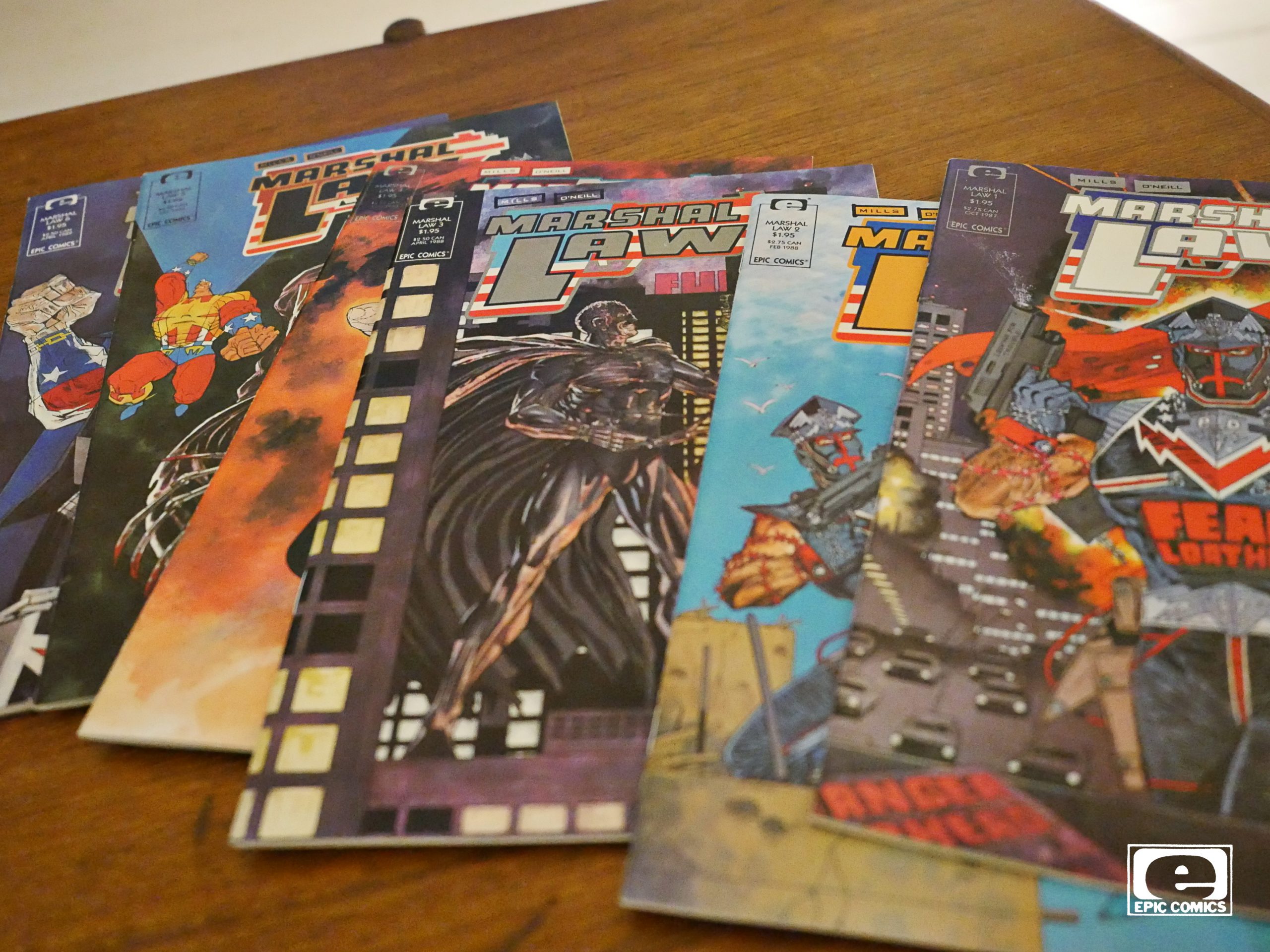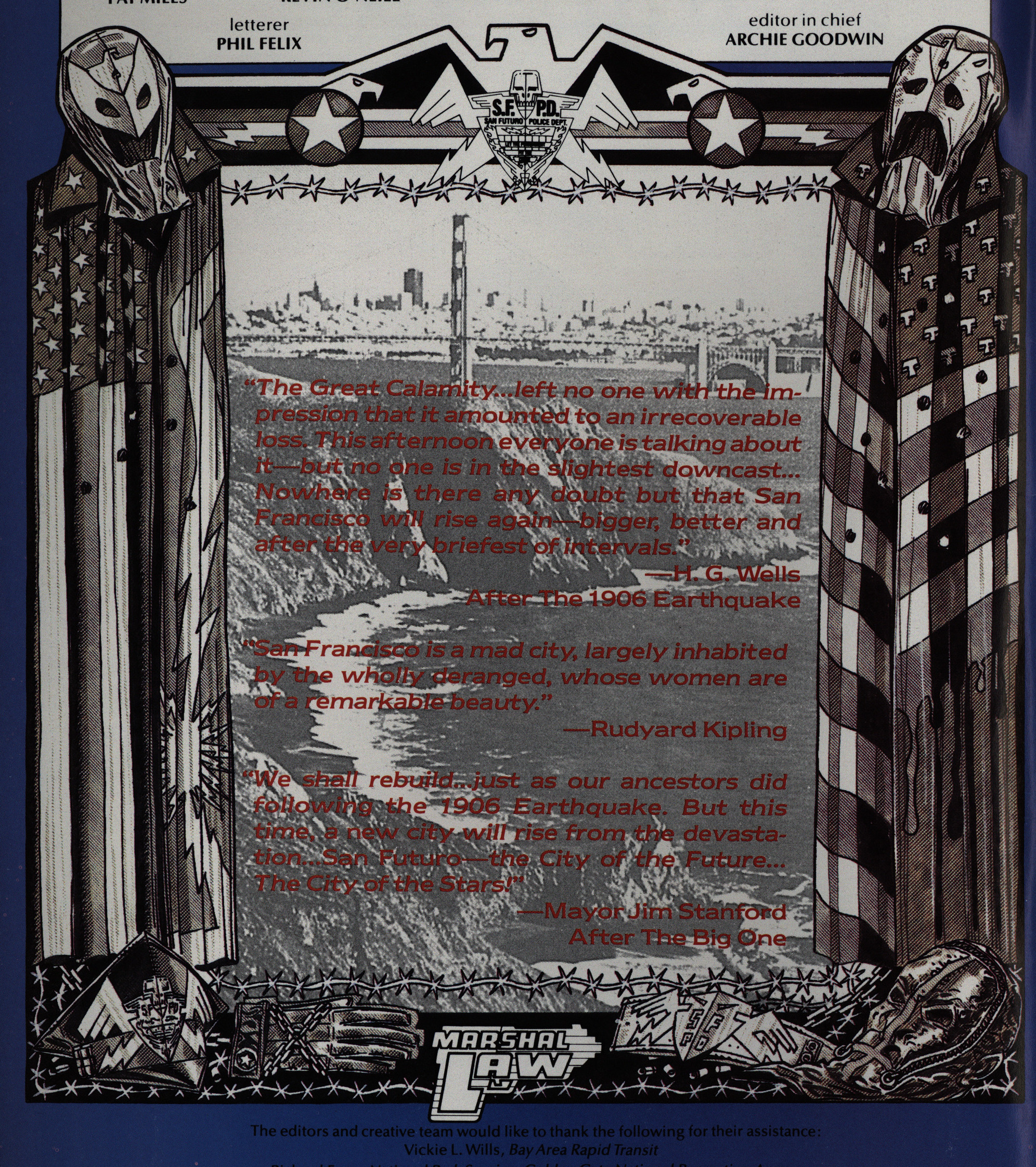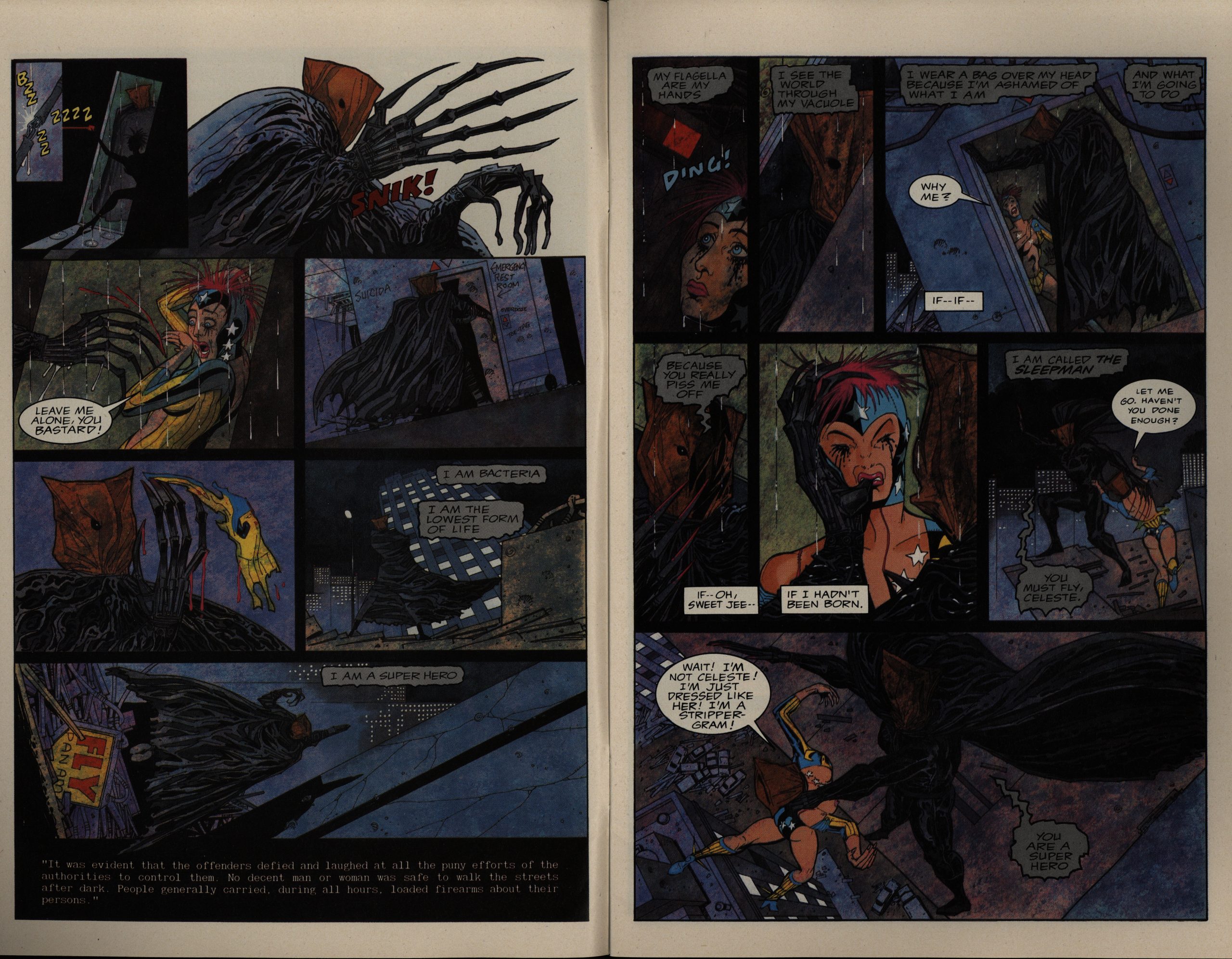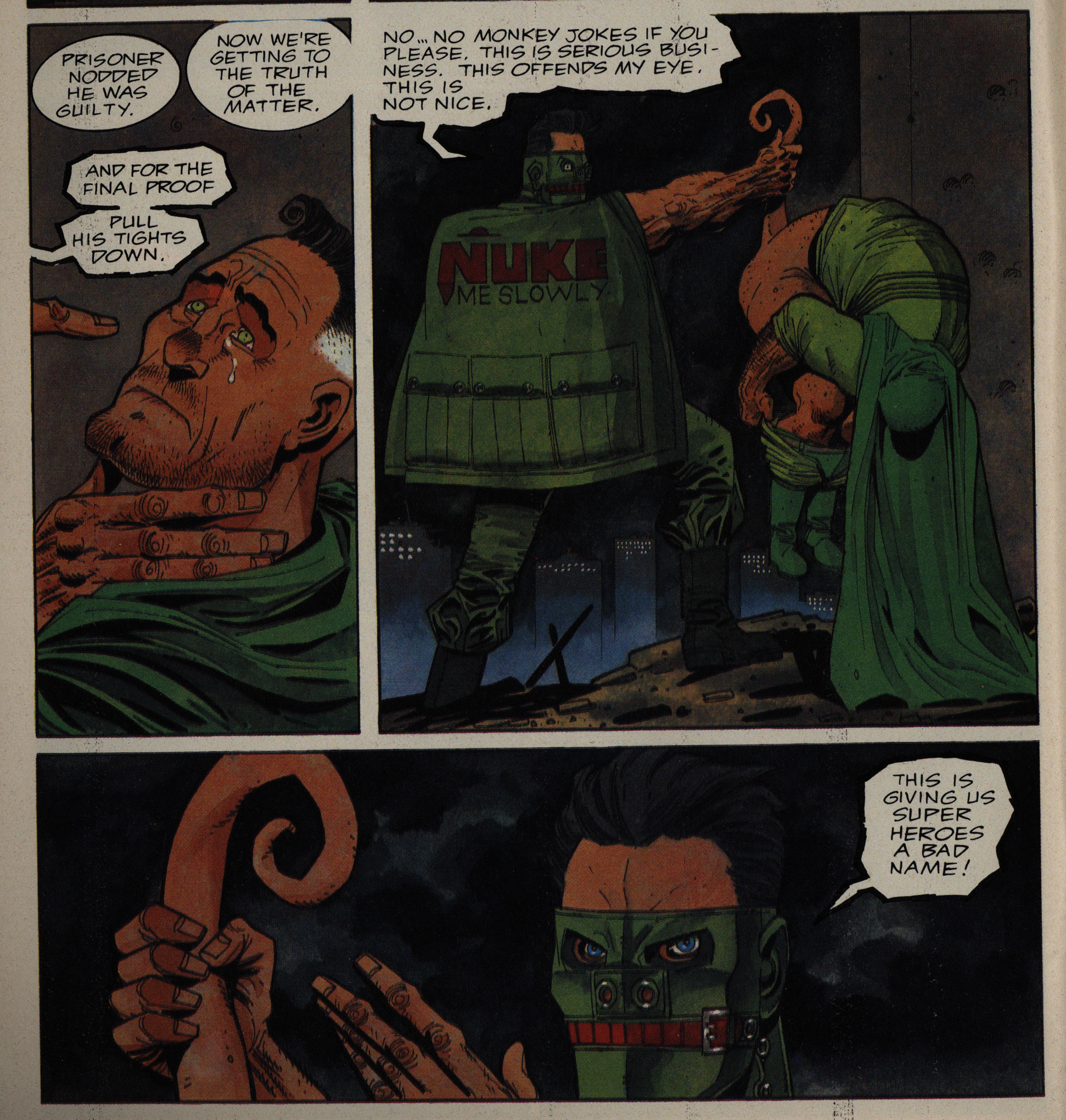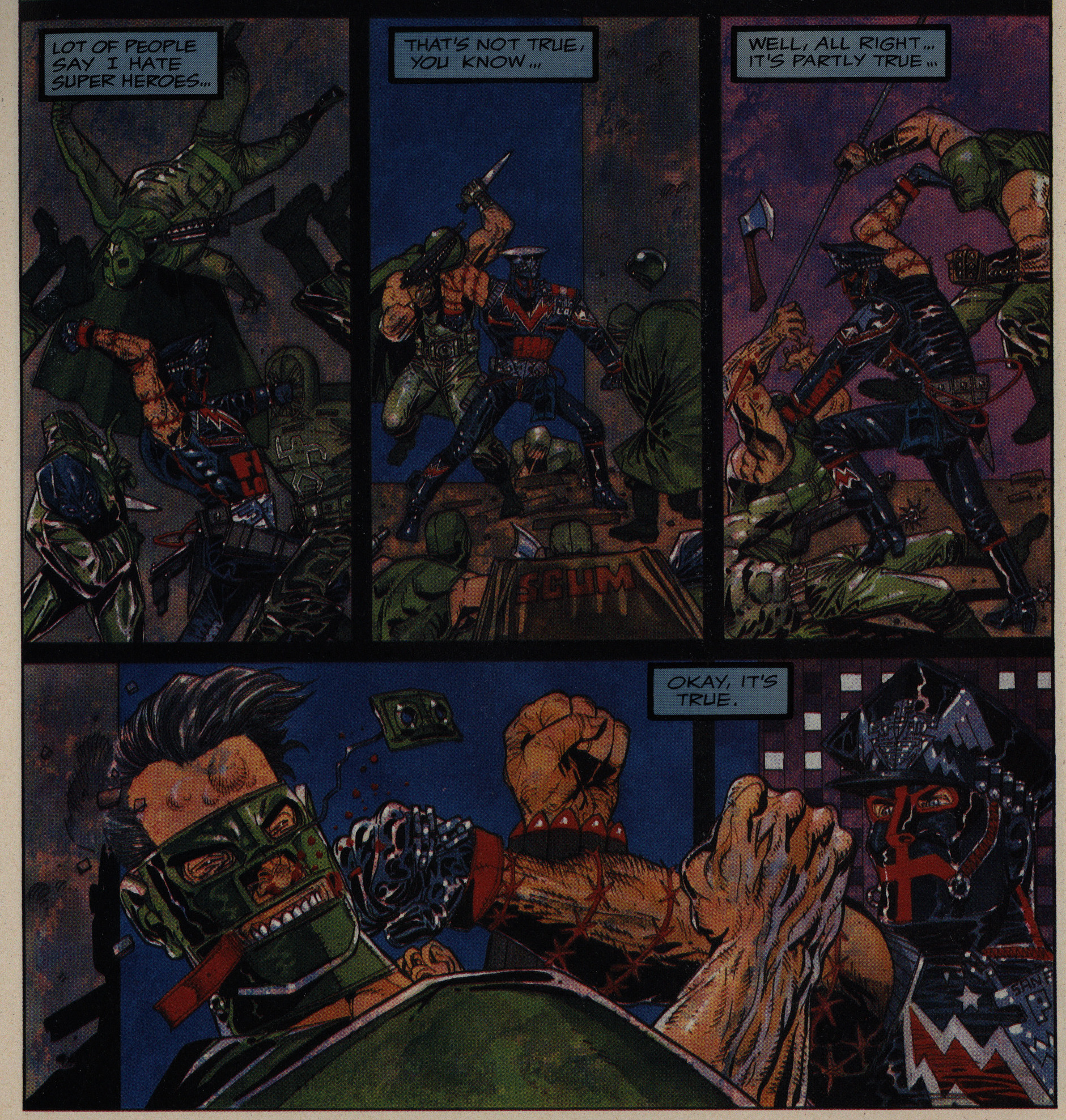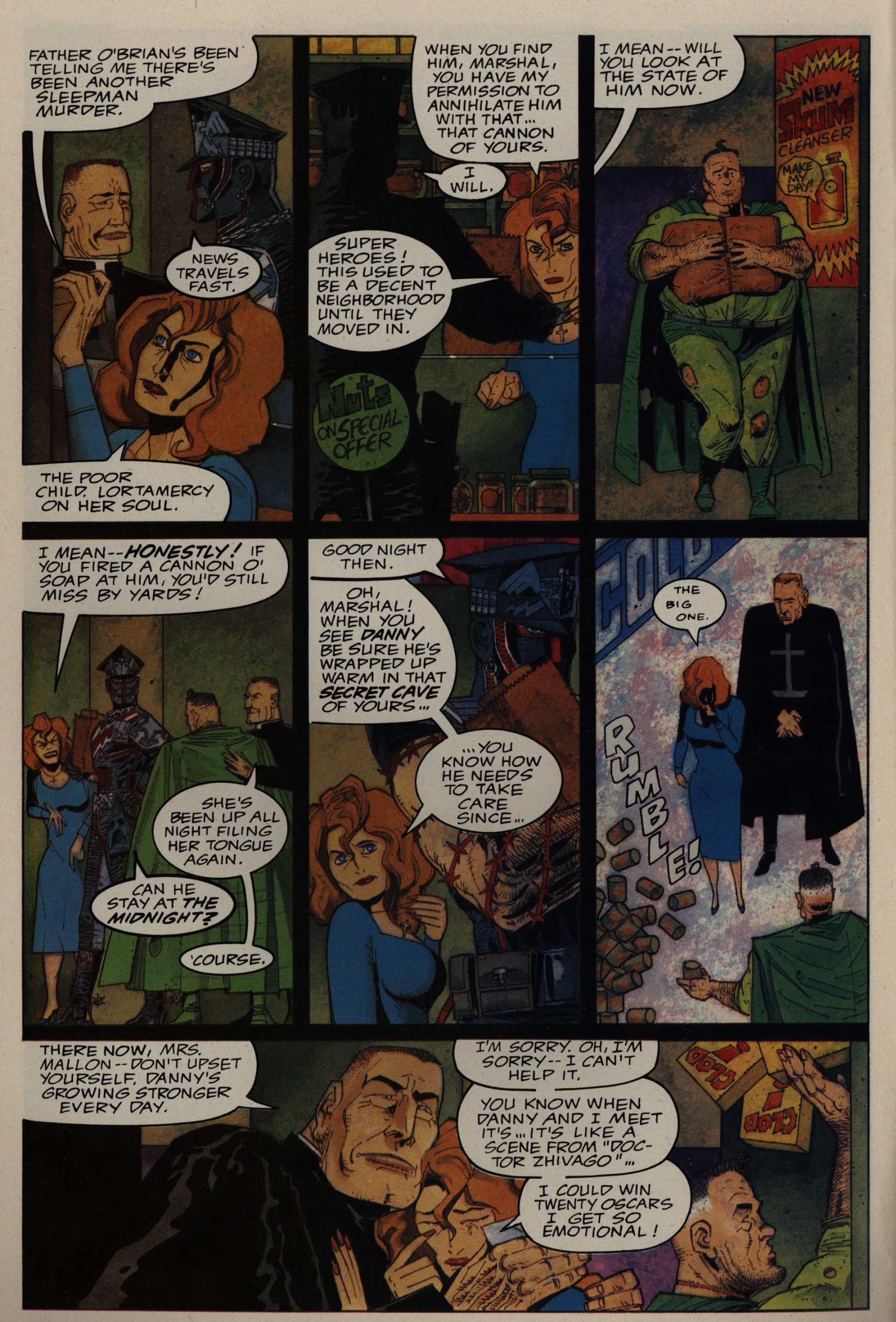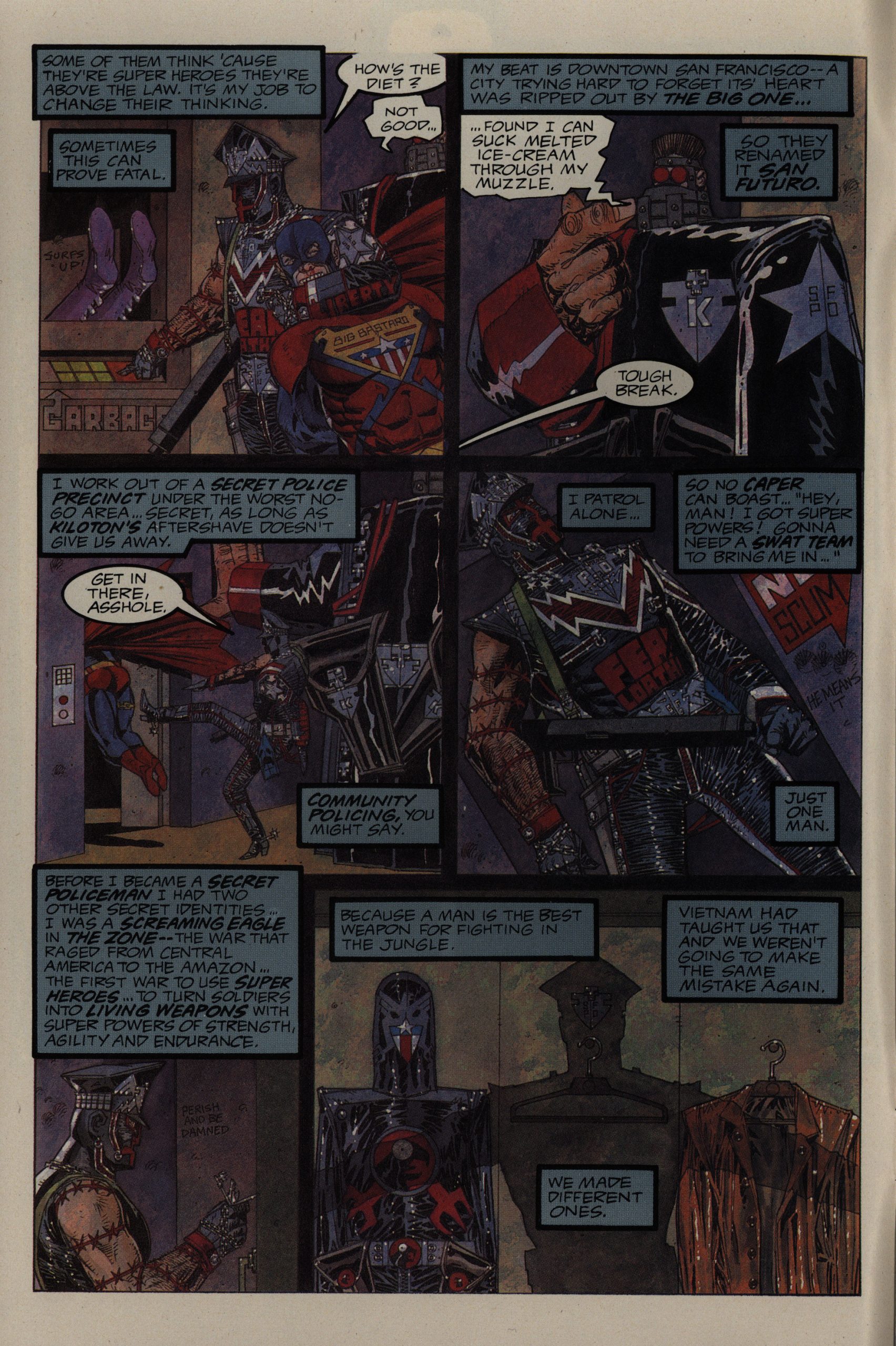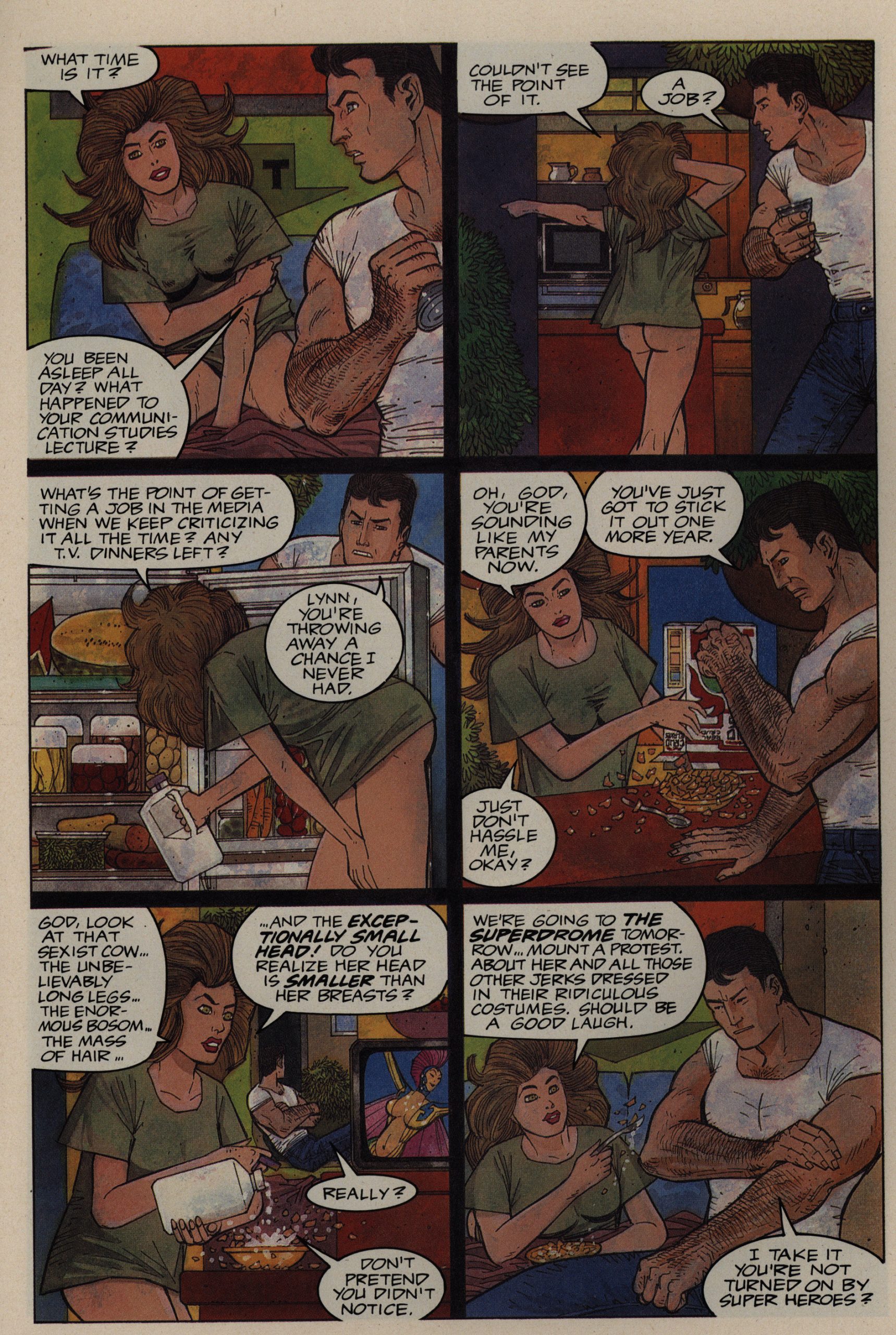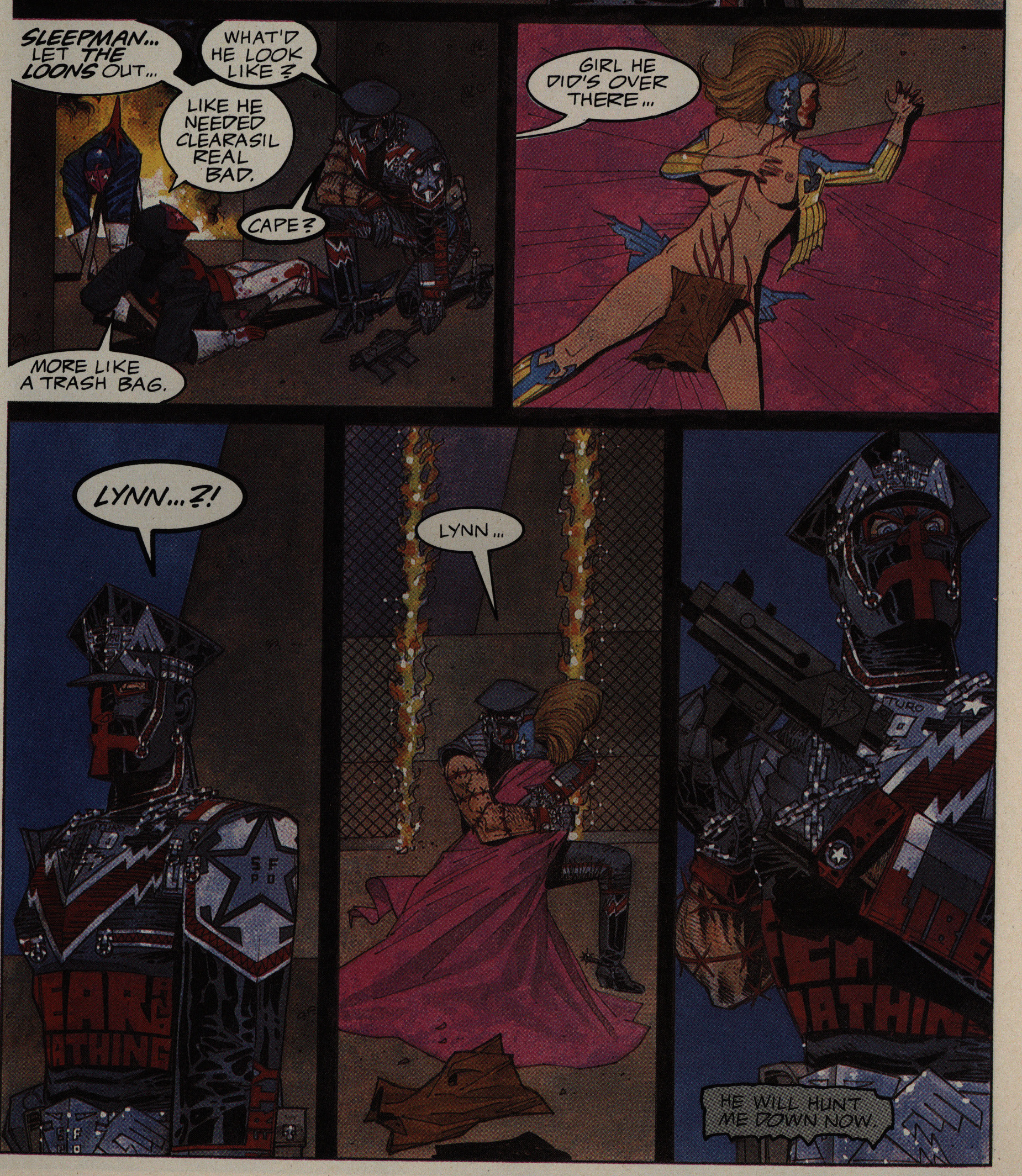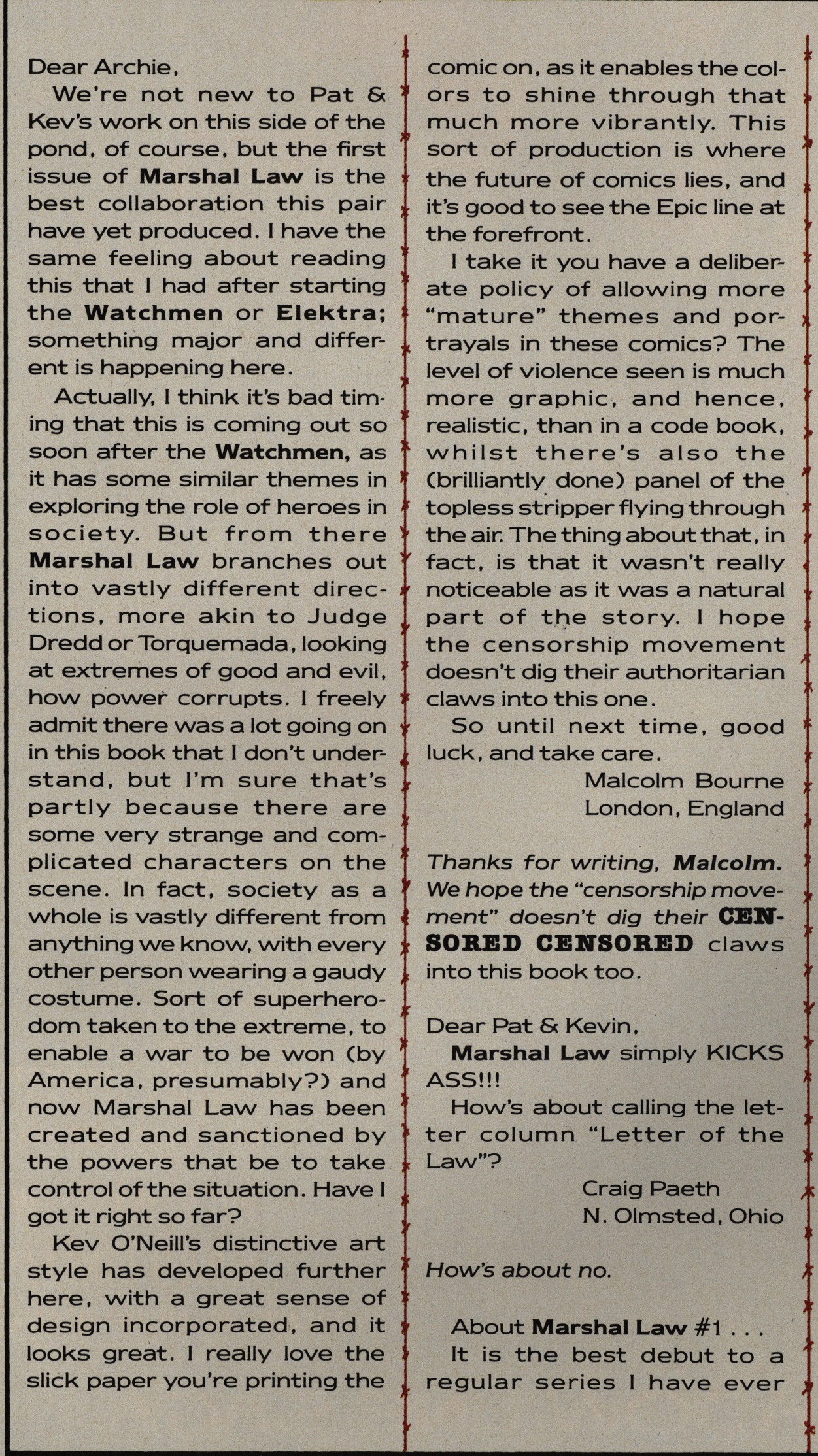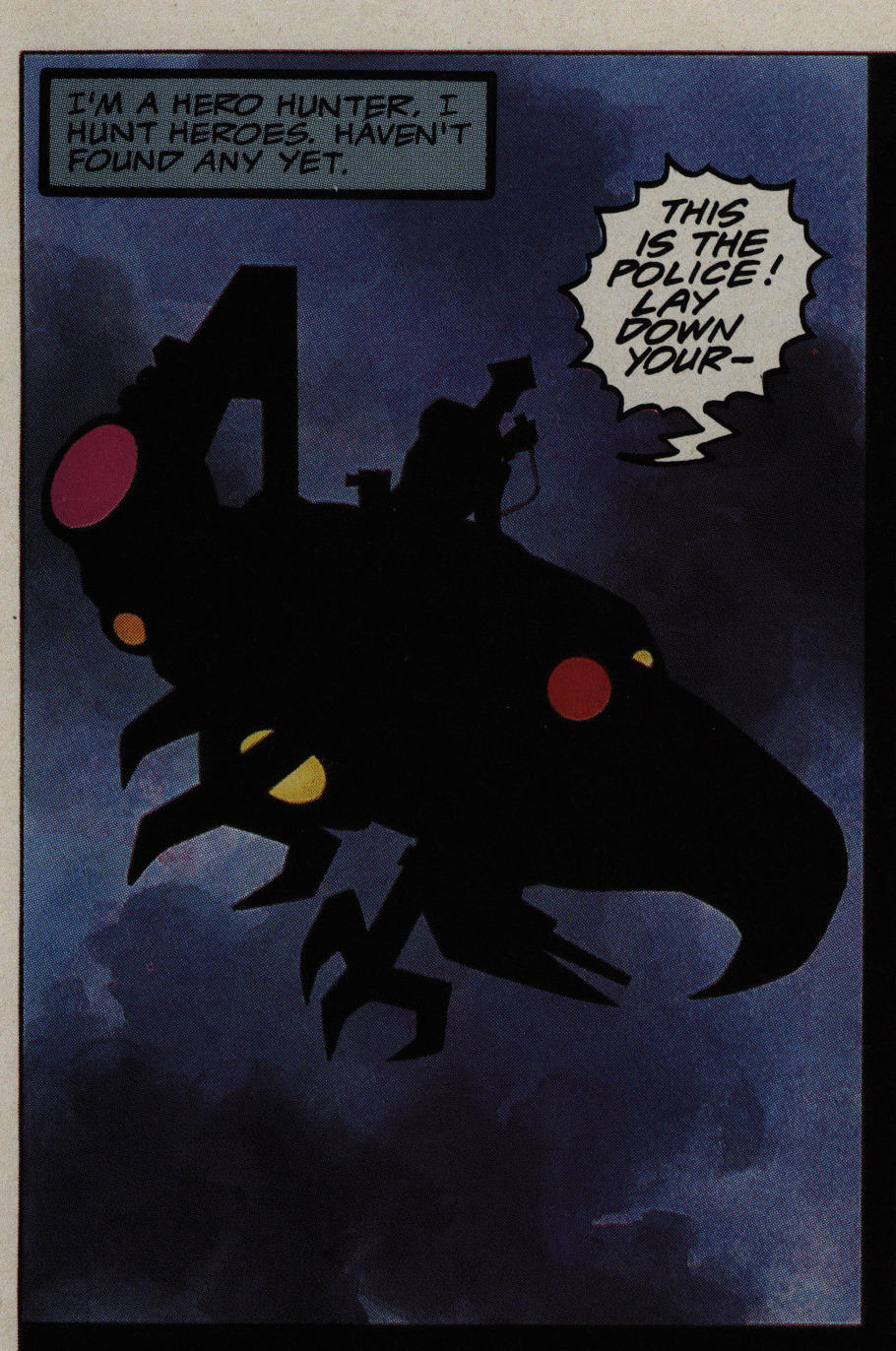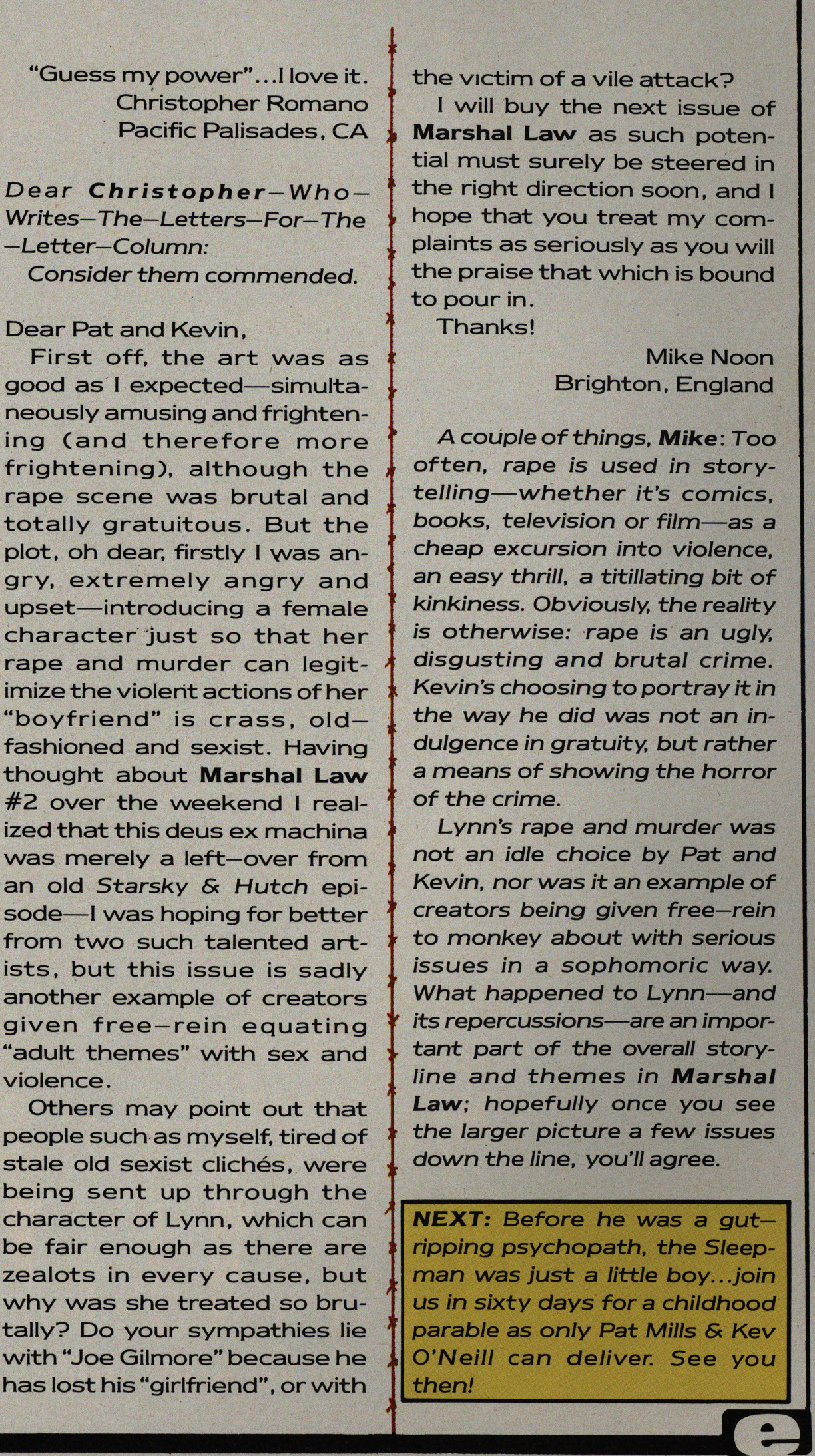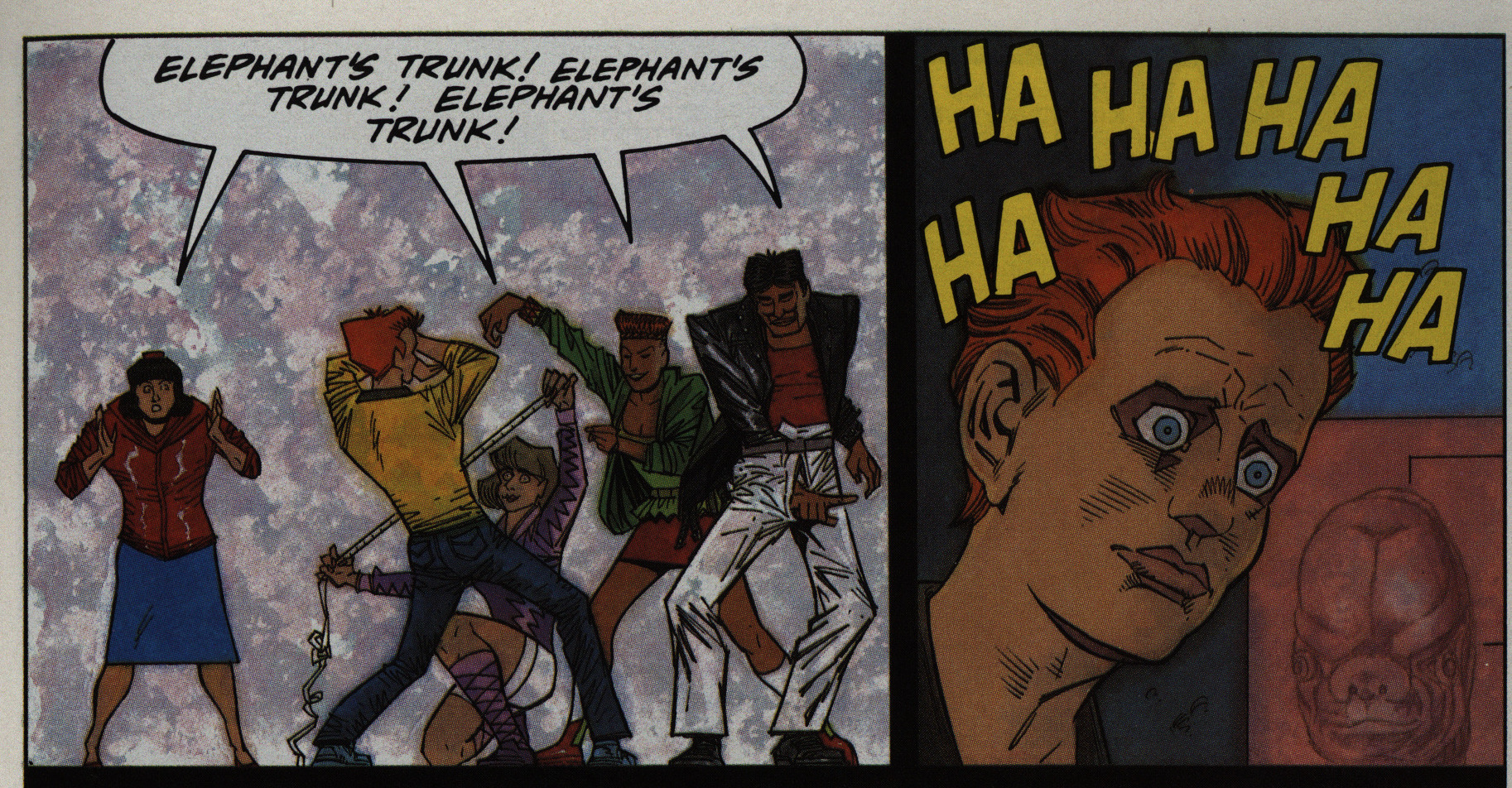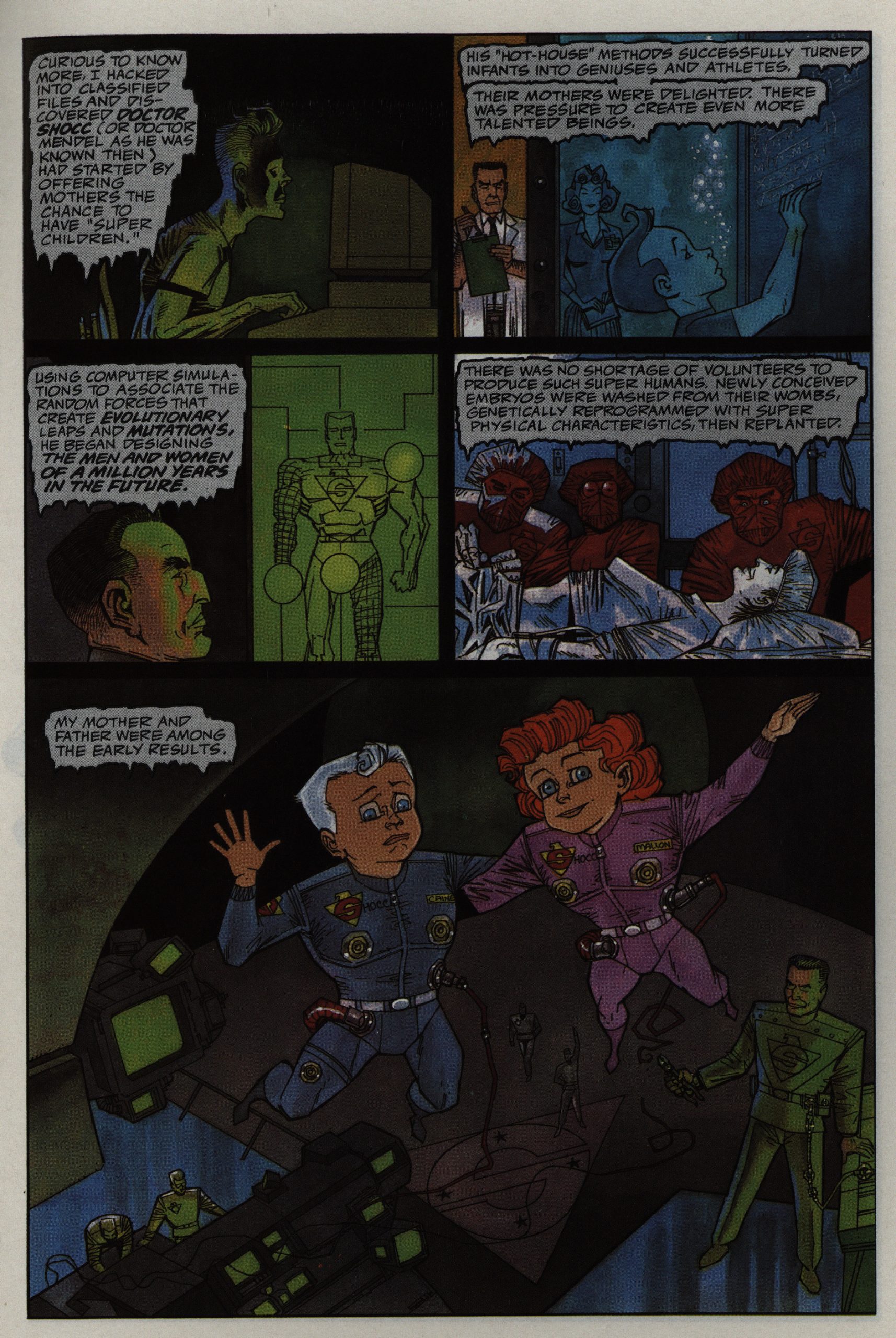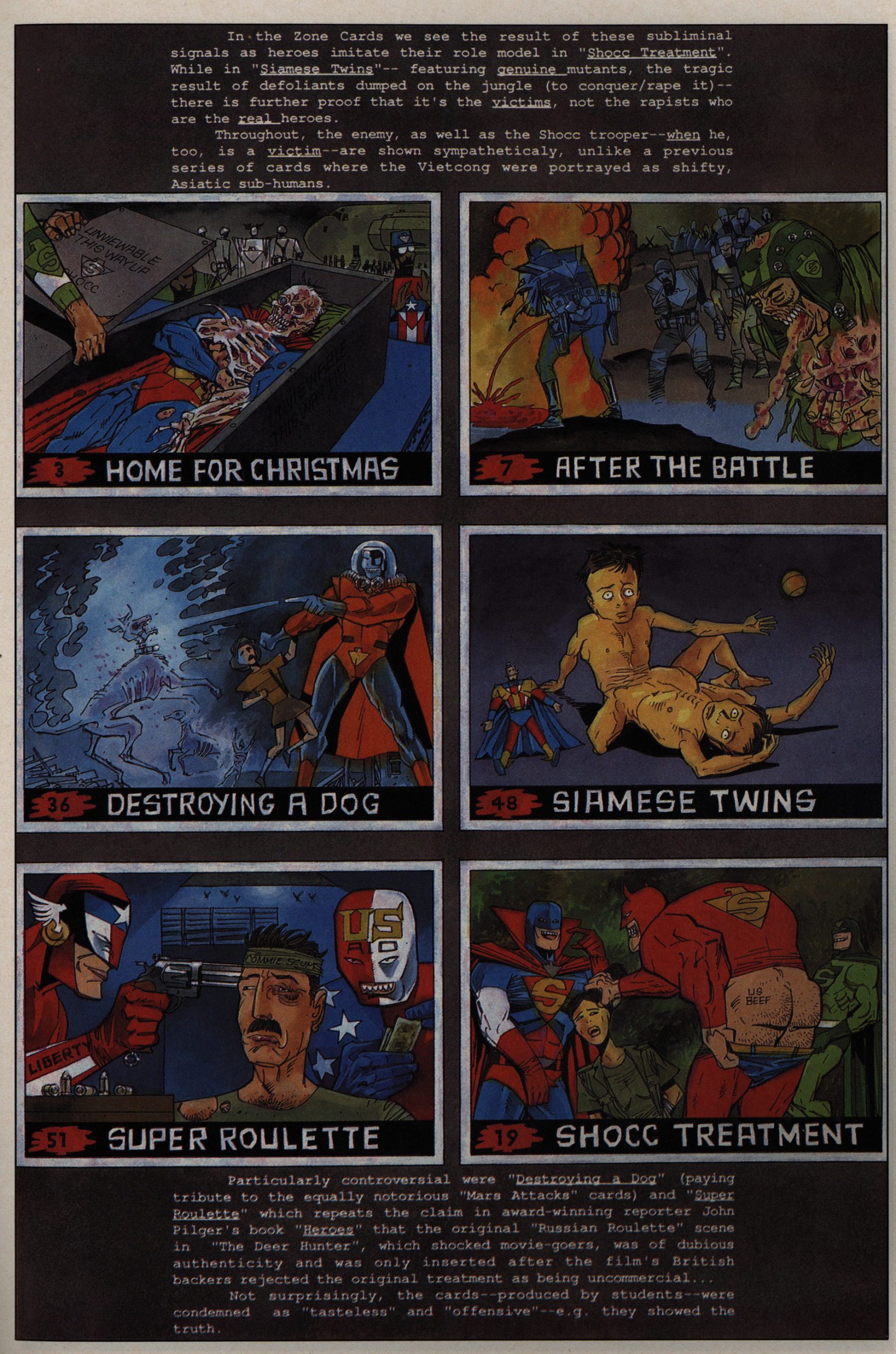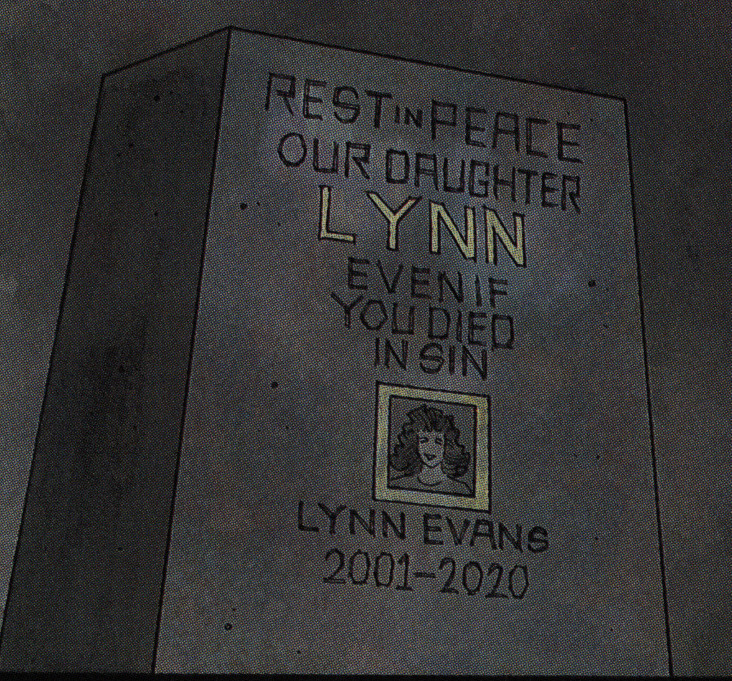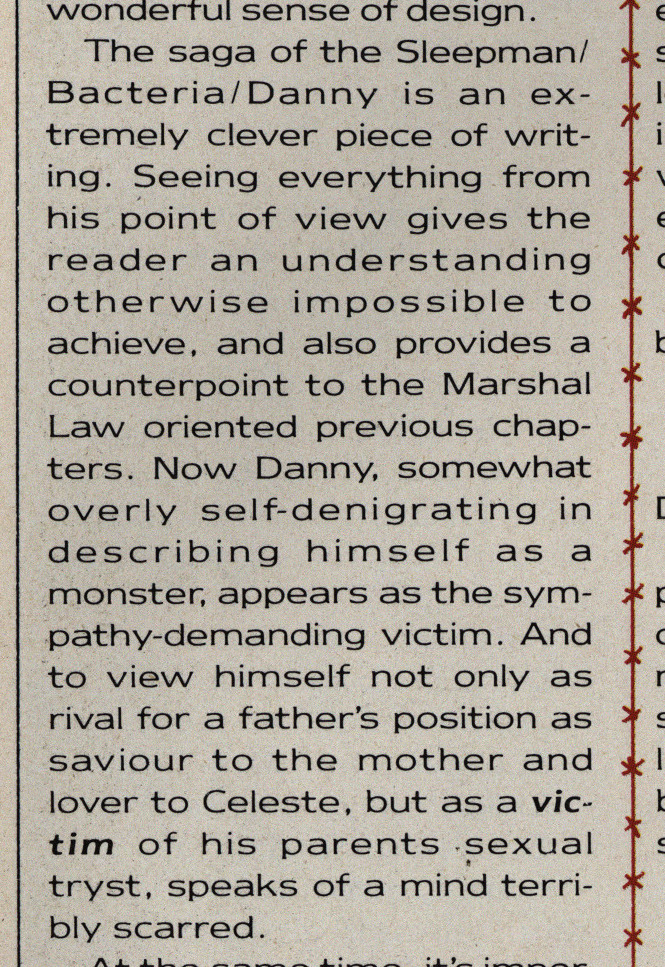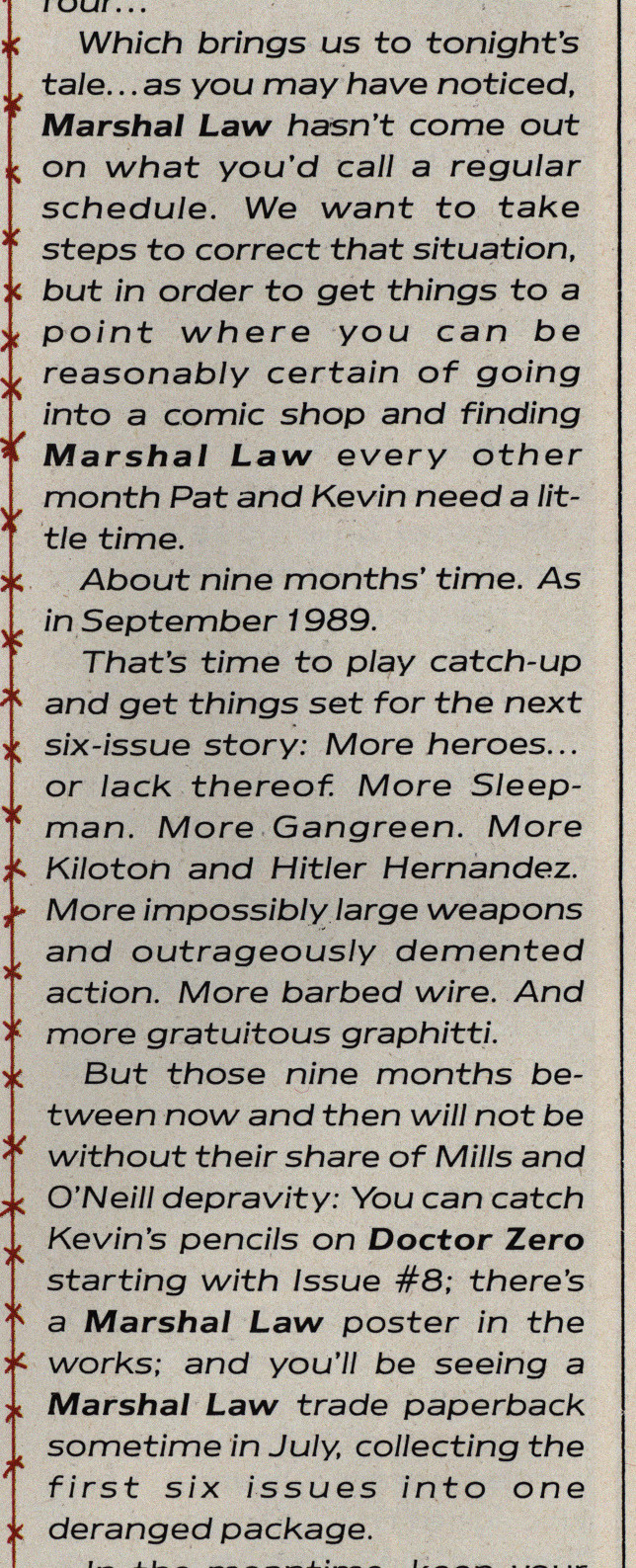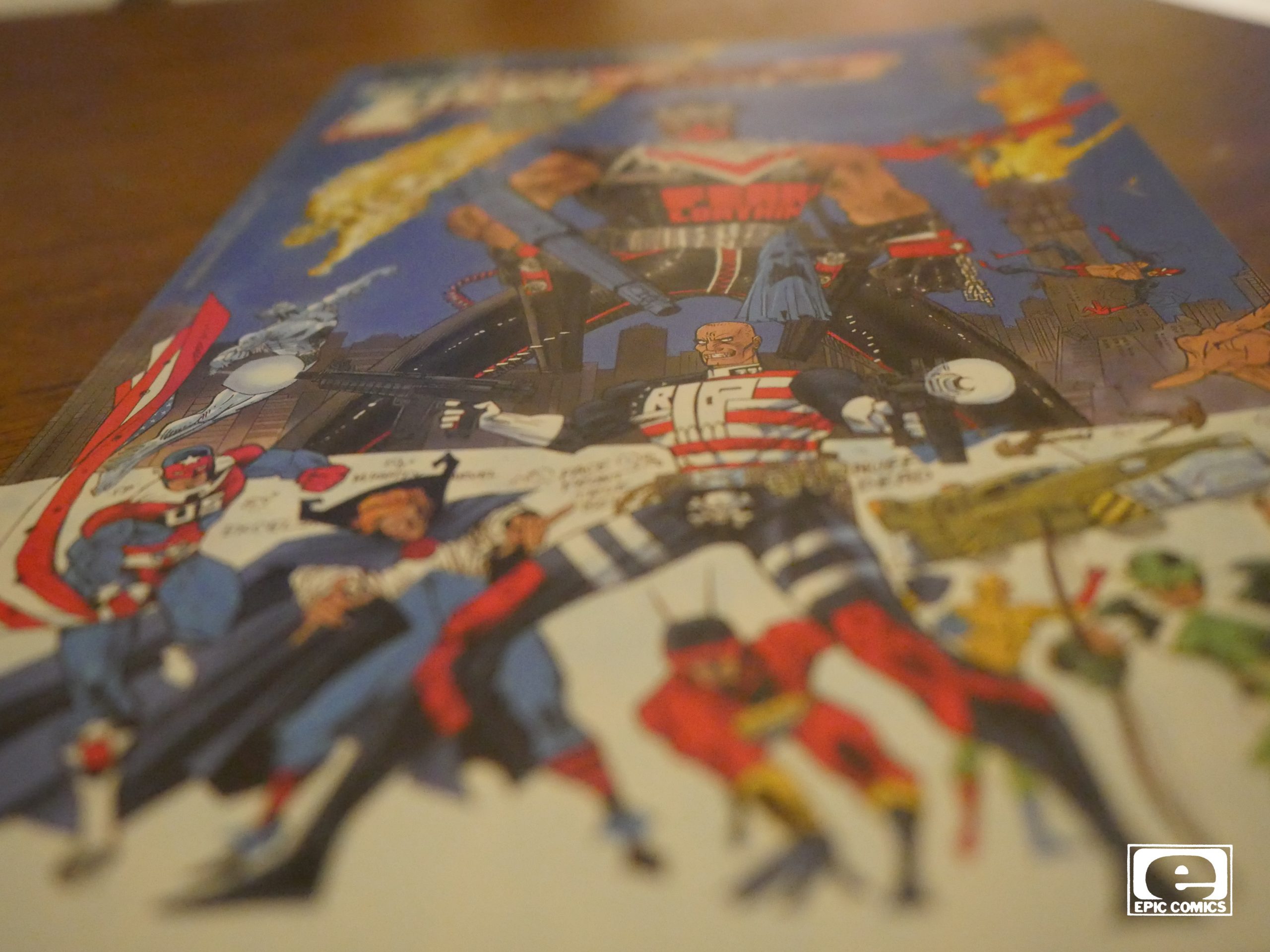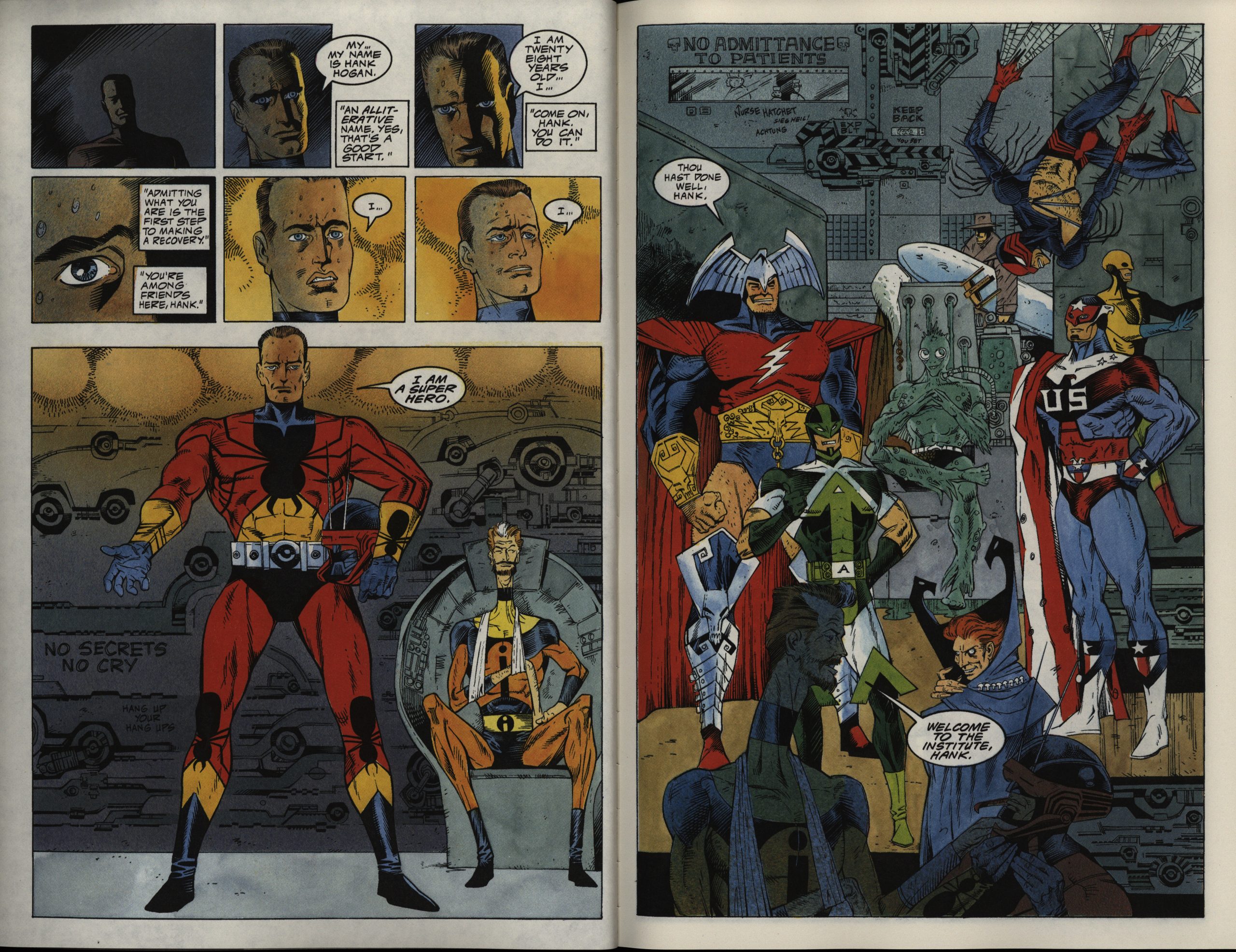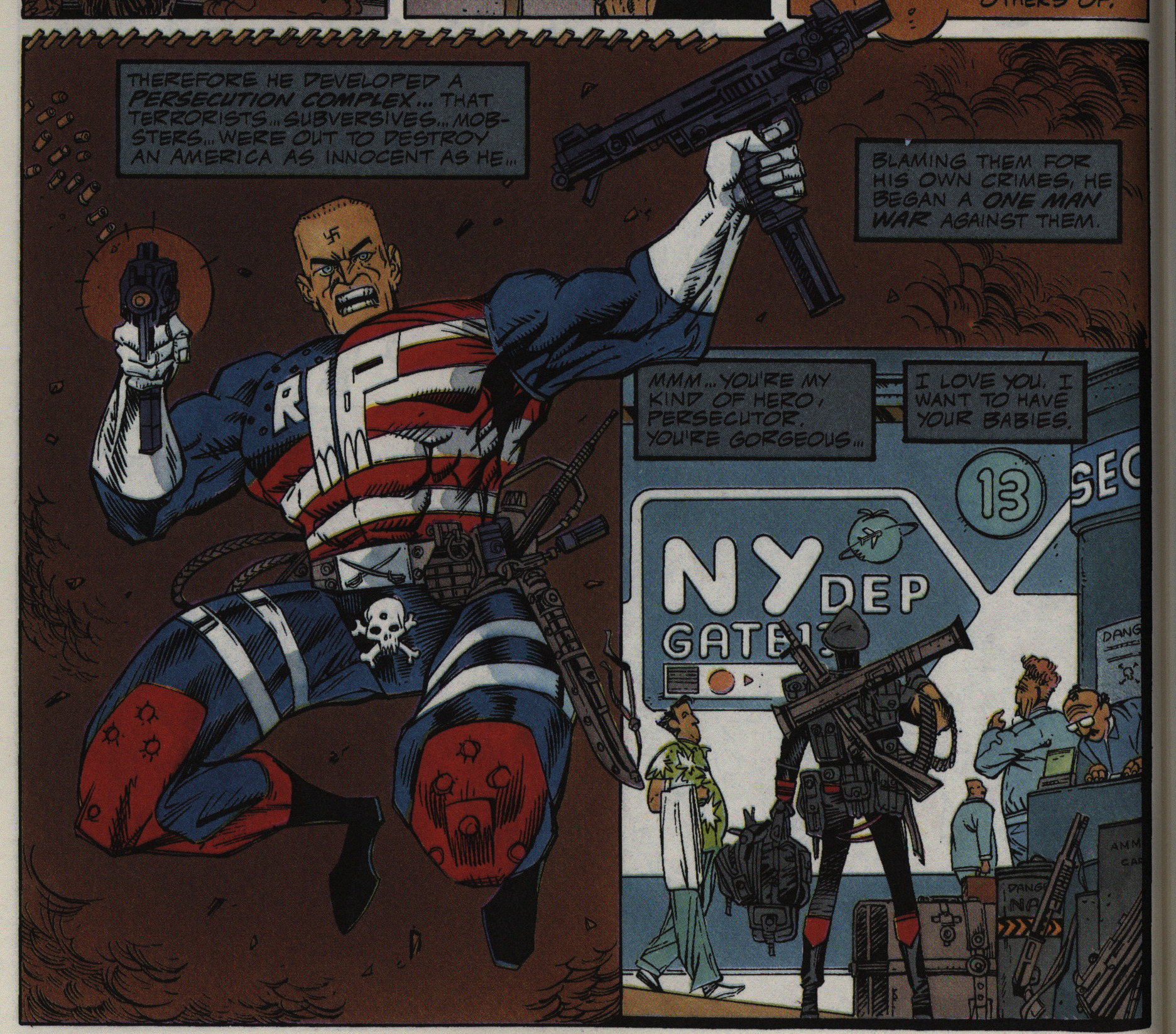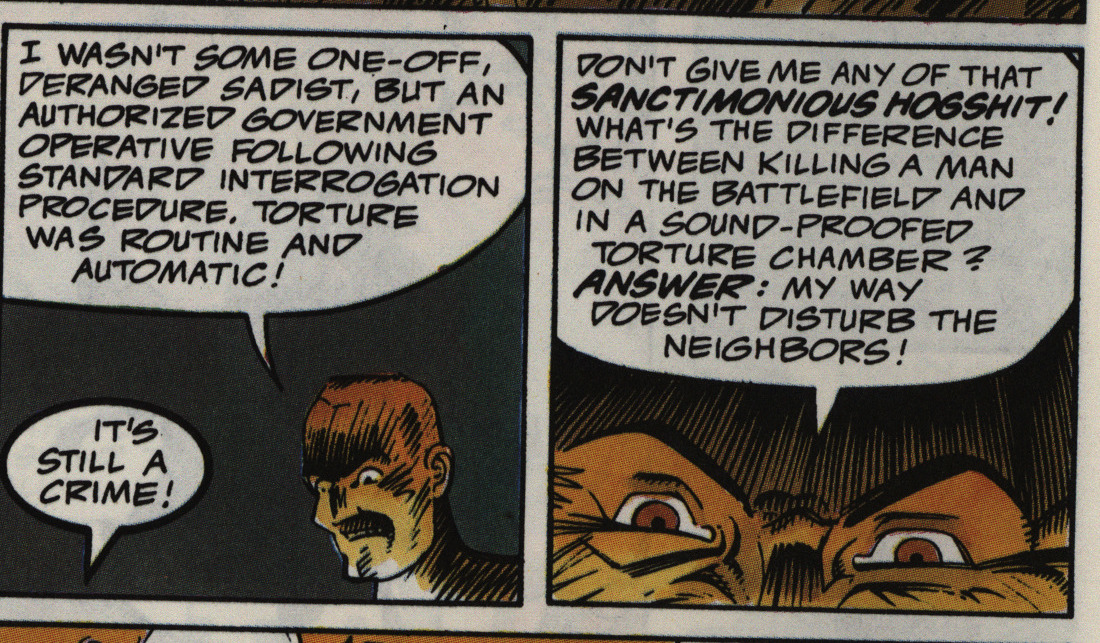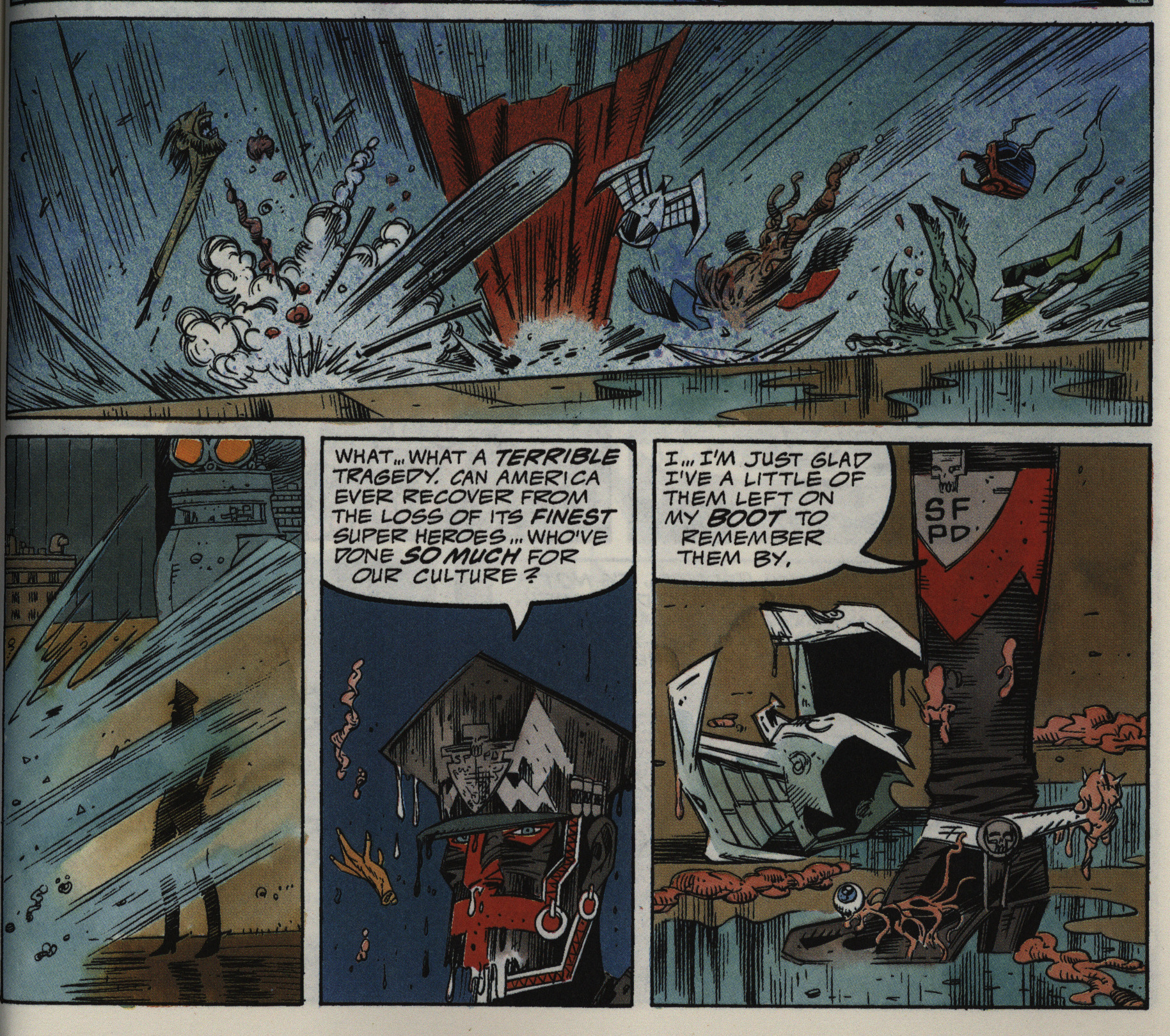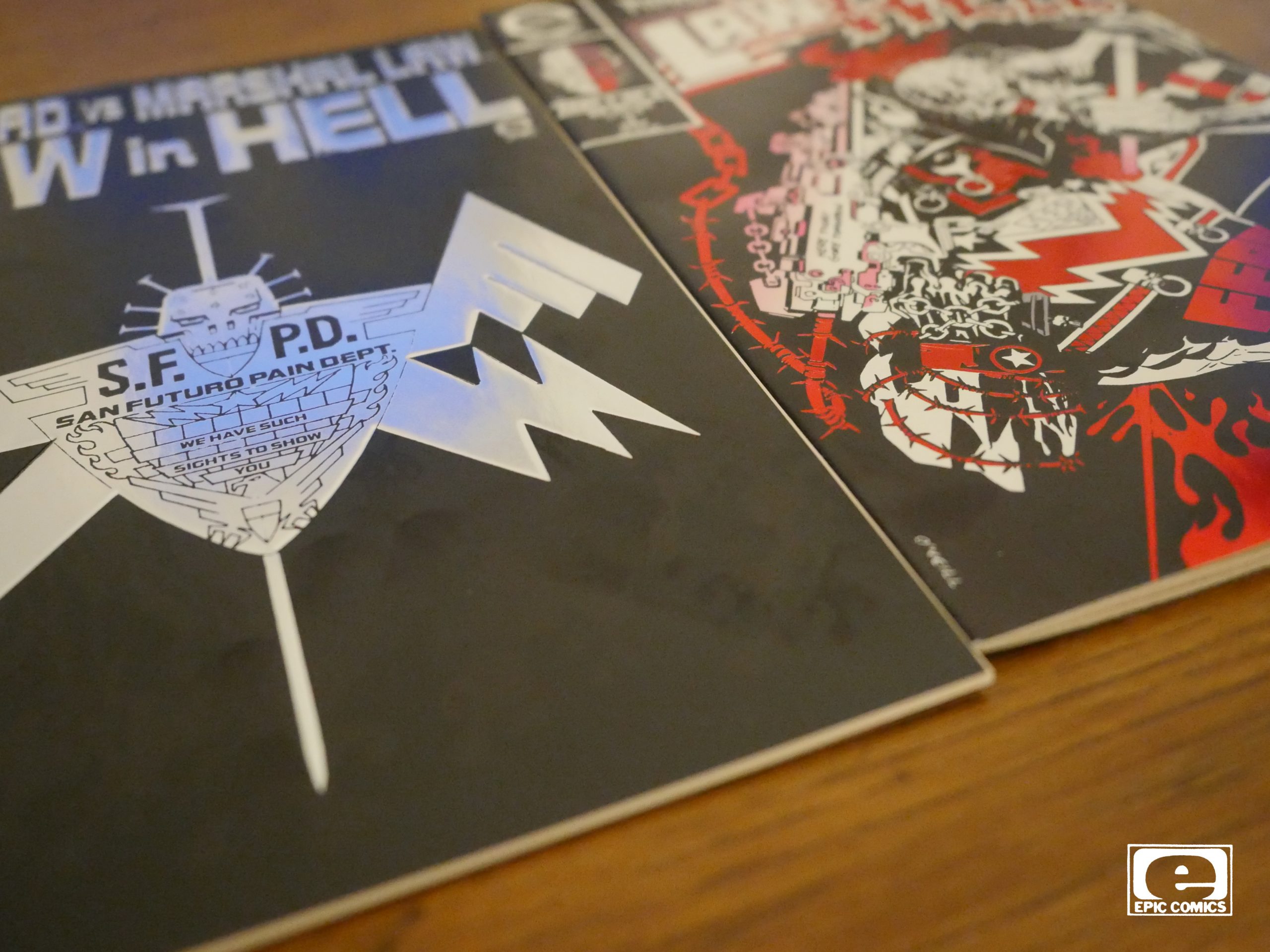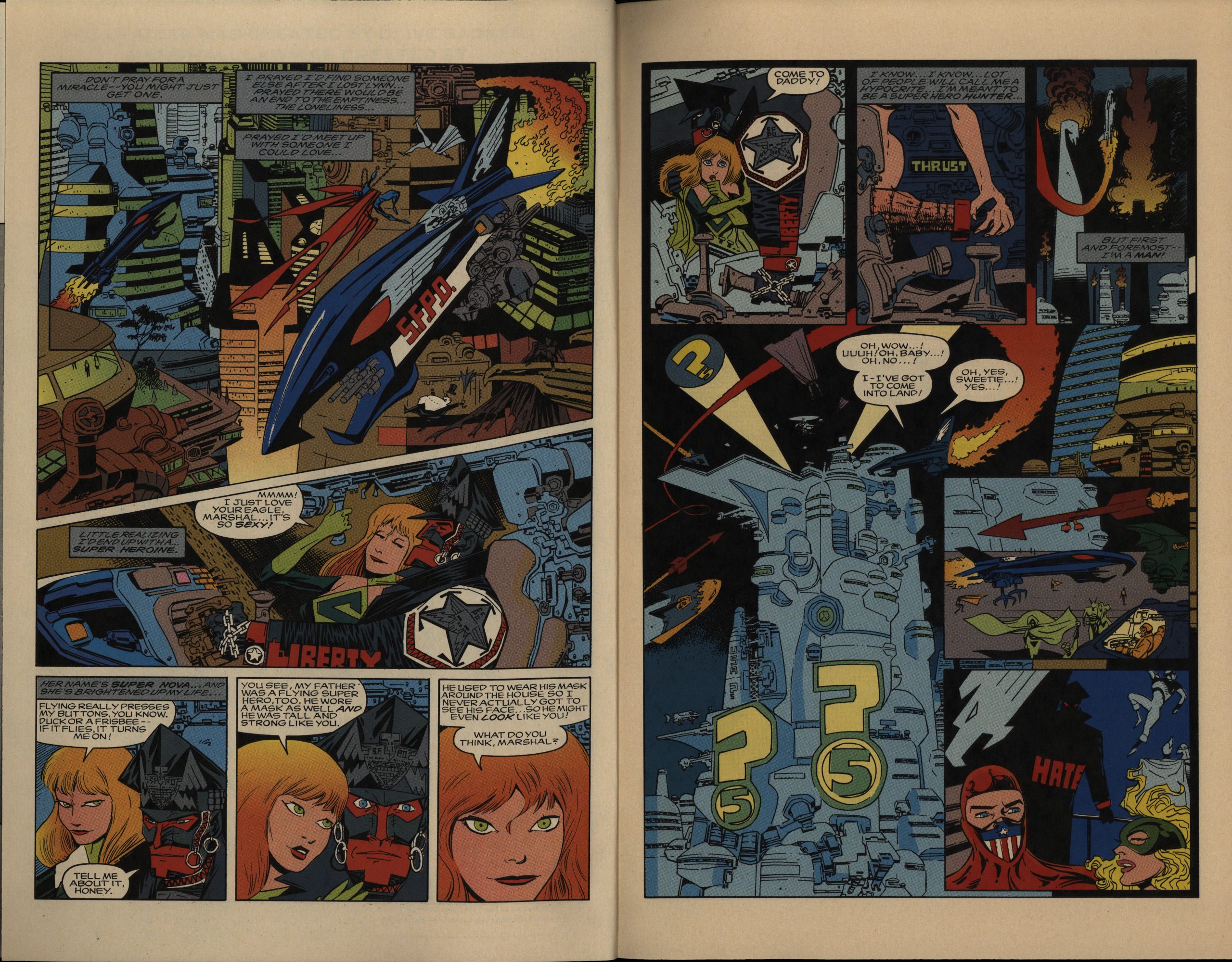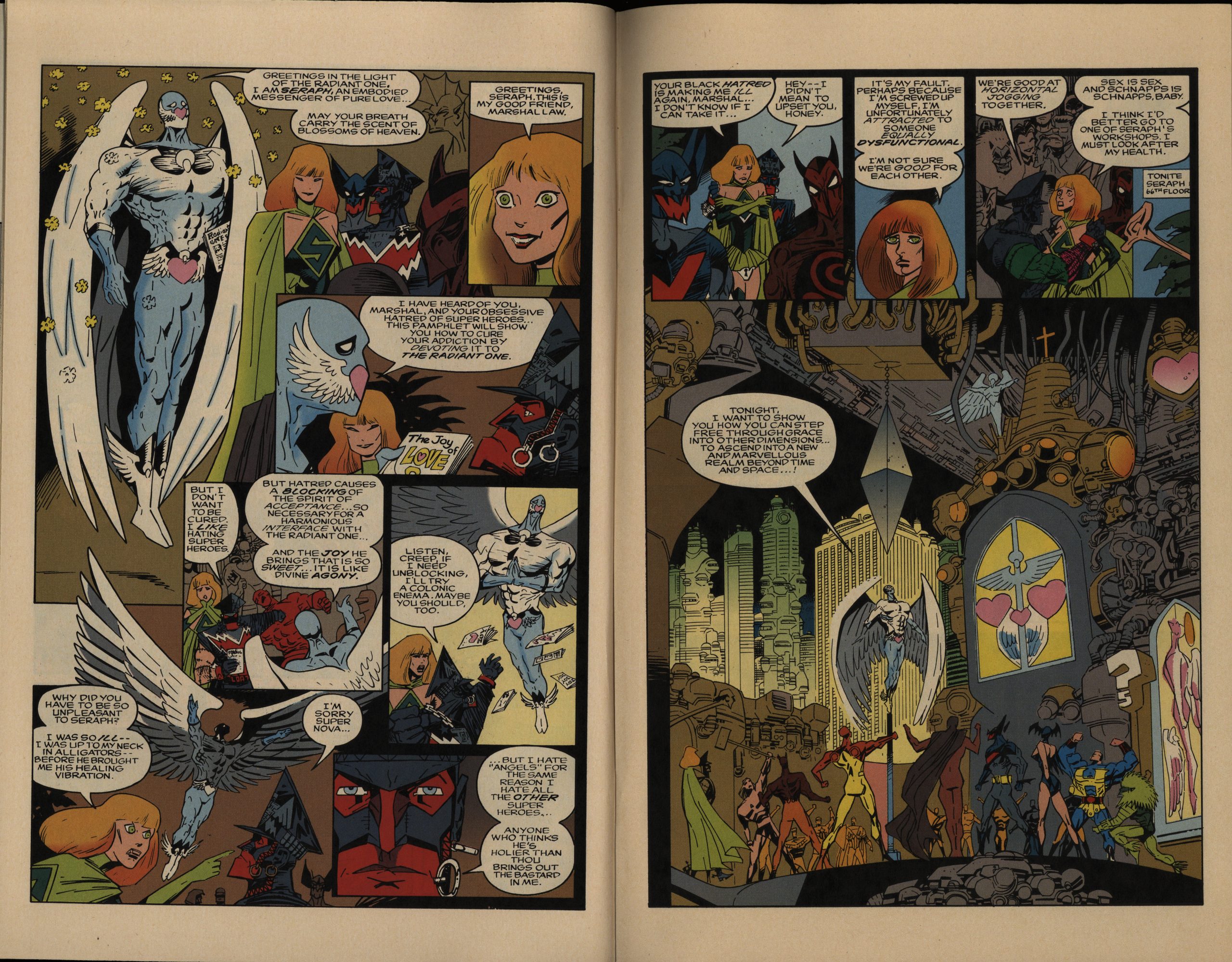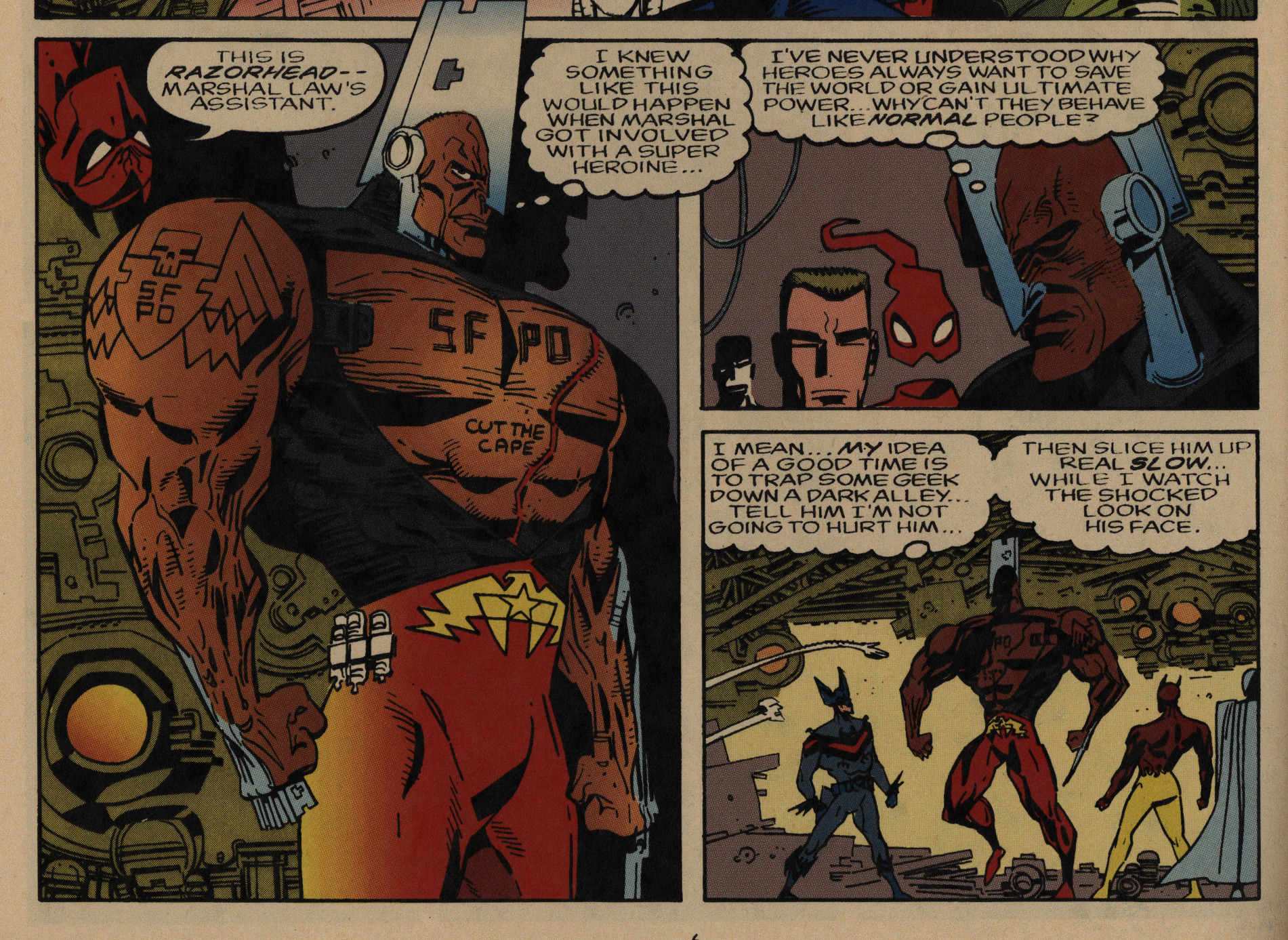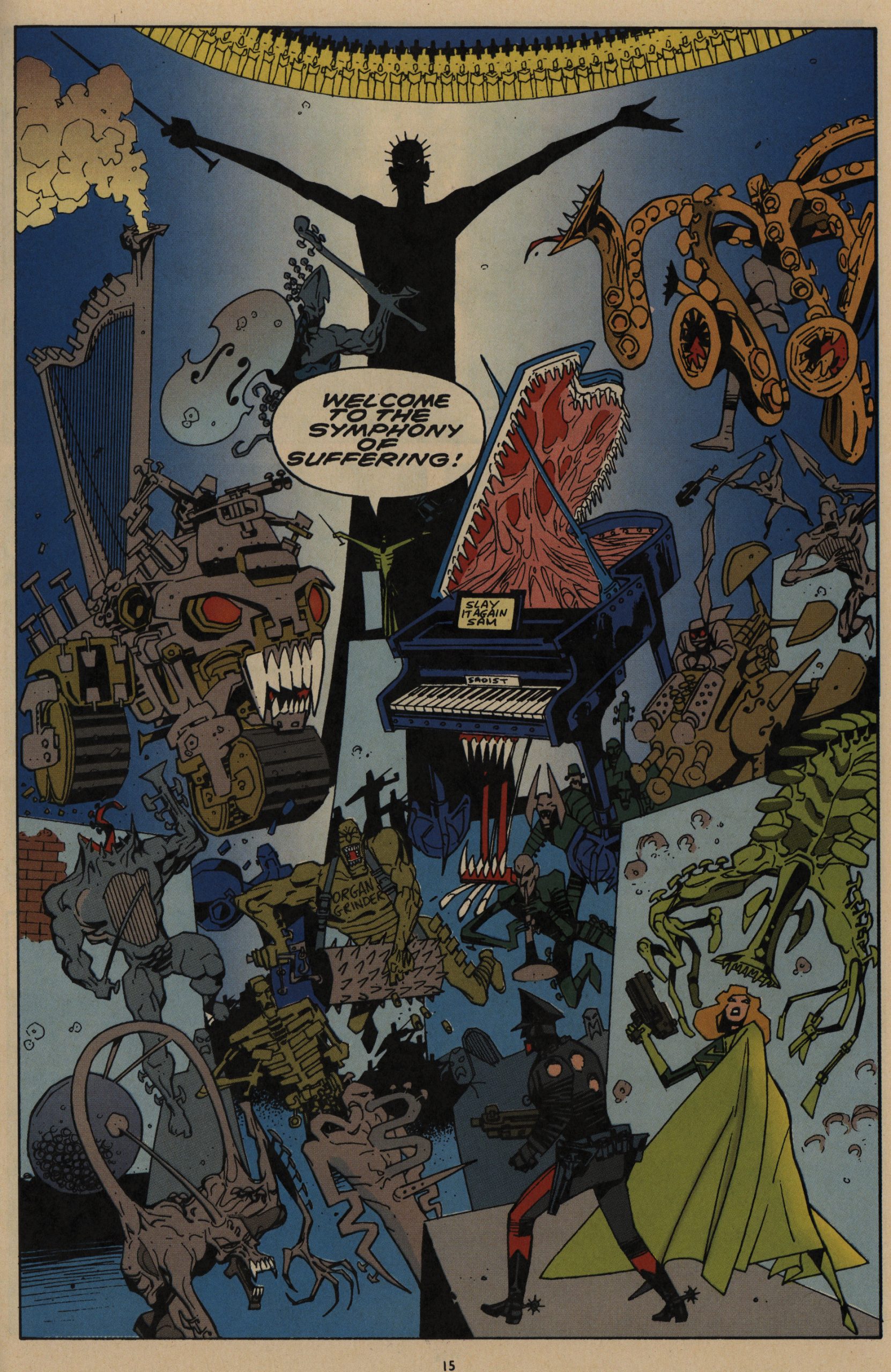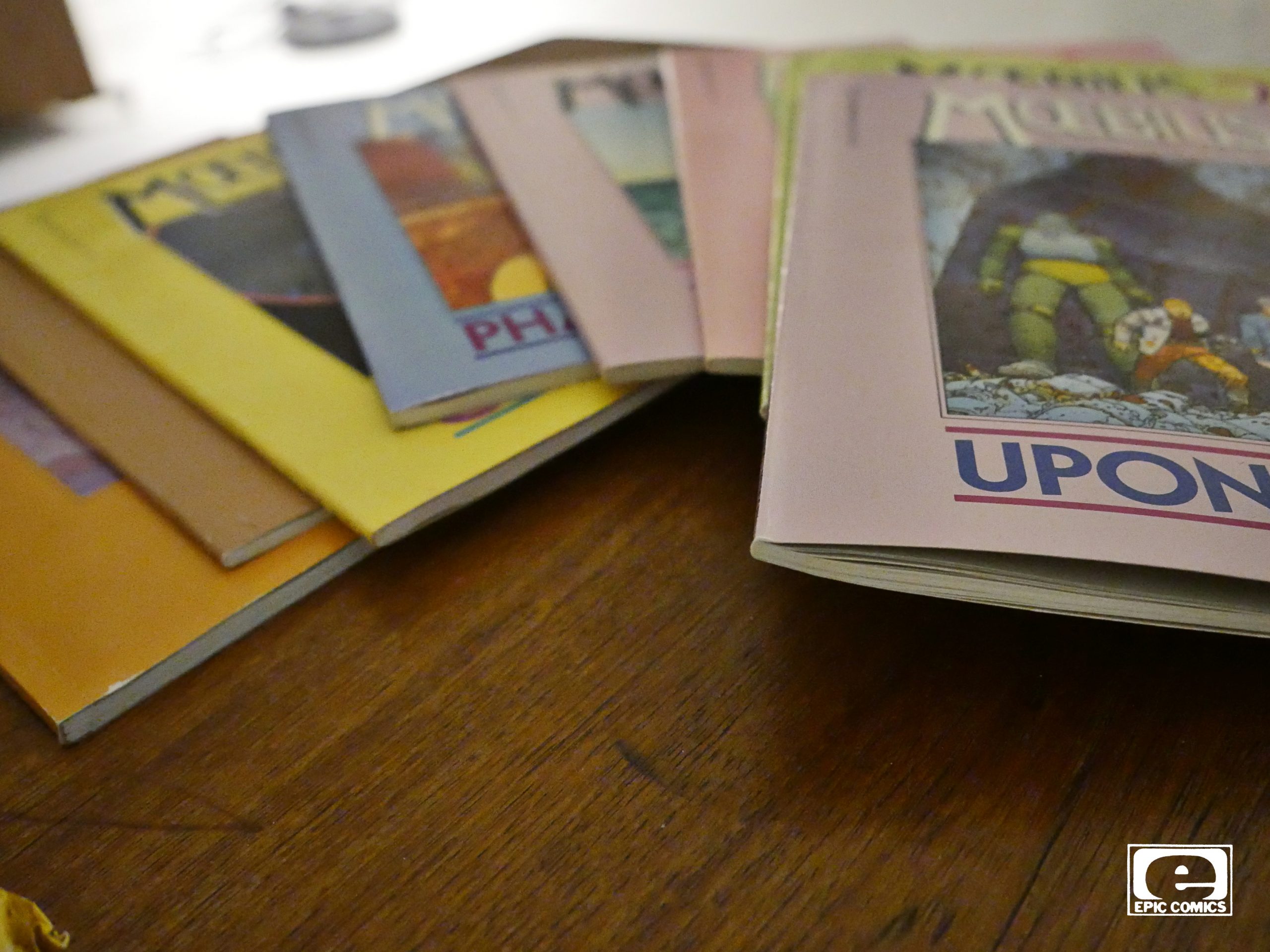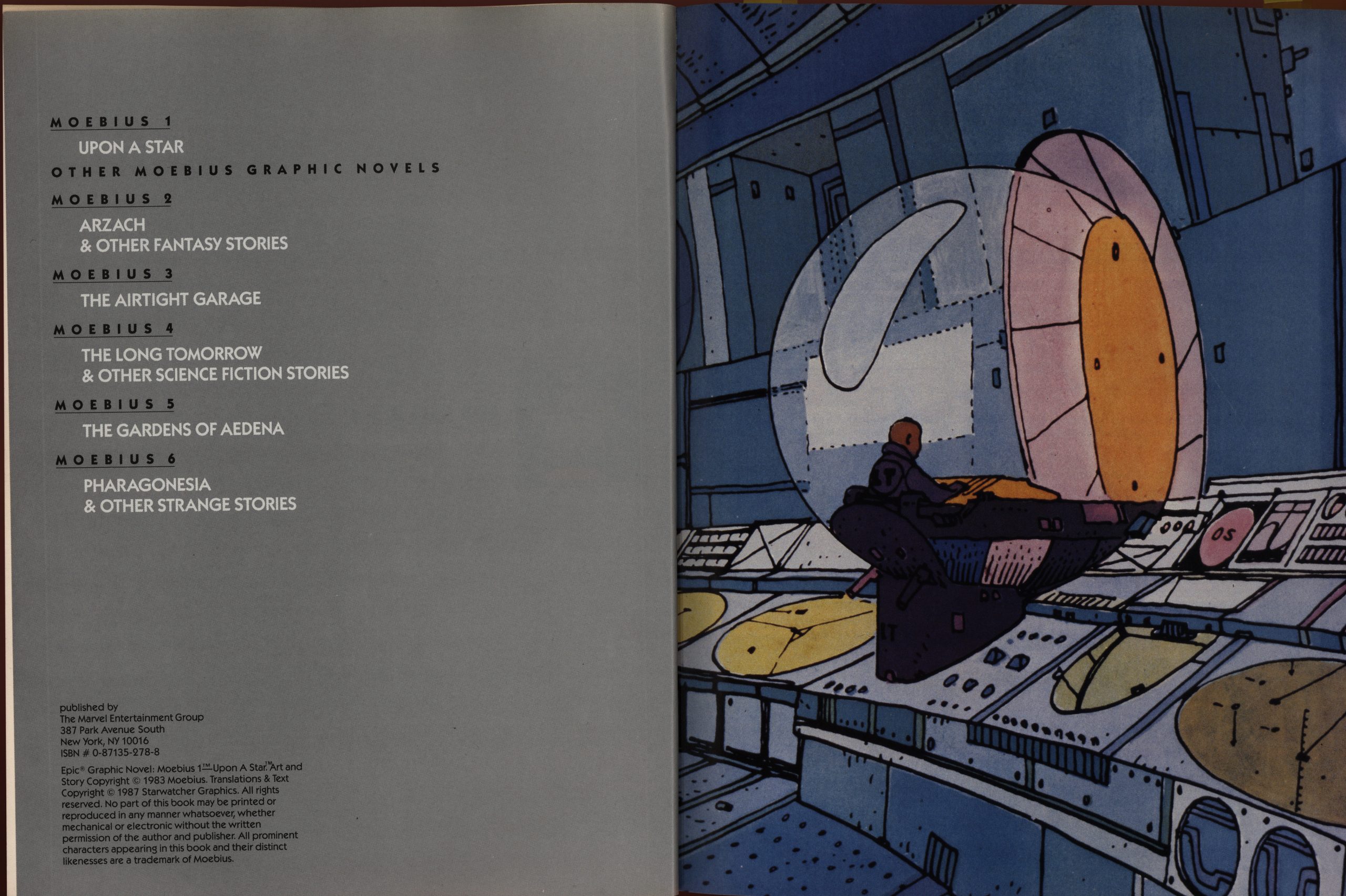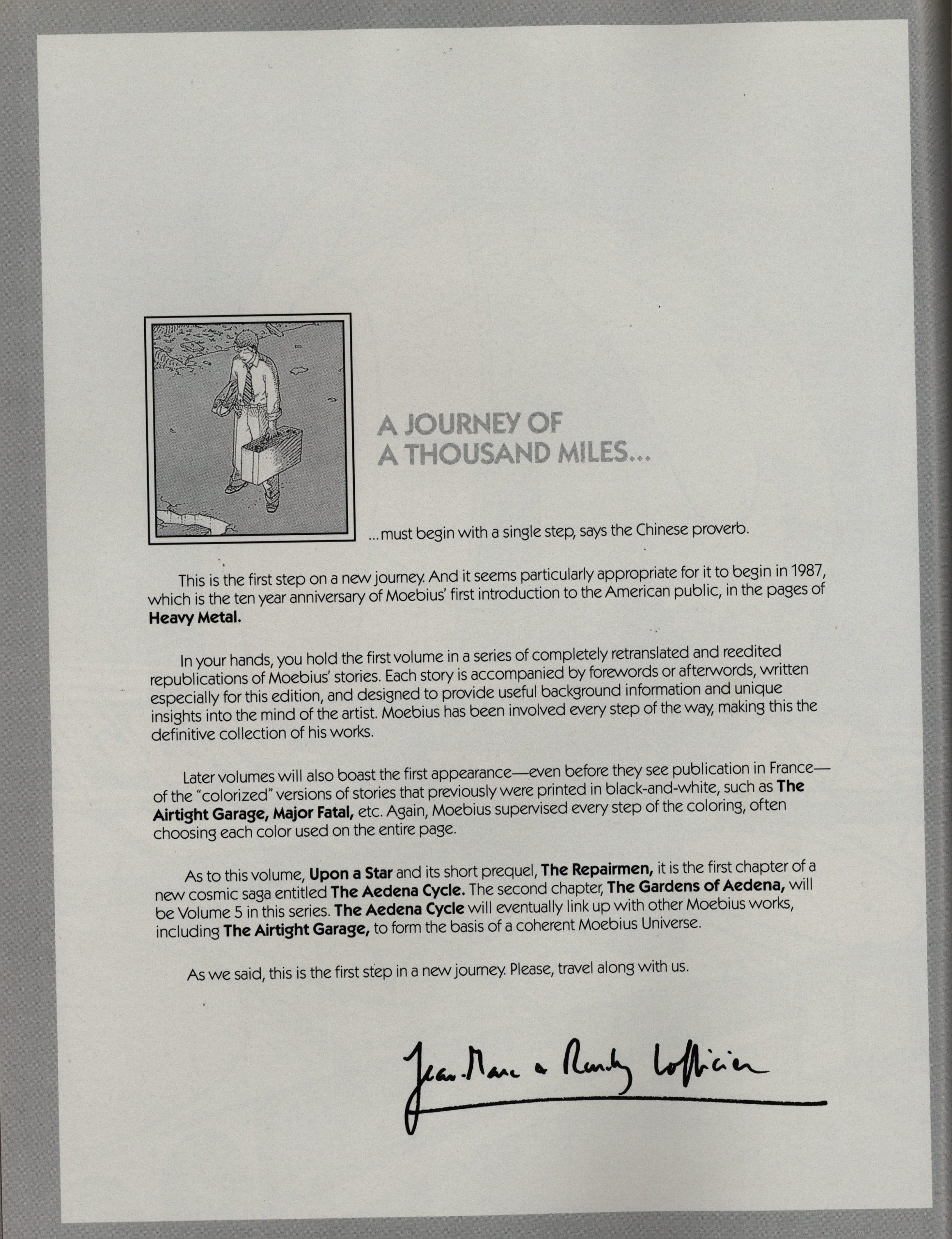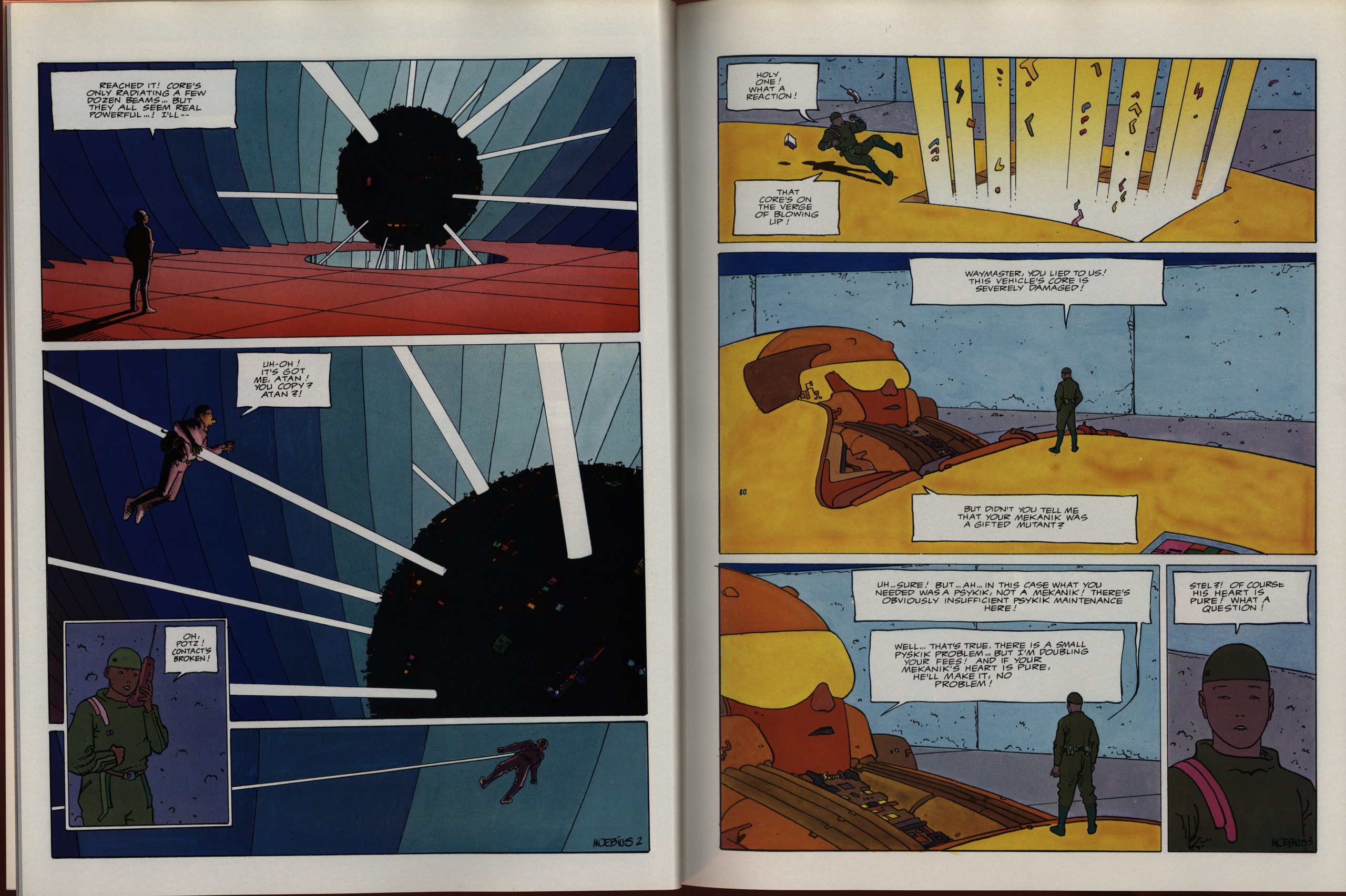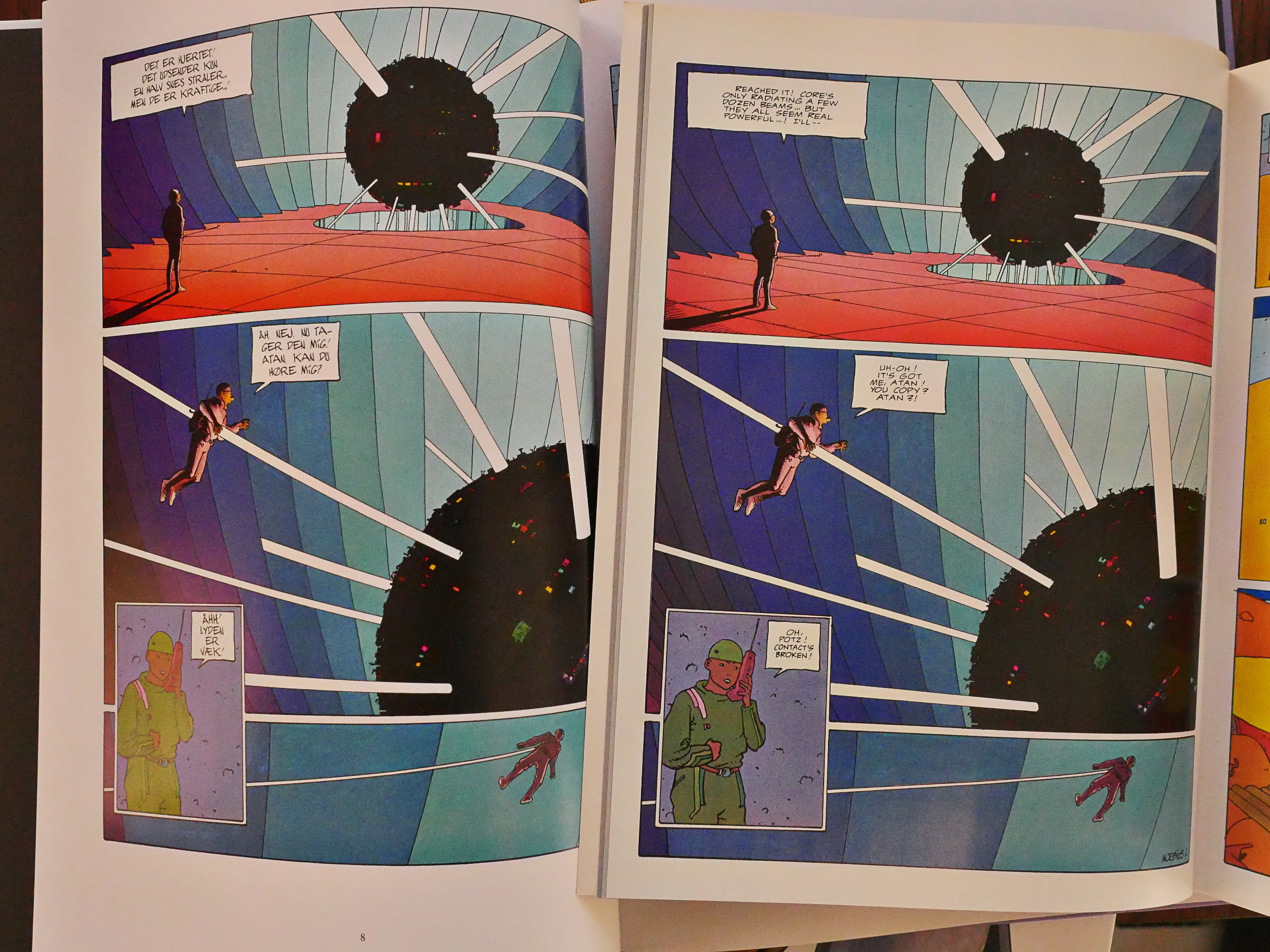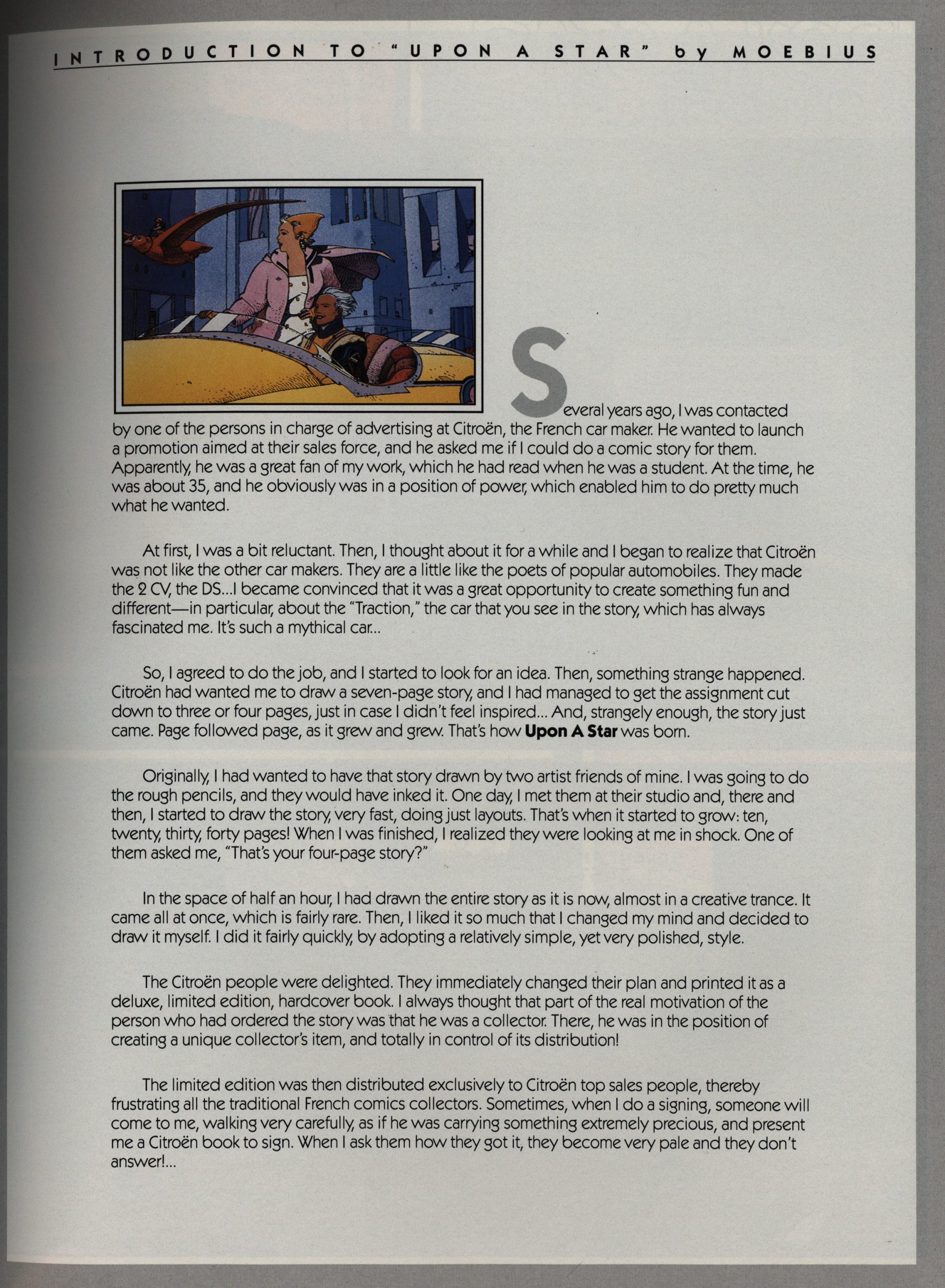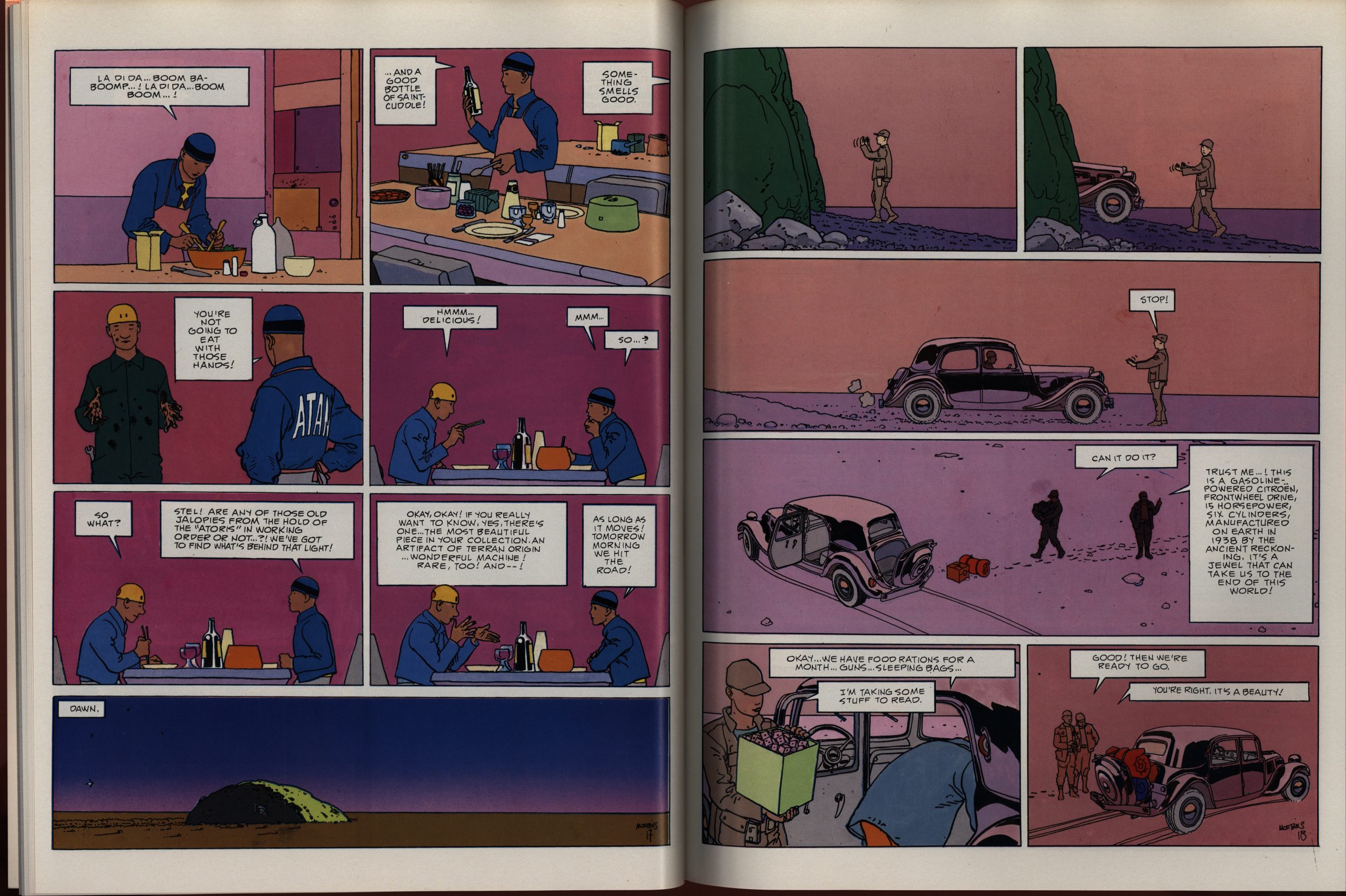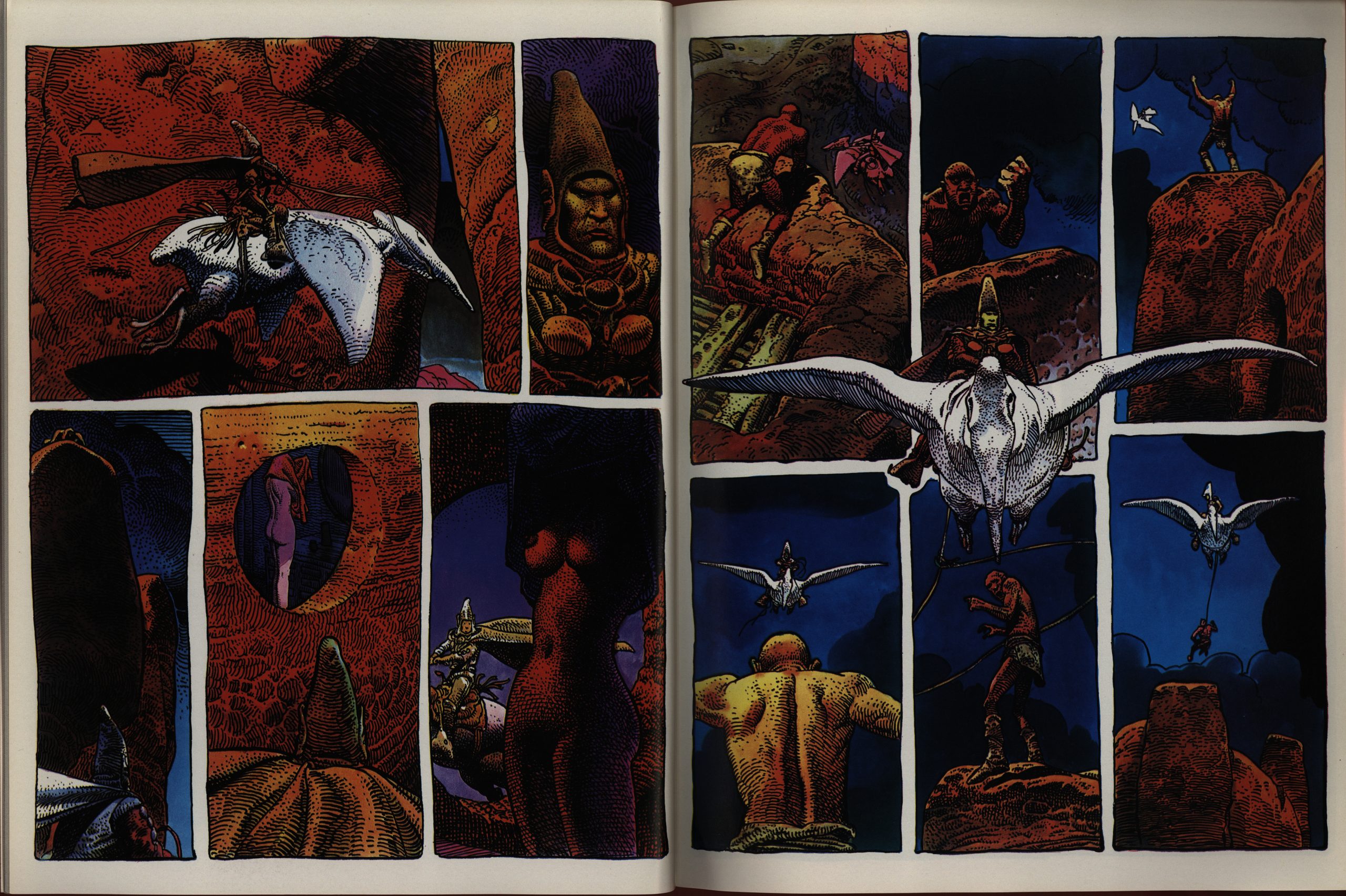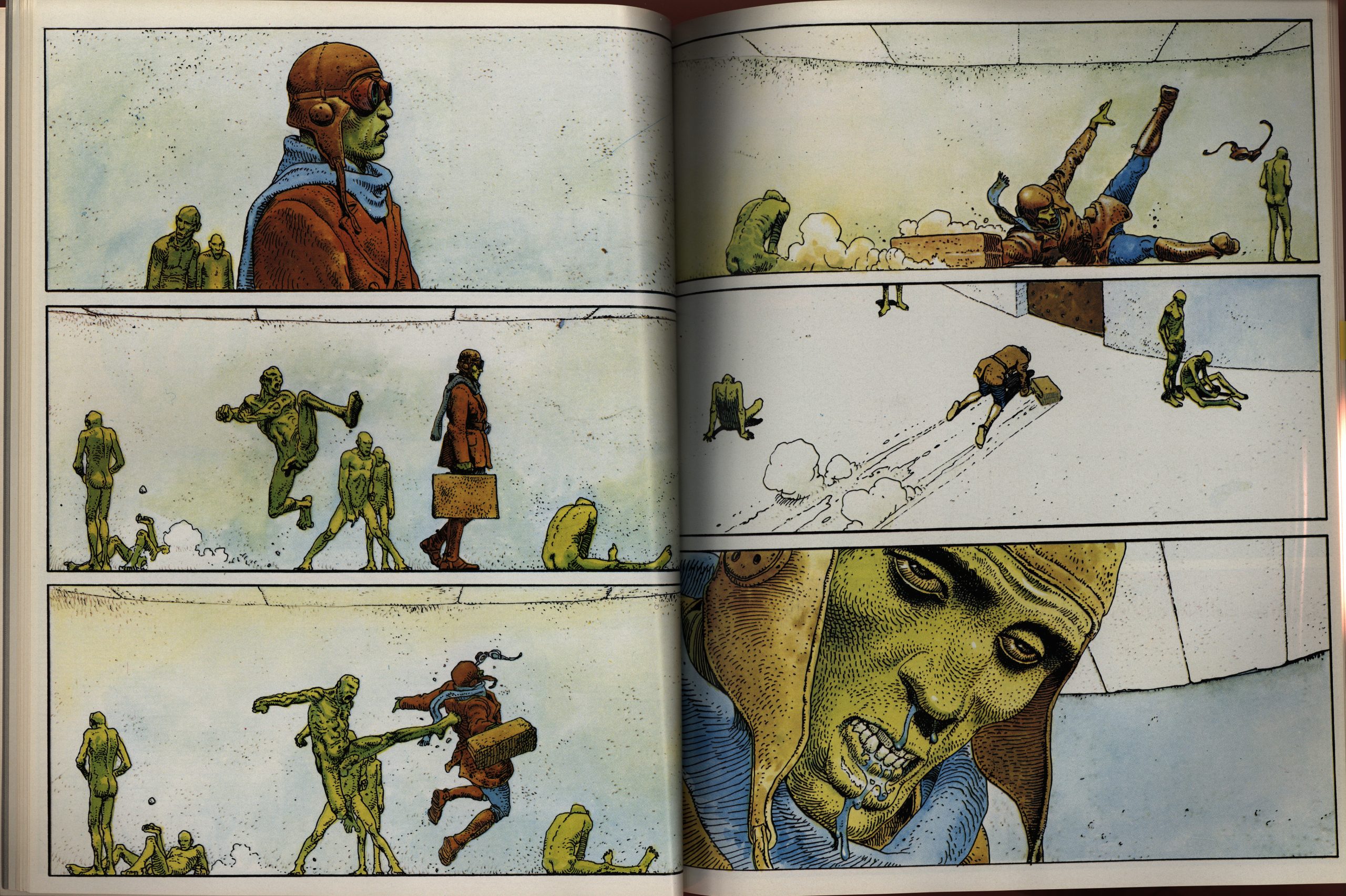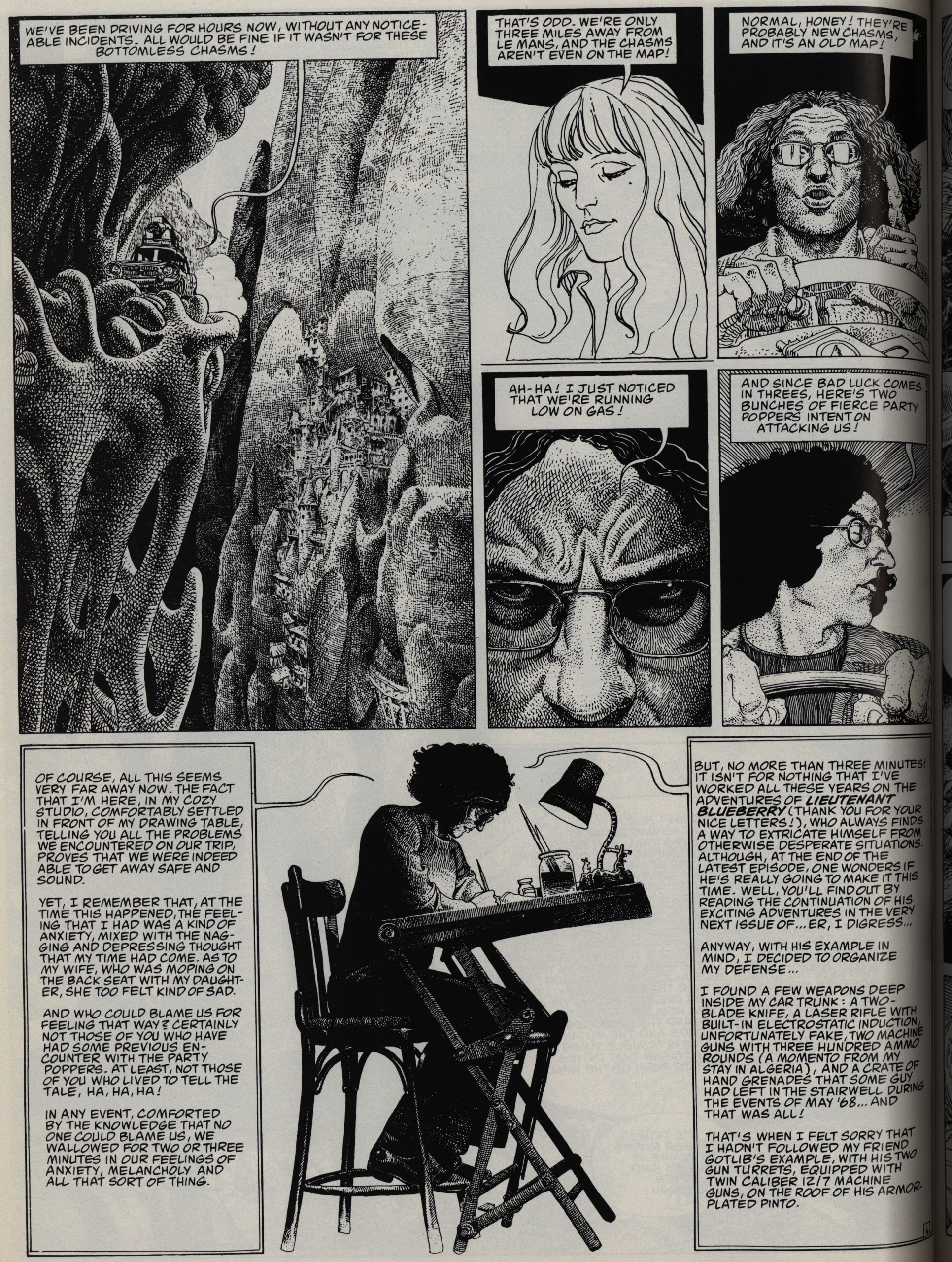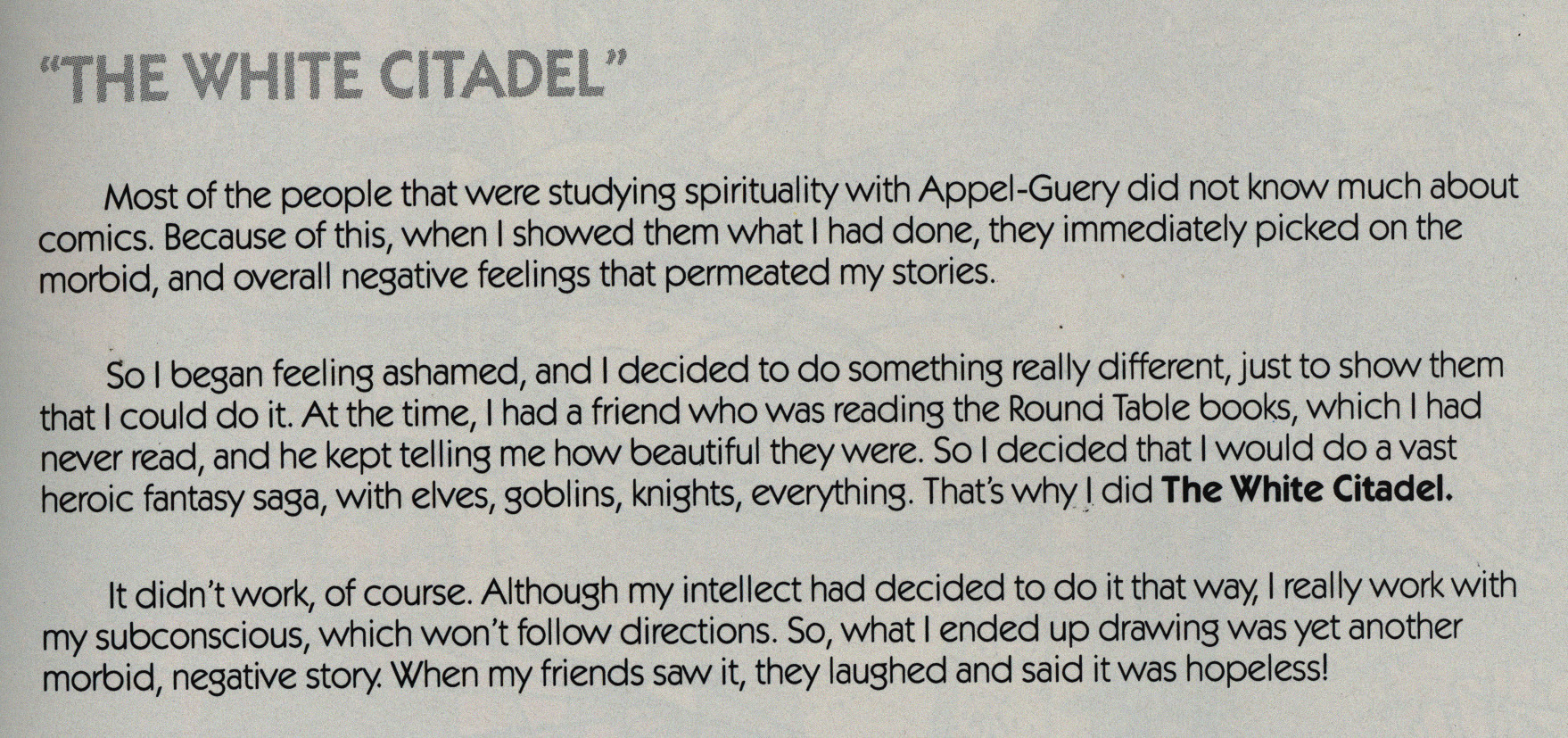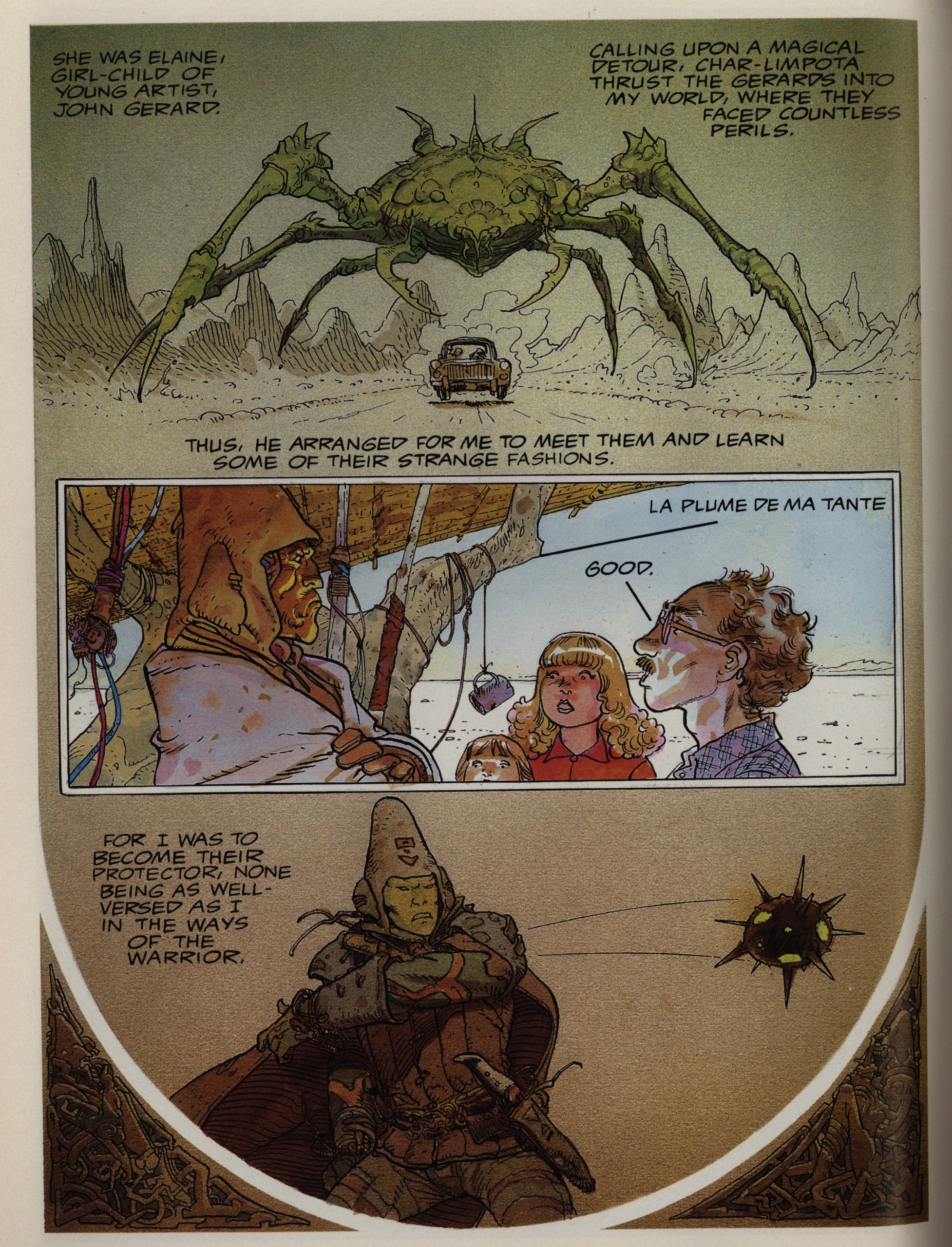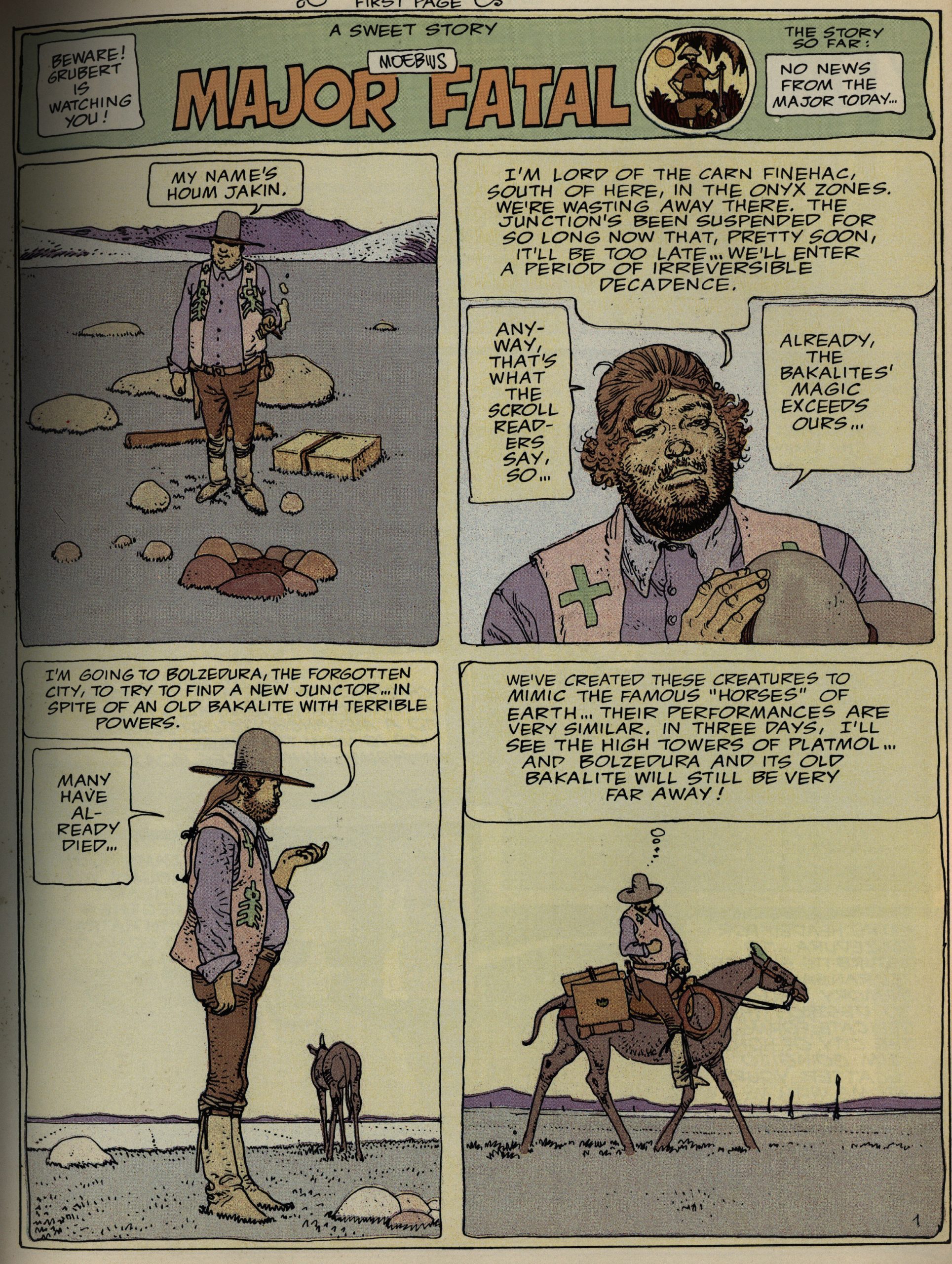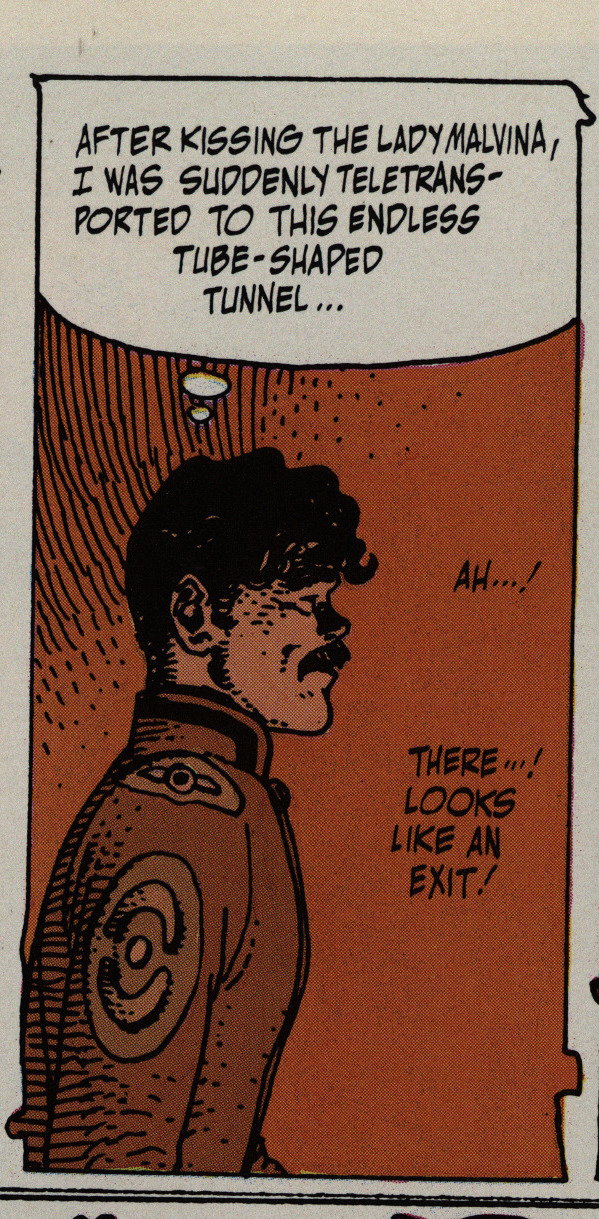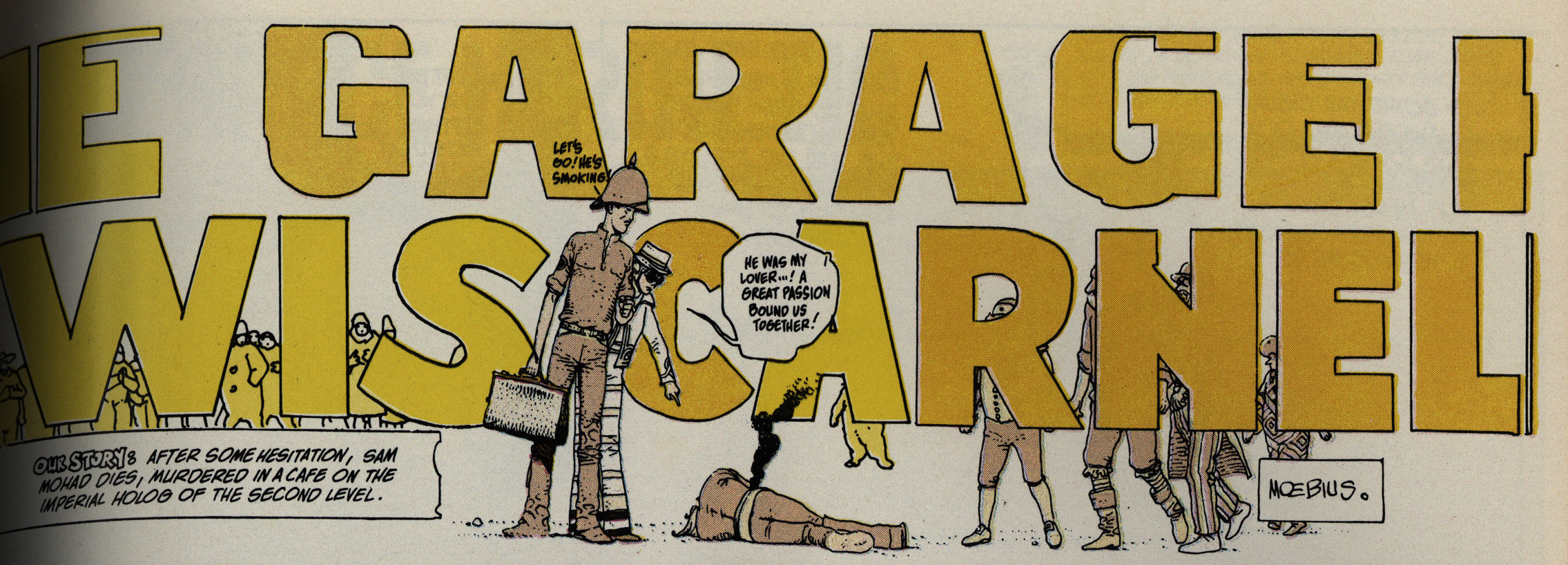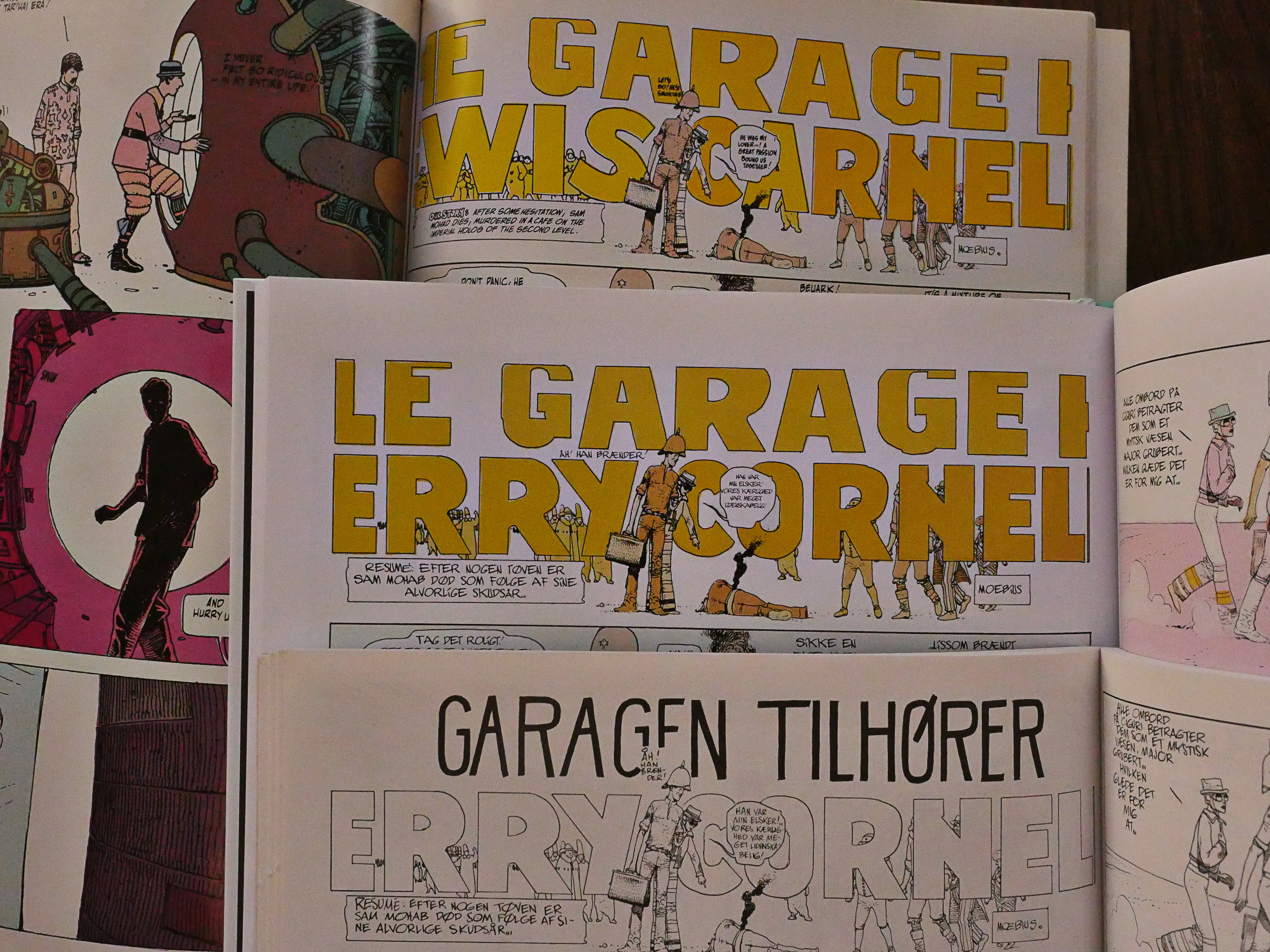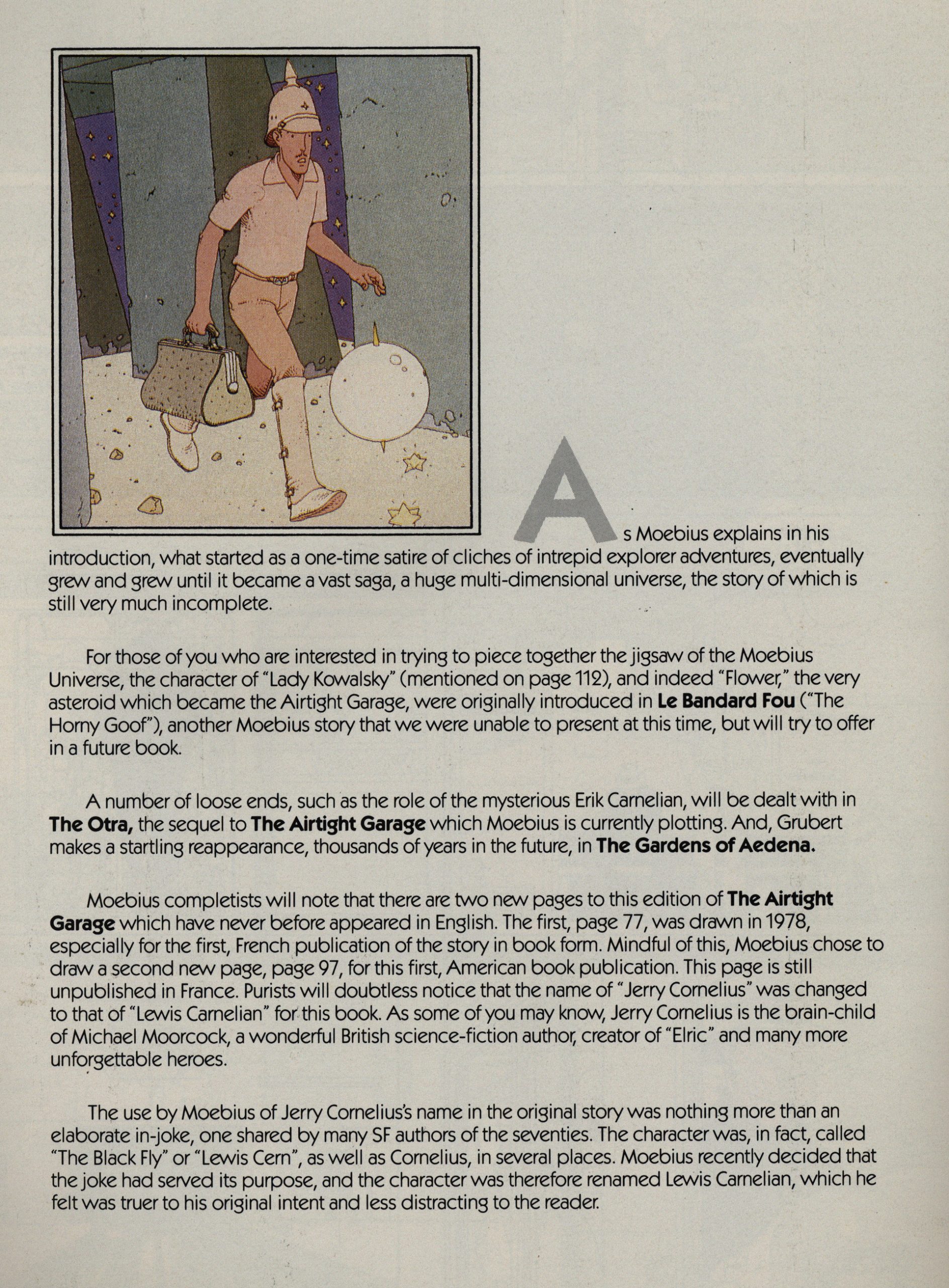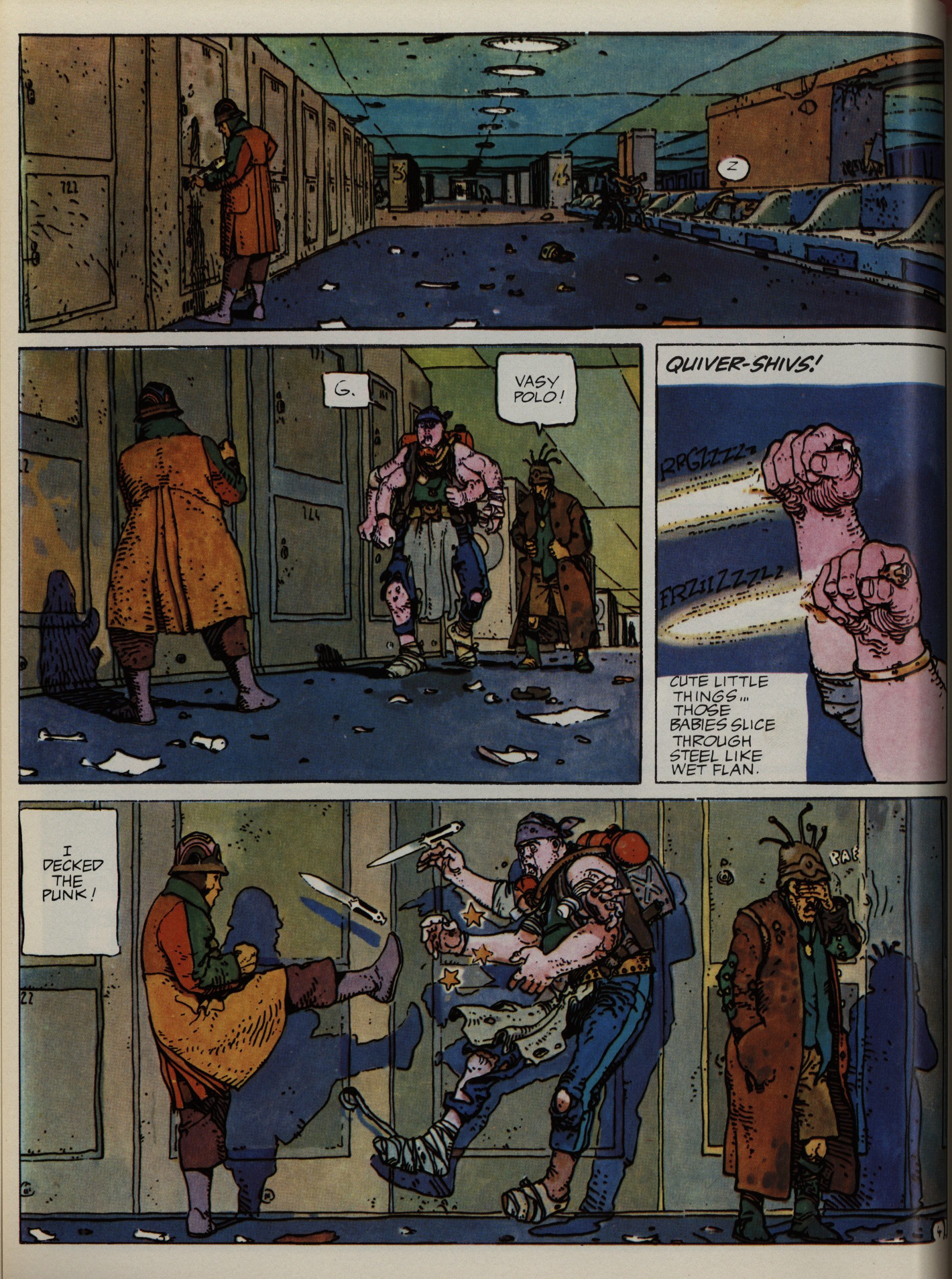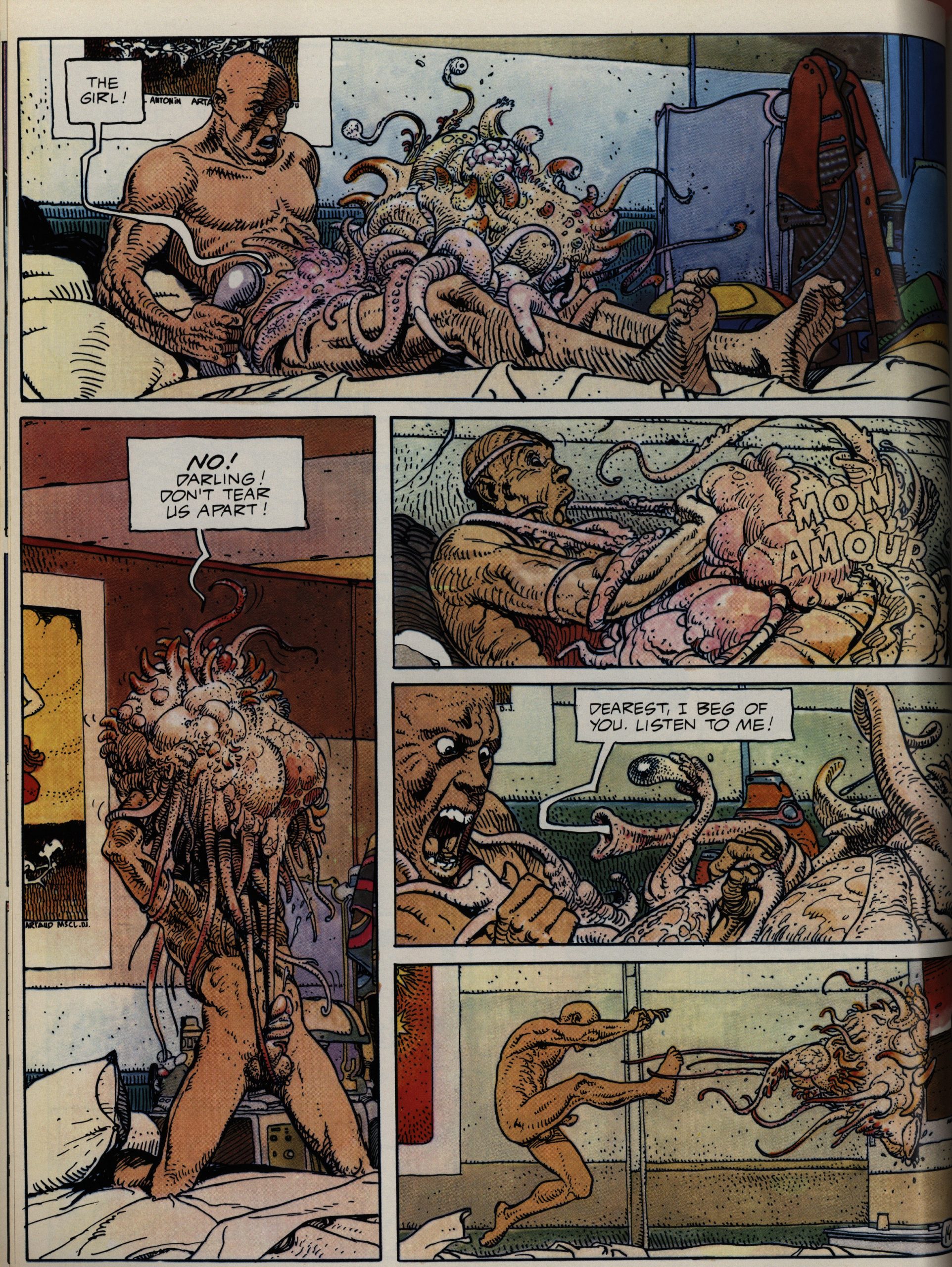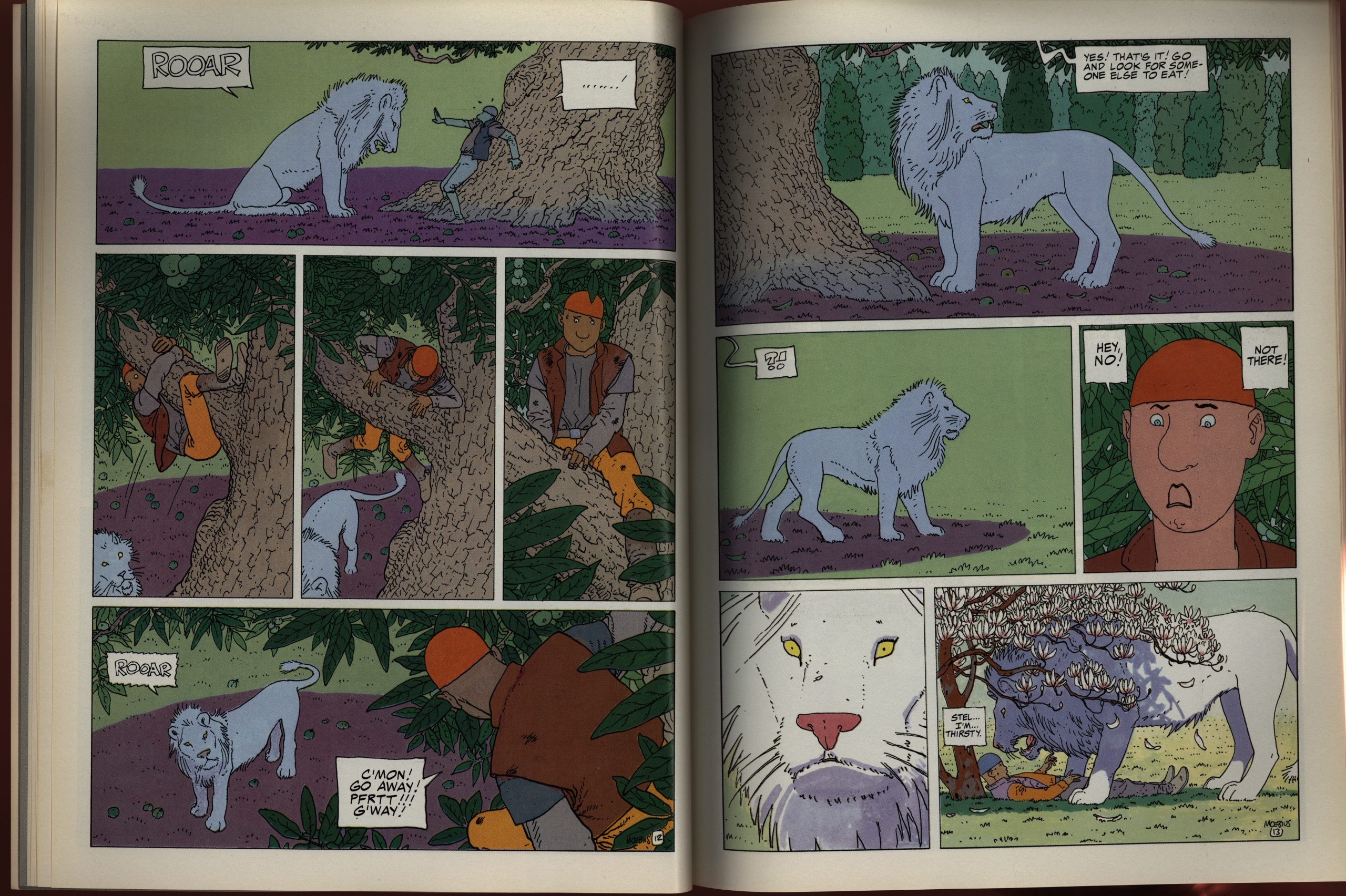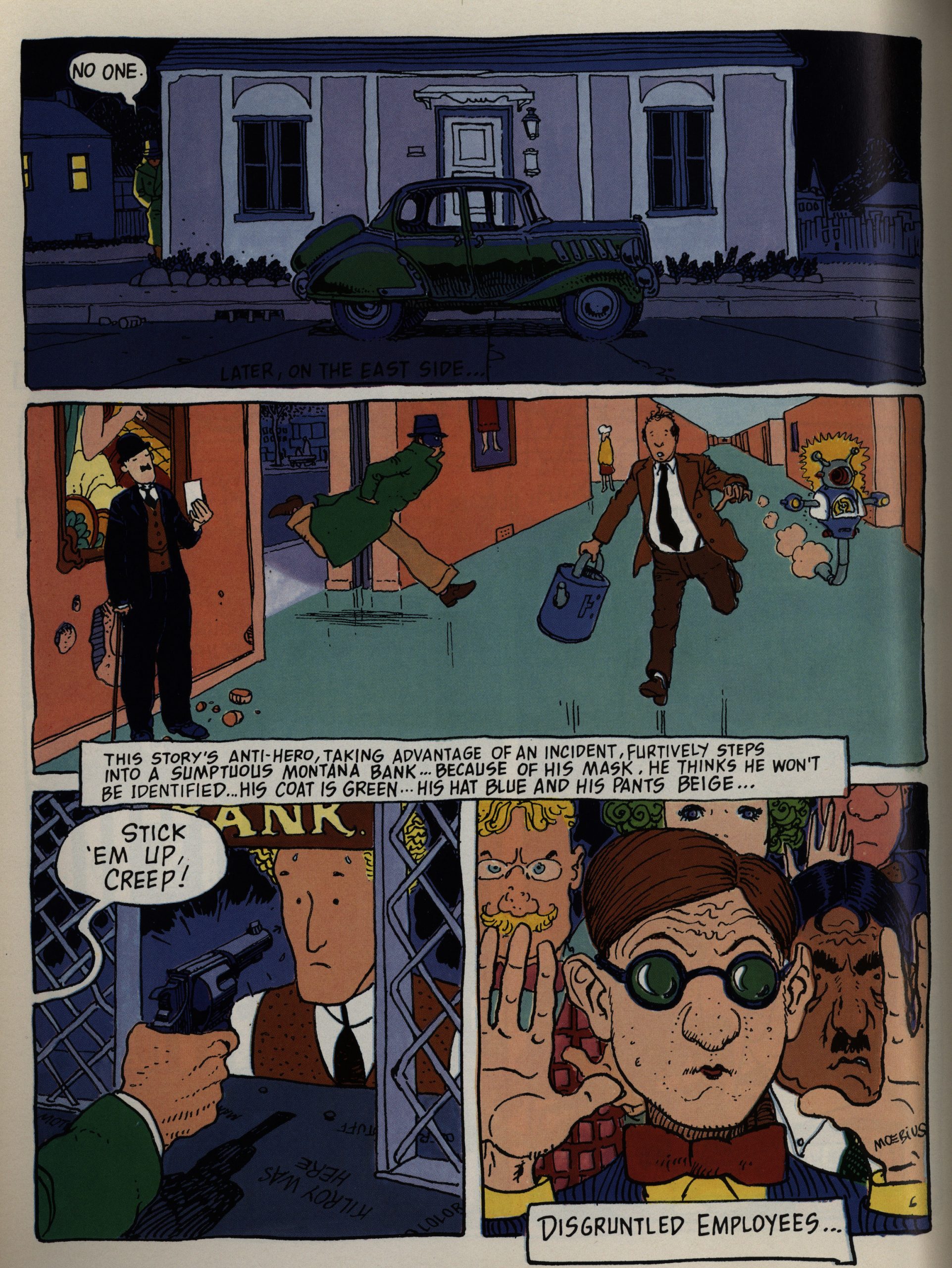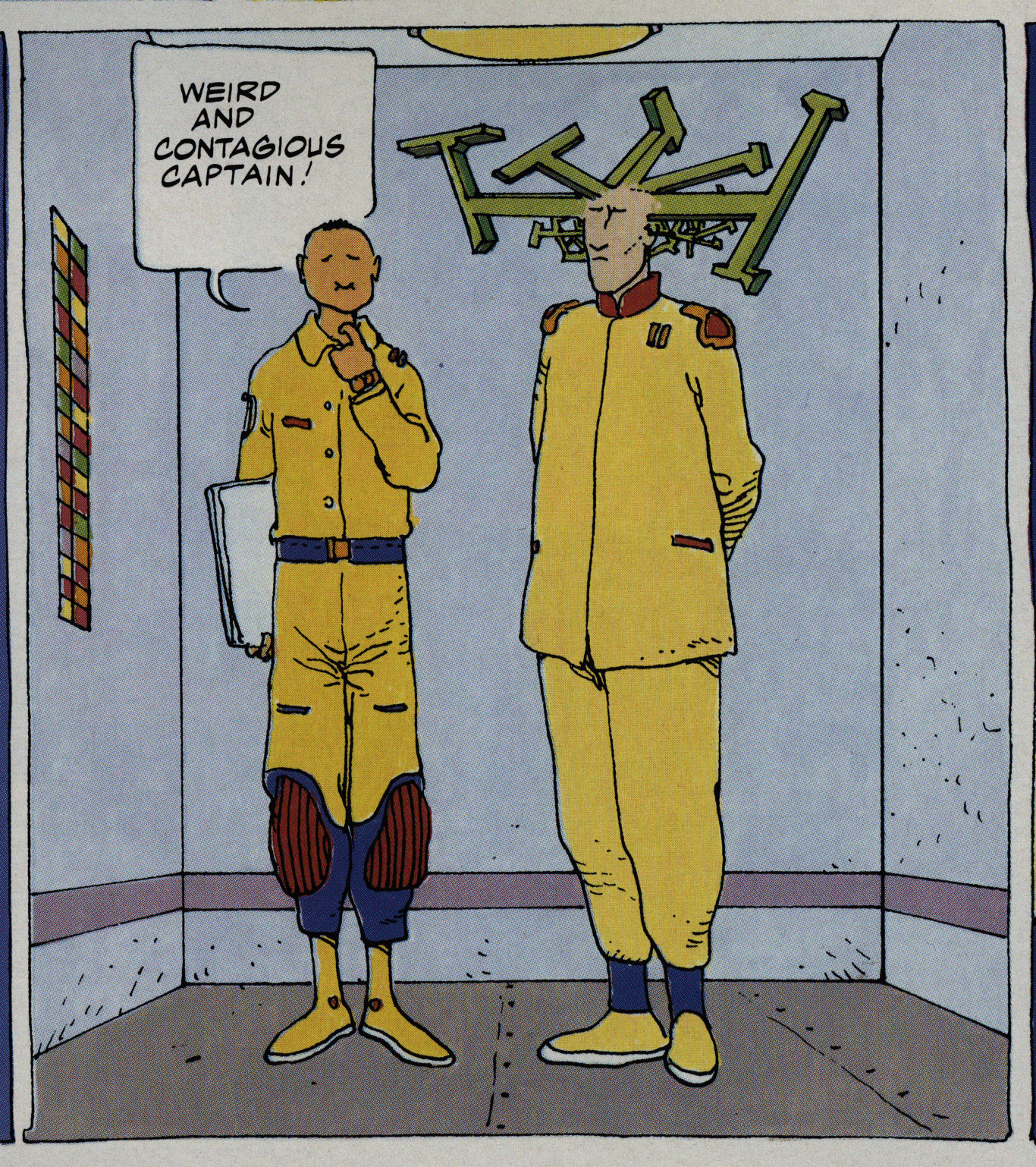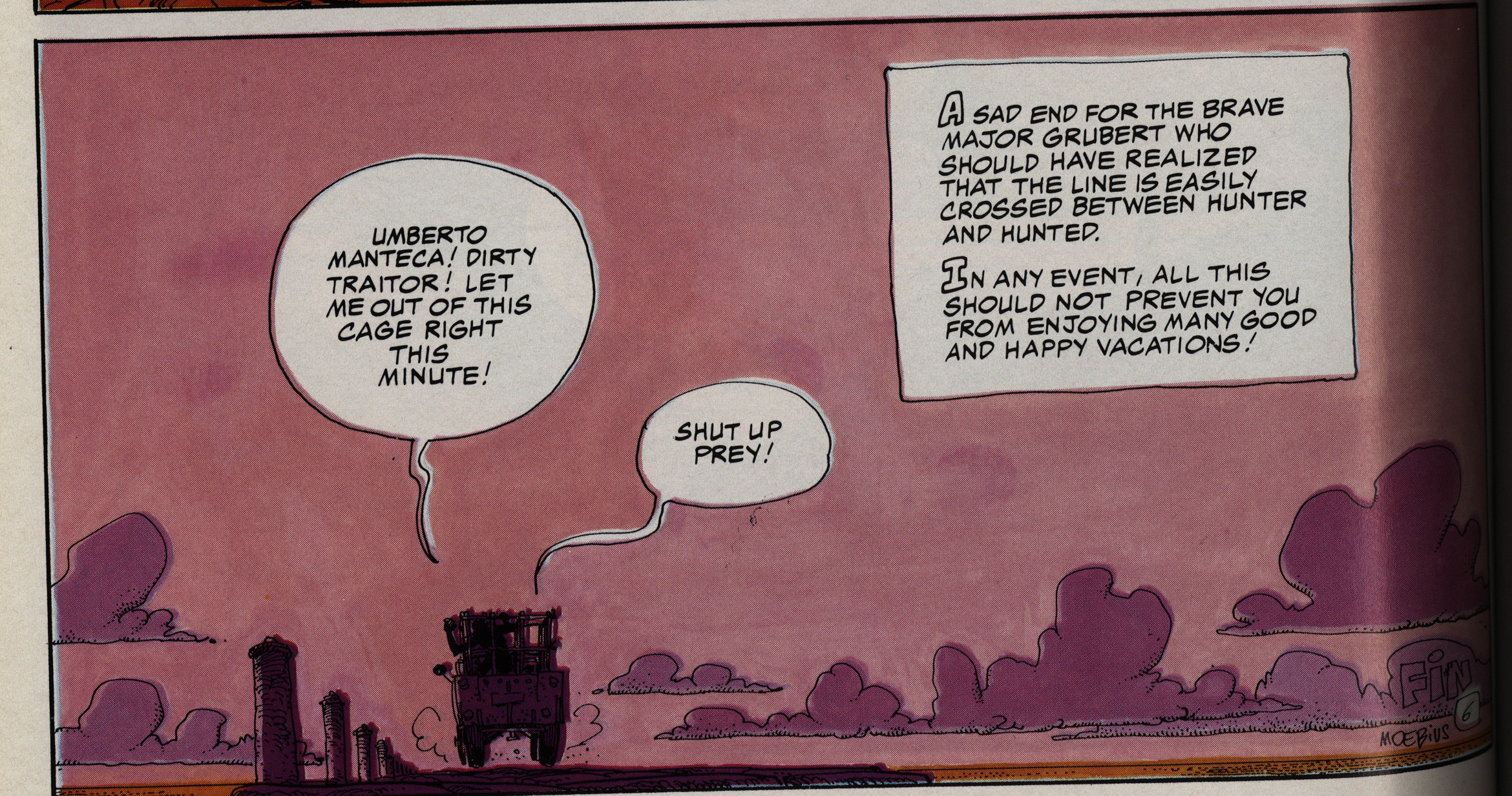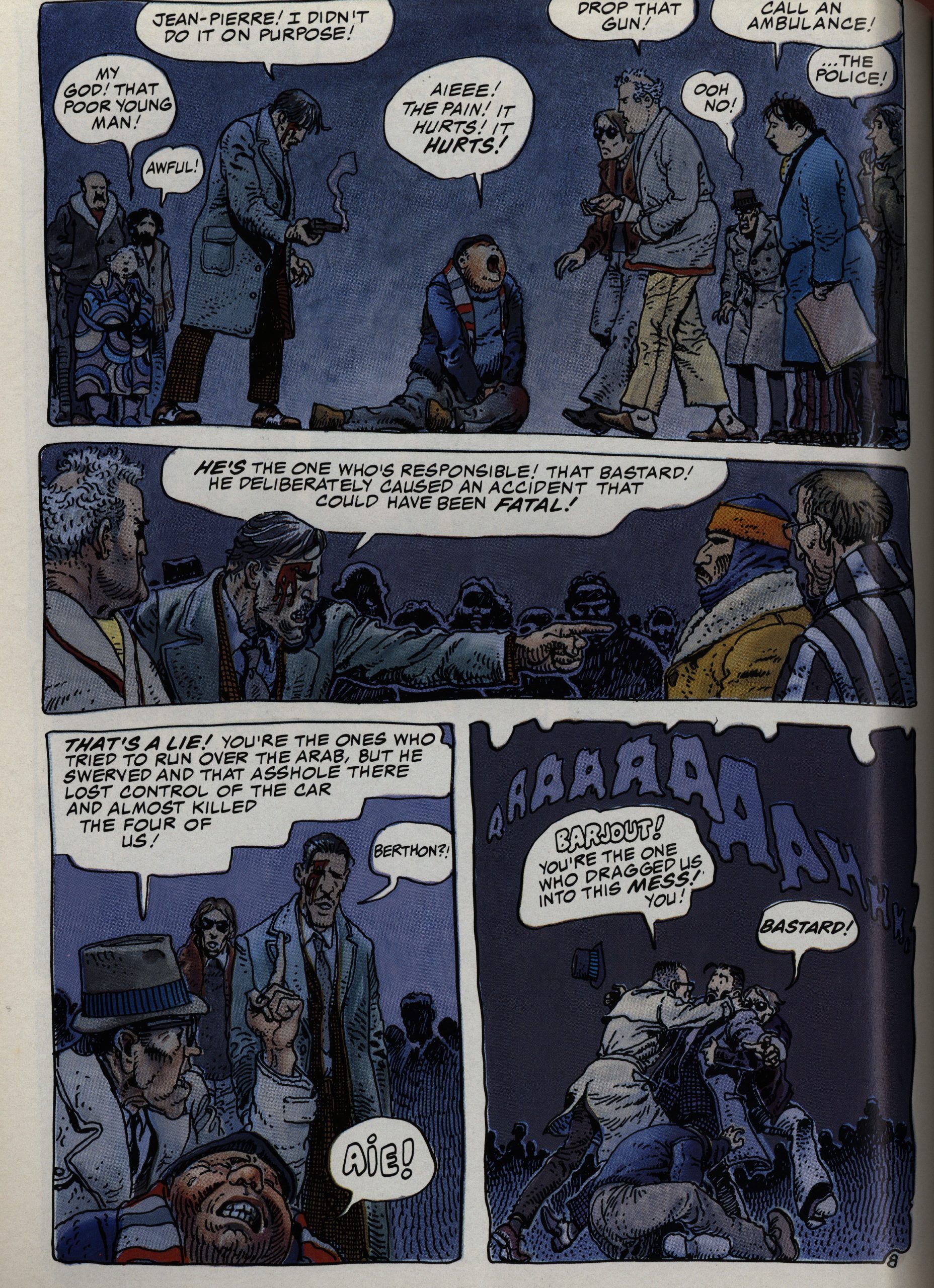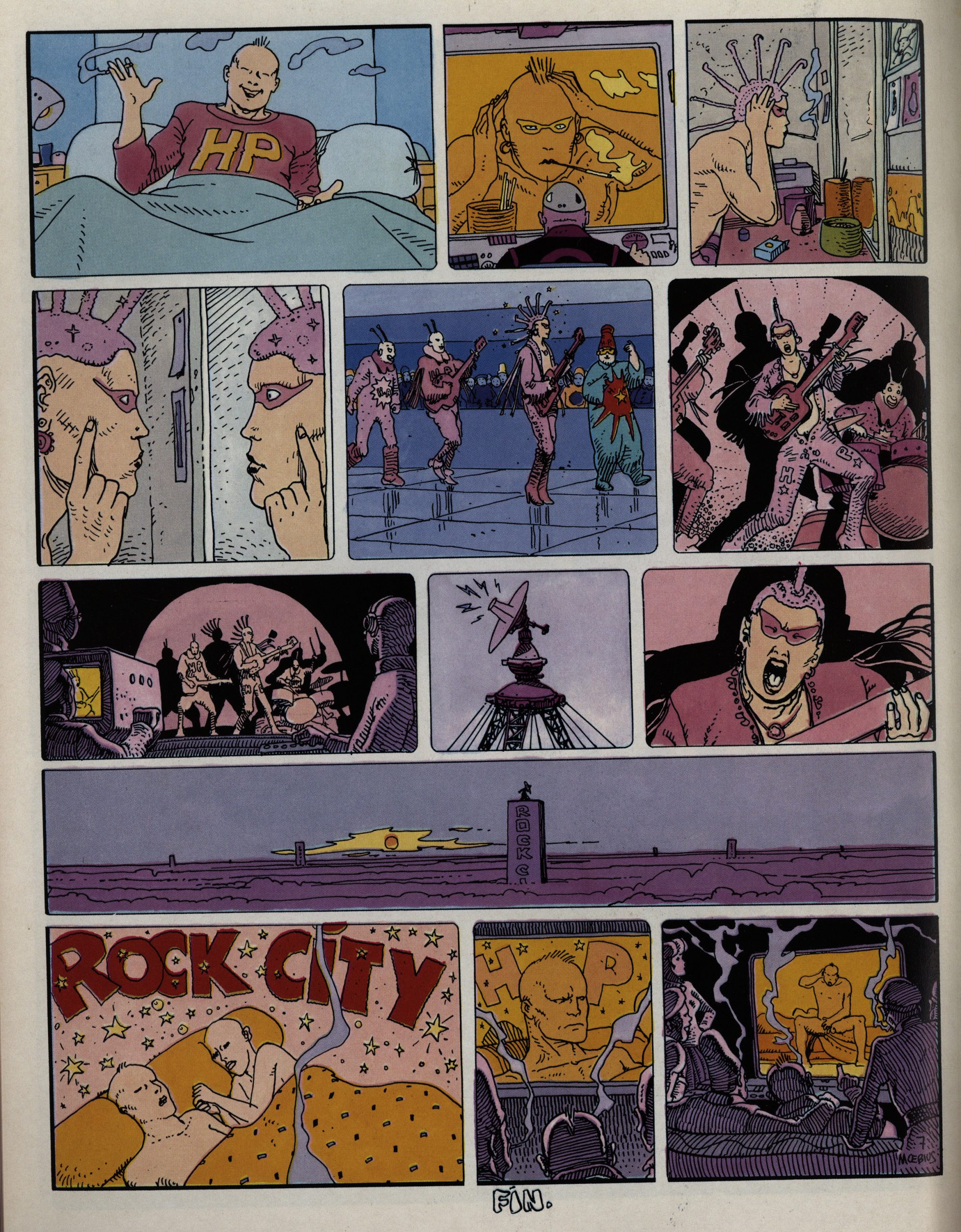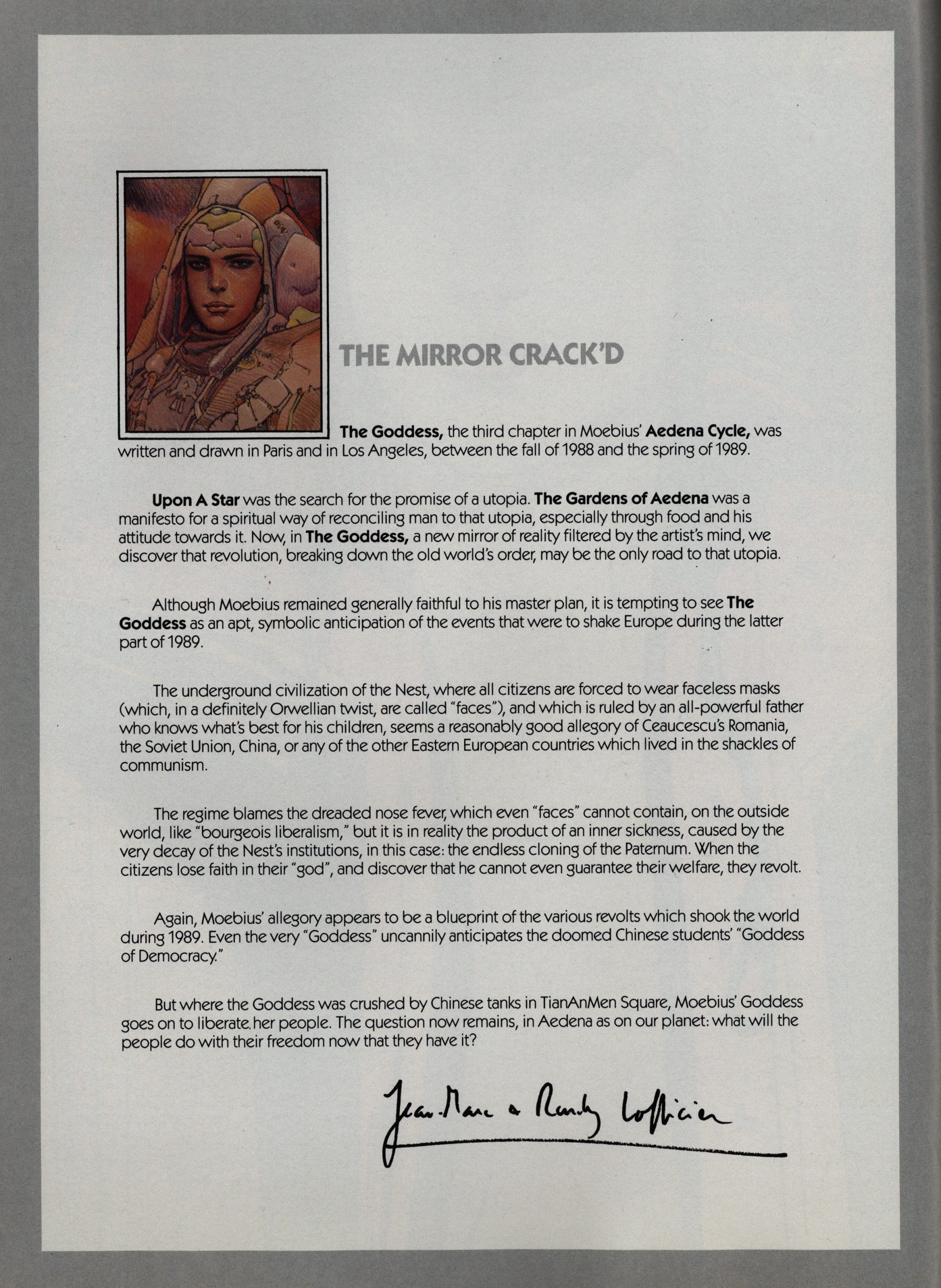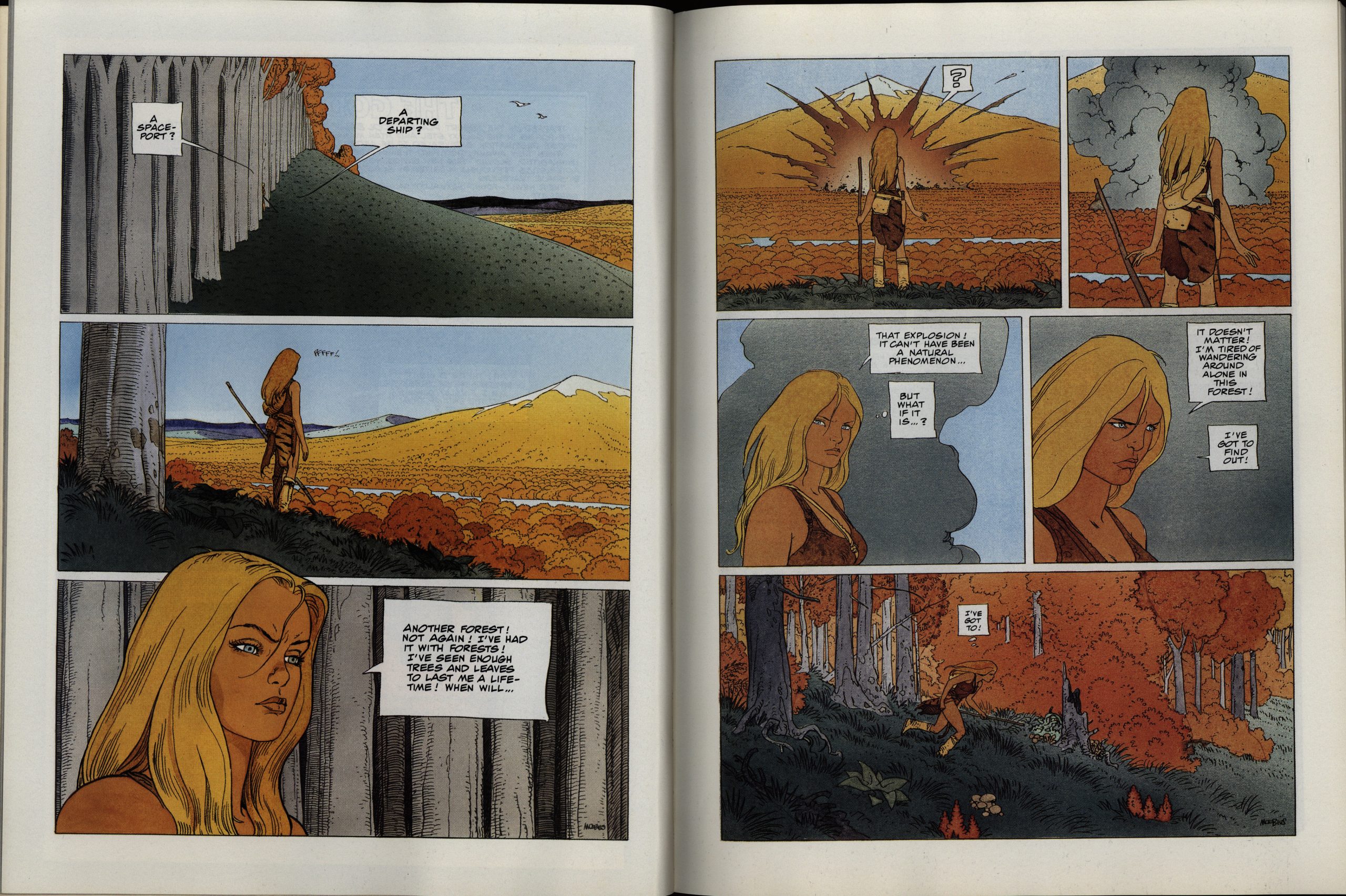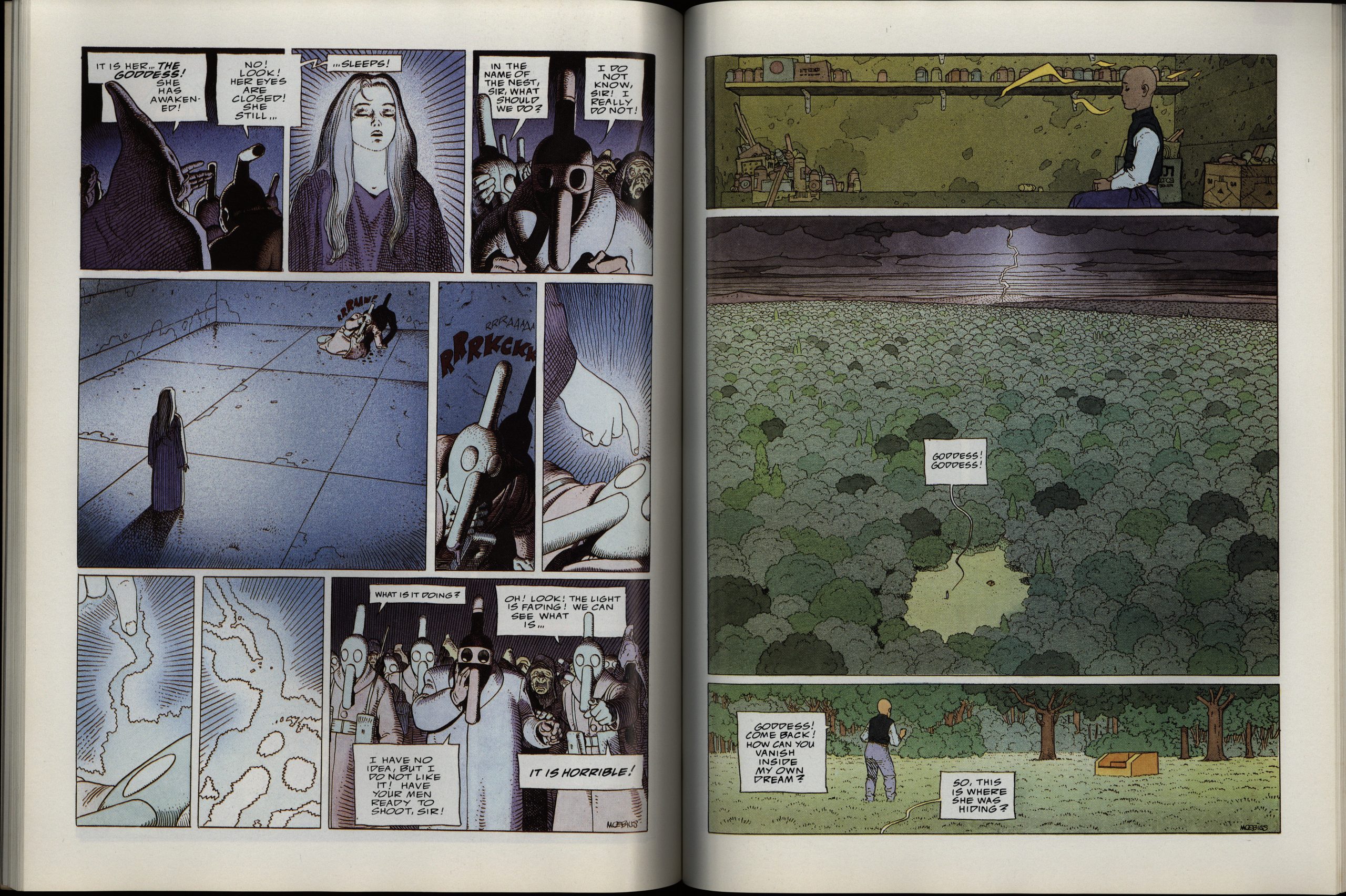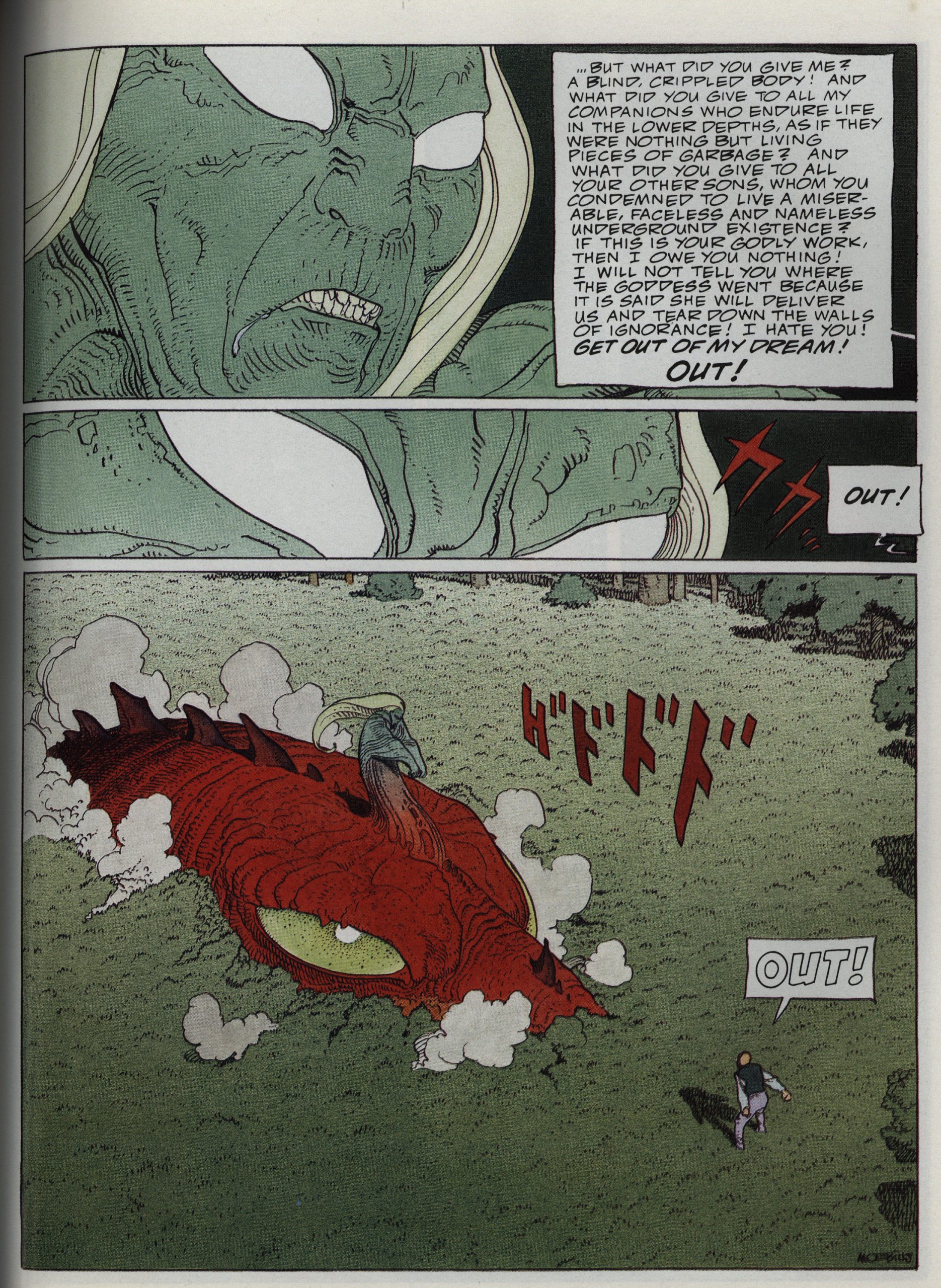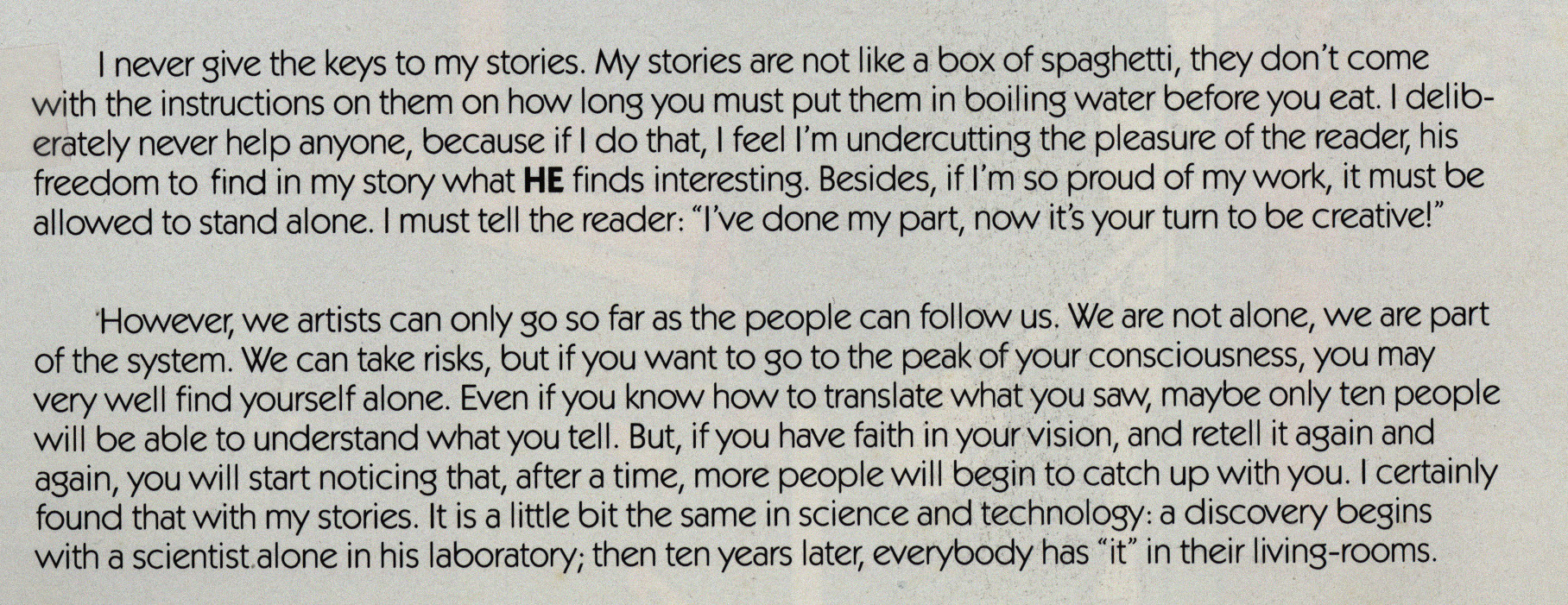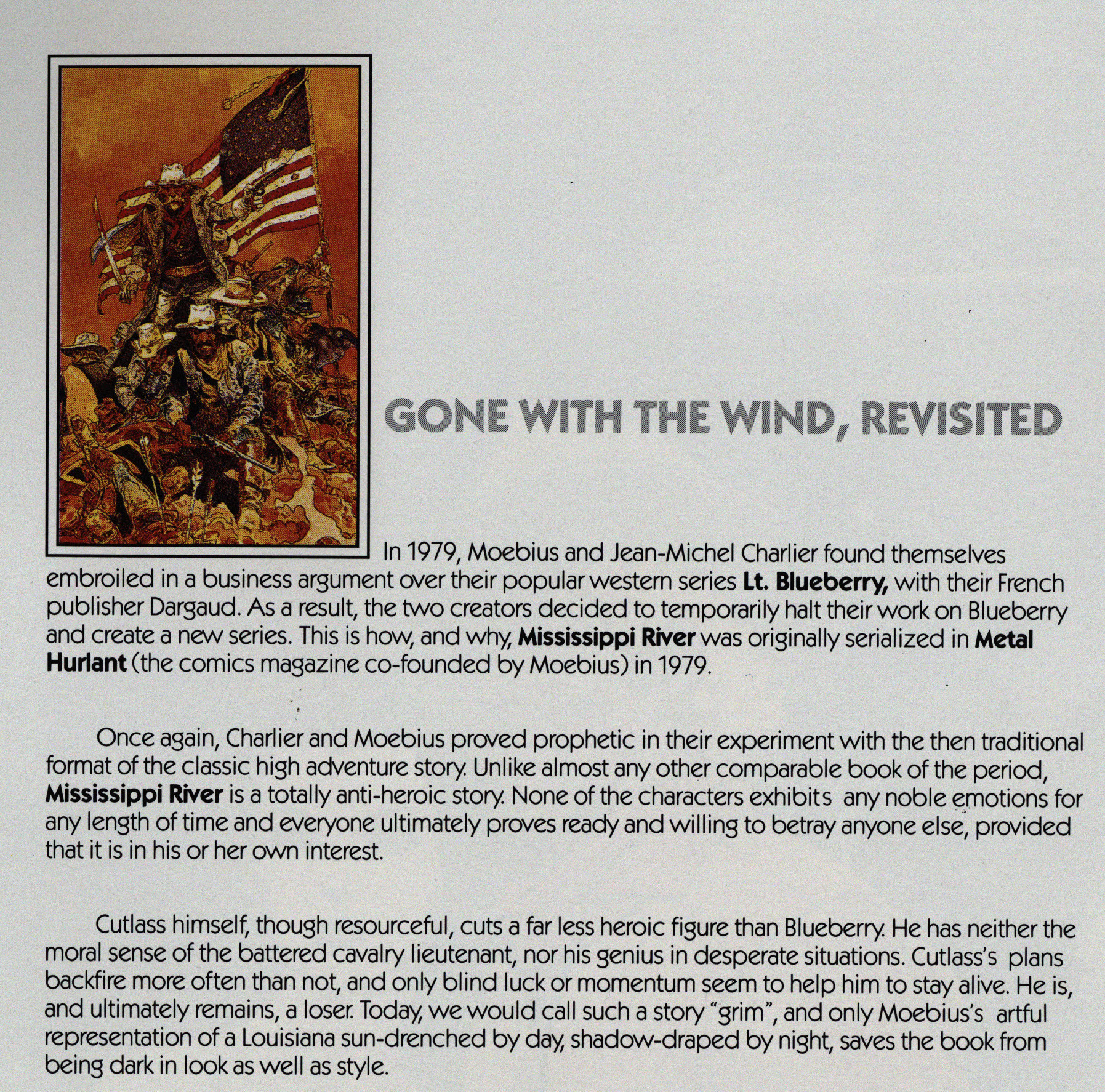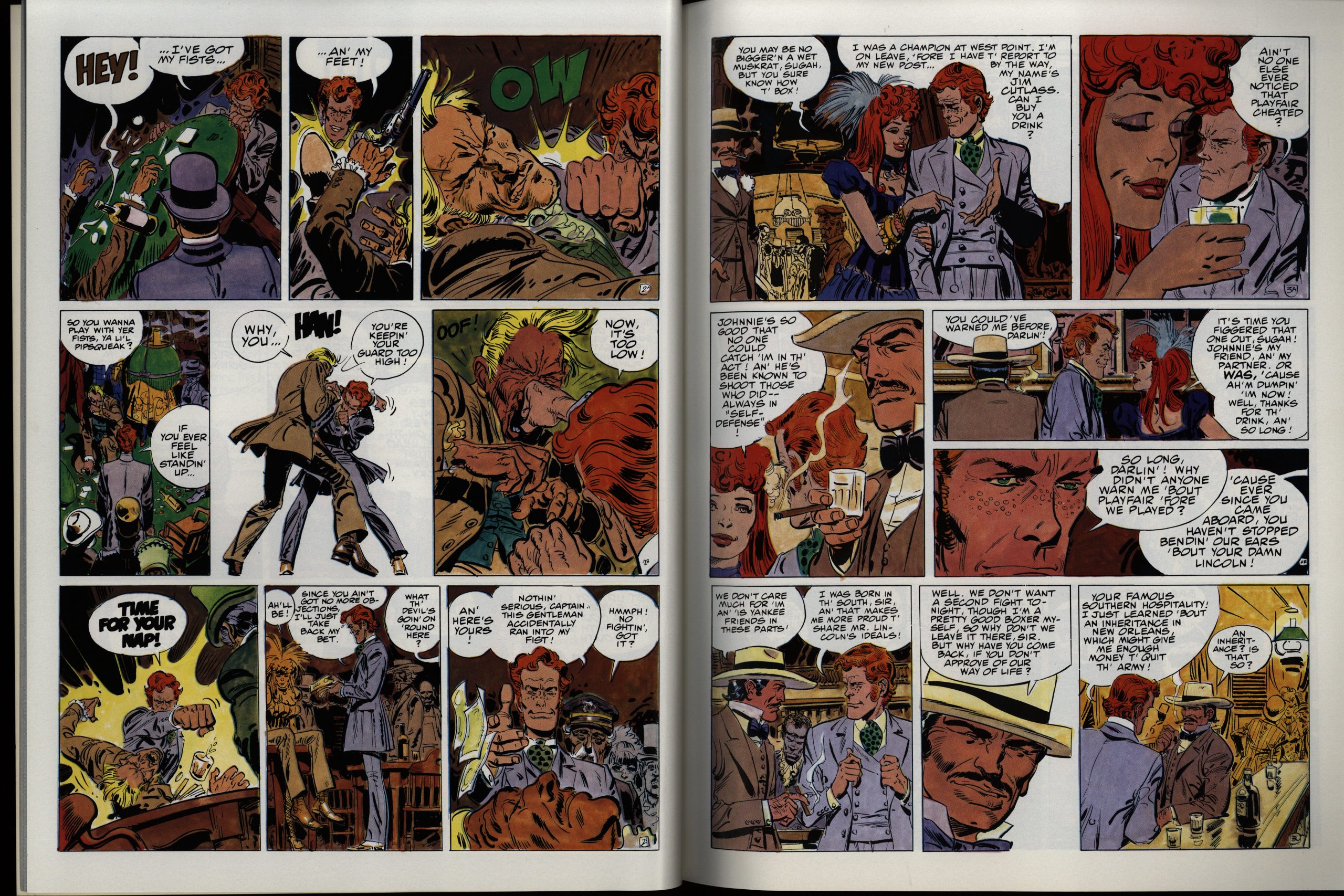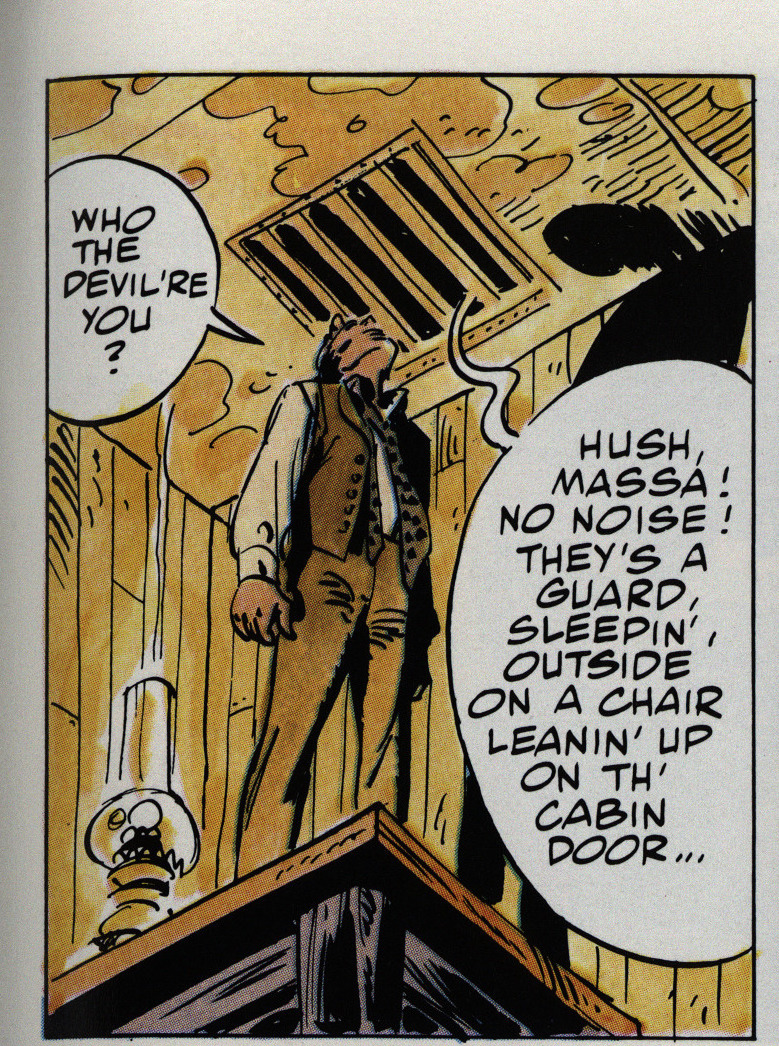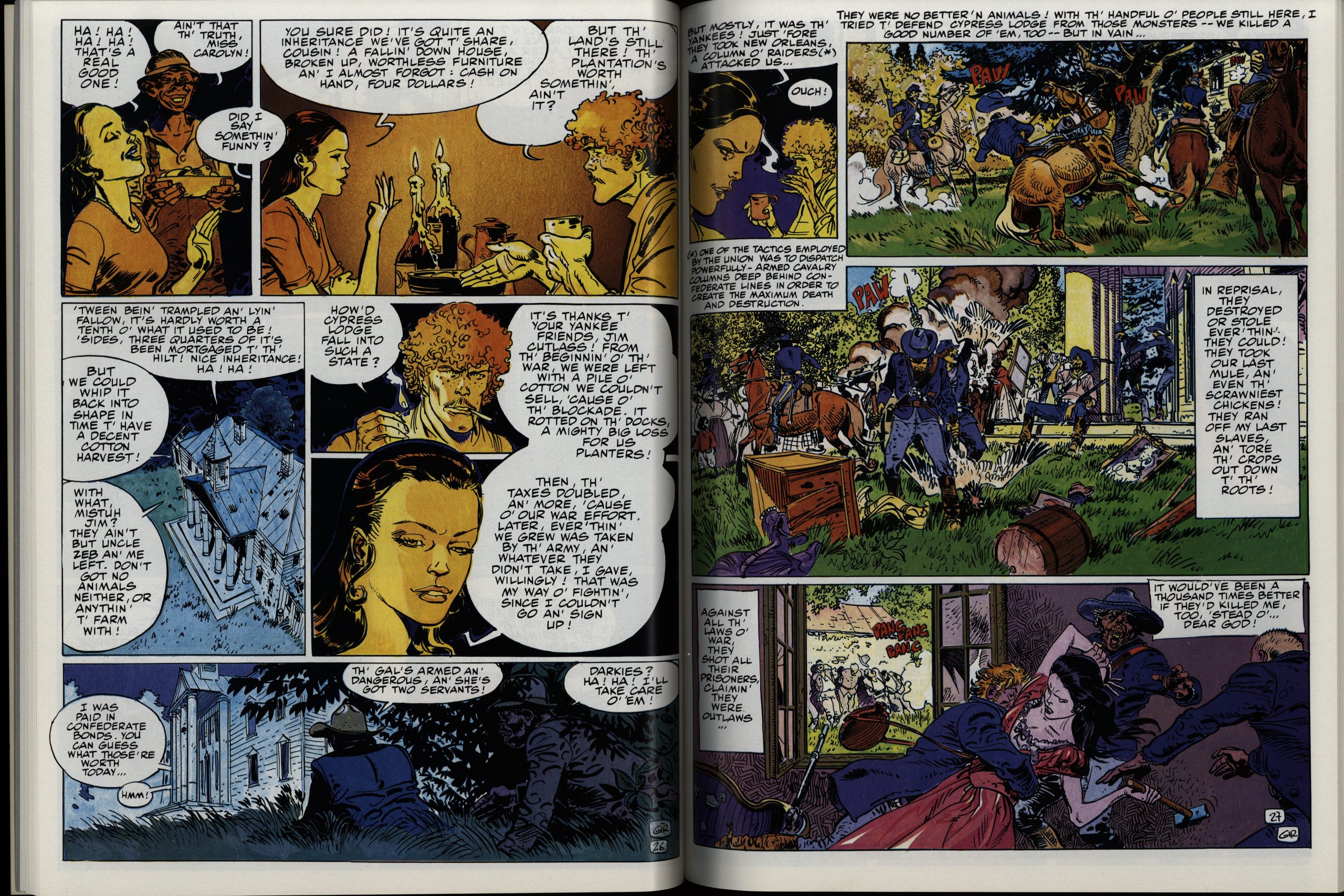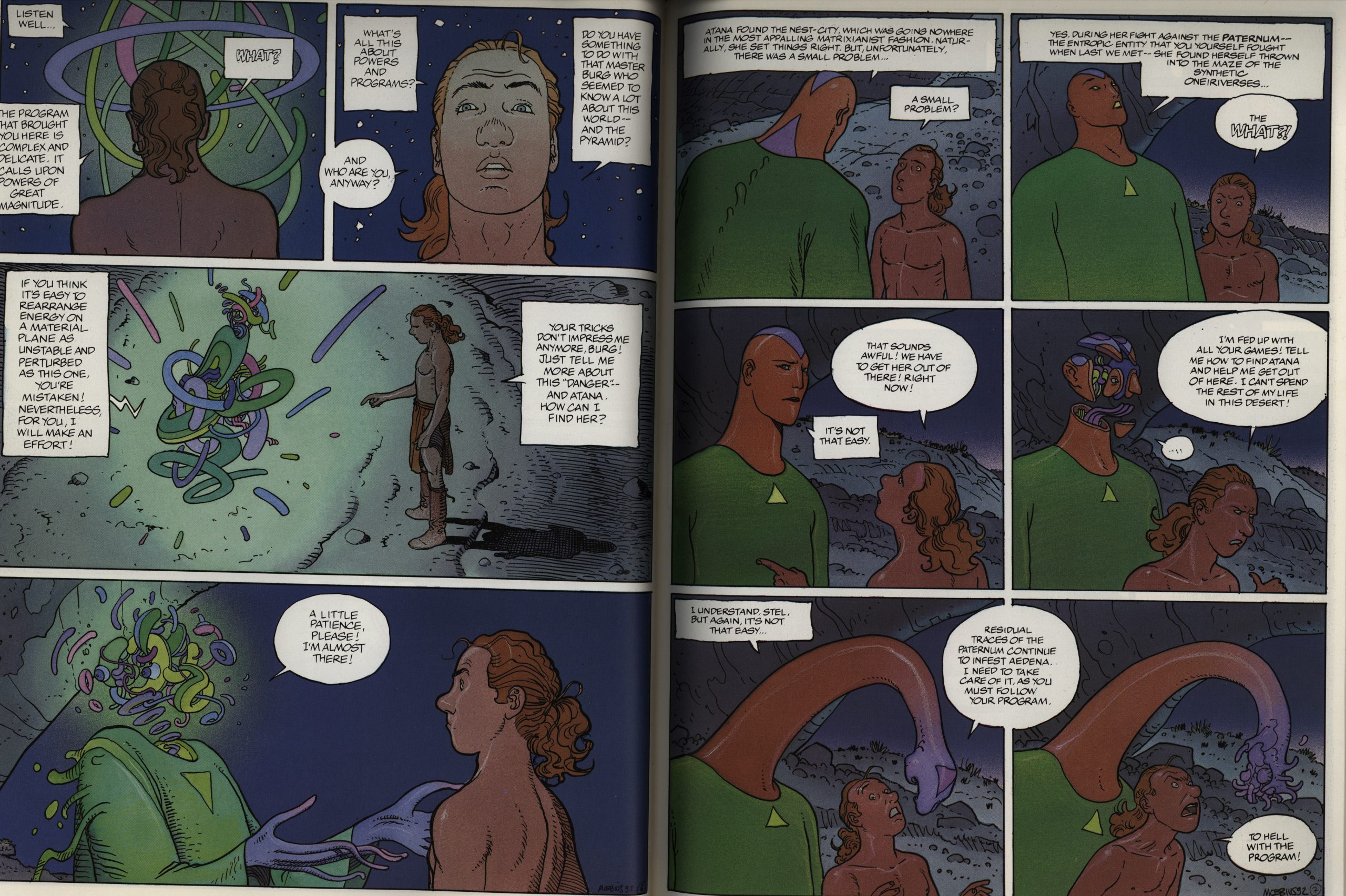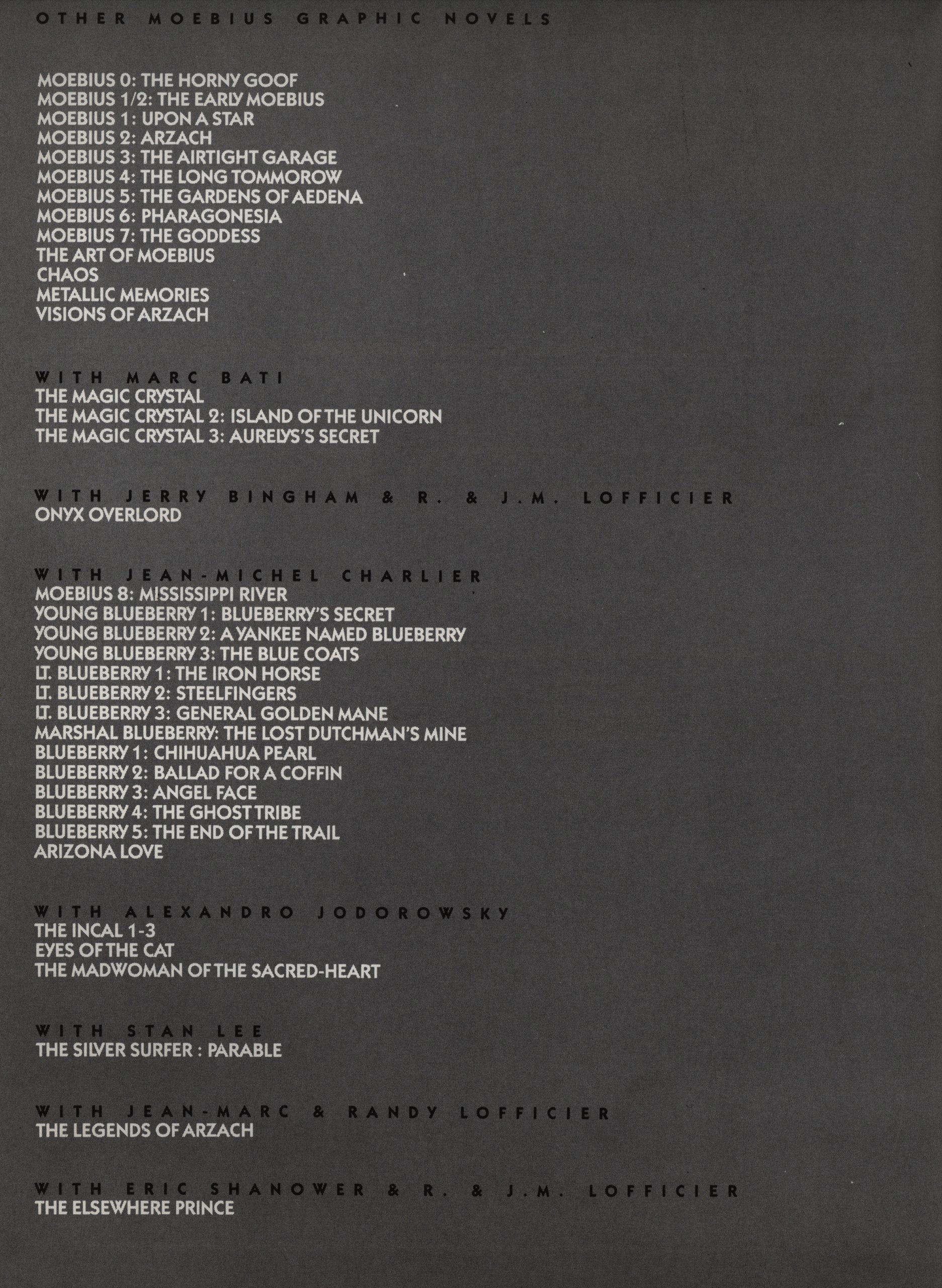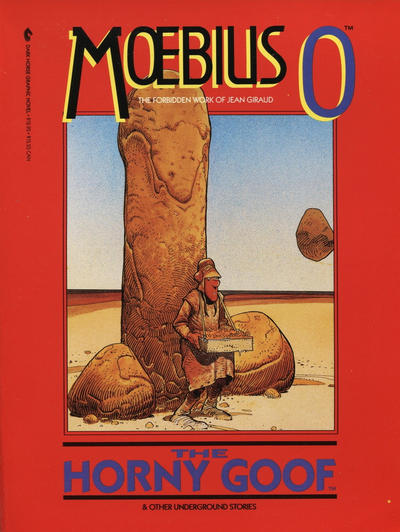Marshal Law (1987) #1-6,
Crime and Punishment Marshal Law Takes Manhattan (1989),
Pinhead vs. Marshal Law (1993) #1-2
by Pat Mills and Kevin O’Neill
DC comics had brought in a number of British creators to great critical and commercial success, so I guess it was time for Marvel to do the same, so here’s Mills and O’Neill, veterans of 2000 AD etc. And I have to admit, when I first saw this, I was thinking “oh, dear, another Judge Dredd rip-off”.
But then it turns out to not be much like Judge Dredd after all.
Instead it’s a Watchmen … rip-off? I mean, it deals with many of the same issues as Watchmen, and it copies some of the storytelling quirks from Watchmen…
But instead of being all serious like Watchmen is, this is a goof. So… a comment on super-heroes and a side bar on the “serious” deconstruction of them, as in Watchmen and The One, for instance.
It’s fuelled by what I take to be an honest loathing of super-heroes, which is pretty unusual, as these things go.
The first issue here is a headache in papery form. There’s so many characters introduced, and so many oblique storytelling bits that it becomes overwhelming, and I love that. Let’s just take one single page where nothing much happens:
There’s a priest there, and we’re reminded of who the bad guy is, and there’s “lortamercy”, and there’s the fat guy “if you fired a cannon of soap at him, you’d still miss him by yards”, which, I take it, is a way for her to say that he’s filthy, but does that relate to the ad for the cleanser?, and there’s a “Danny” in a “cave”, and there’s a tower of boxes tipping over?, because the fat guy took one? and then the boxes of “Cloo”? tipping over? All the pages are like this: Full of little details and unknown names being alluded to.
It’s exhausting, and I hope they keep it up!
But then the second issue arrives, and we get a five page recap of the previous issue, that explains, in great detail, whatever the reader may have laboriously interpreted from the first issue.
Boo!
And that’s basically it: The rest of the series totally abandons whatever they were going for in the first issue, and we get a “no moron left behind” kind of thing. Did they have the first issue in the can before approaching Epic, and then the Epic editors told them to dumbify it?
Oh, well. O’Neill’s artwork is a lot of fun, but whenever he’s drawing people not making exaggerated grimaces or hitting each other, his faces have a tendency to go really wonky. Especially when he attempts to draw somebody pretty.
And when reading that page, I guess most of us went “oh, she’s the hero’s girlfried? She’s dead then?”
Indeed. She’s summarily raped to death. I know this isn’t a particularly serious comic, but this sloppy fridging is… lazy.
Curiously enough, most of the letter-writers are British, and they do like what they’re seeing.
Mills has given the protagonist this catchphrase that he seems very proud of, but it doesn’t… quite make sense? I mean, it’s witty, but he’s literally saying that he’s really bad at his job. Should have put some more work into it.
A Brit reacts to the fridging. The editor says it was about “showing the horror of the crime”, avoiding the question posed by the reader.
That’s how the villain was scarred for life!
A central gag here is that super-heroes are sexually incompatible with normal people (for some reason or other (and when it makes sense in the story, but otherwise not)), but it’s never explained why.
By the end of the series, Mills and O’Neill have abandoned any pretence at having much of a story to tell. The world-building is razor thin: We get every itsy bitsy detail from the preceding issues explained to us again and again, and much of it is from the viewpoint of the rapist killer. Or perhaps “viewpoint” is the wrong word: He’s in the exact same voice as all the rest, and they all tell the same story.
They only had material for three issues and then they padded until fulfilling the six issue contract?
(By the way, the indicia stubbornly claims that it’s a bimonthly, but it was published with a four month gap between most issues, so you have to wonder whether the creators were getting bored with the concept, too.)
Eclipse had pioneered political trading cards around this time, so I wonder whether this was a comment on that?
But the disgust with the CIA’s actions in Central America seems genuine.
Hey, that’s this year! But, yes, Mills gets some pot shots in at most everybody; here he’s doing Christian parents. (She’s the one who was raped to death.)
A reader is terribly impressed at how sympathetic the serial rapist and killer Danny came off.
The editor announces that the series is over, but that there’ll be a further six issues in nine months time, and some plot elements are teased.
Instead we get a “prestige” format one-shot with none of the stuff previously mentioned. It’s 48 pages, and it’s on matte paper (instead of the shiny paper in the previous series).
There’s not much of a storyline here: It’s just Marshal Law fighting some super-heroes in an insane asylum. But there’s some funny gags, and O’Neill’s artwork has taken a leap forwards, becoming more the hyper insanity we know and love him for.
It’s mostly about how vile a character The Punisher is.
And what a horrible government the US has. I mean, had.
You have to admire the sheer loathing the creators display towards super-heroes. The book works, but it’s not very ambitious.
And finally, we skip forwards to 1993. We’re in a different era now: Selling mainstream comics around this time was all about collector’s editions and stuff, so we get two 32-page comics with embossed, thick, metal ink covers. (Silver and shiny red ink.) And, of course, this is a cross-over with the Hellraiser universe.
Looking at the publishing history, there’d been a number of cross-over stories published by other comics publishers after the Takes Manhattan thing. I’m guessing the schtick is that Marshal Law pops into other universes and wreak havoc? I guess that sounds profitable?
O’Neill’s artwork isn’t particularly inspired here. Sure, it’s busy and strange, but there’s fewer background jokes and gags.
But, I mean, it’s still O’Neill.
This is a Hellraiser crossover (because Epic had the rights to that universe at the time and pumped out a lot of Hellraiser-related product; we’ll cover it all later in this blog series). I’m not sure whether Mills was a fan of it all or not? Whenever Pinhead’s on the page, bloviating about the sanctity or pain or some other Barkerish nonsense, things get really boring. When he’s not on the page, you get stuff like the above, which seems… more… heartfelt?
These two issues are something of a chore to get through. Nothing of interest happens, and O’Neill is only occasionally inspired.
Phil Foglio on
MARSHAL LAW:
“Super hero comics
by a couple of
guys who were
traumatized by
super-heroes when
they were kids
Each issue looks
like Halloween in
Hell. I love it.”
Craig Peeth writes in Amazing Heroes #175, page 80
This square-bound gem doesn’t sing
with the same dark genius as Epic’s
Marshal Law series. Instead, it
belches a 48-page onyx comedy even
more sinister than the original six-
issue run.
Writer Pat Mills and artist Kevin
O’Neill manage to gleefully desecrate
all that is holy to Marvel Comics in
what seems to be a Marshal Law
Annual story. Their solid words and
pictures produce hard-nosed, almost
cruel (!) satires of the Avengers, the
Fantastic Four, the Silver Surfer,
Daredevil, and other creatures of the
“Marvel Manner” you won’t soon
forget. Needless to say, the yuks are
aplenty.[…]
Mills and O’Neill show (in graphic,
satiric detail) just why super-hero
comics are so stupid.
The only complaint is a minor one:
O’Neill didn’t paint the story this time.
As a result, there is a difference in
the tone of this book, which O’Neill
pencilled and Mark A. Nelson very
ably inked.
In the original series, O’Neill’s
painted pages made the series seem
much darker and scarier. His painting
style gave an epic scope to the goings-
on, no matter how ridiculous or
twisted things got.
An interview in Amazing Heroes #125, page 29
Regarding the writing of the story,
Pat Mills found little difficulty in
adjusting from the six pages per week
format of A.I). to the disciplines
of writing a 28-page story, since his
preferred technique is to plot a com-
plete story and then break it down into
the required number of episodes, not
always the procedure used by 2000
A.D. writers. He’s also using the
opportunity to experiment with styles
of storytelling, particularly in the
manner of narration. “When Marshal
Law is on the scene, he•s doing the
talking, but when the scene switches
to Gangreen the narrative switches as
well. In the past thought balloons have
tended to be heavy and awkward, and
rarely suCcessful, but thoughts ex-
pressed in narrative style mean that
you can put them across tnuch tnore
succinctly. It will be more straight-
forward than Elektra, where the
thoughts ‘*ere fragmentary with no in-
dication as to who was doing the
thinking. This will be told in a more
disciplined way.” Mills is keen to point
out that the above is not intended as
a criticistn of Elektra: Assassin, and
cites that series and Dark Knight by
Miller and Rick Veitch’ The One as
“the only comics I can honestly say
that I enjoyed out of the whole lgroupl
that Kevin sent me to research the
series. They messed around with the
genre and had heart and passion, and
so many of the others didn’t seem to
get passionate.”
O’Neill interview in The Comics Journal #122, page 103
Because I was aluays talking about super-heroes Pat
thought it might be an idea to look into them and I sent
him piles and piles of comics. Skiploads of comics, and
he went through them right through to the staples. The
one that impressed him the most was Dark Knight, and
he liked some of the Daredevil stuff that Frank Miller
did, but unlike most of us Pat hasn’t grown up with the
super-hero books and he had no idea what they involved.
He’d seen a few episodes of the Batman TV show and
that’s more or less what super-hero comics meant to him,
but he has a great capacity for researching a subject that
he’s not previously taken an interest in and completely
absorbing it. Instant Overstreet.
We had a conversation after he’d read the comics and
he said “Why don’t we make [Marshal Law’s] opposi-
tion super-heroes?” and I said “Don’t you mean super-
villains?” and he said “No, super-heroes because then
he can kick the shit out of them because I hate super-
heroes.” That’s a fair comment because when you get past
a certain age you can’t look at most super-hero comics
any more. They’re not like the ones I grew up on…[…]
We didn’t mention this to Archie [Goodwin] because
Pat figured that he would blow a gasket if we said that
we were doing super-heroes in the book, only that they
were going to be the villains, so Pat wrote the script for
the first issue and it won Archie over. We had no idea
at the time that he was planning the Shadow line Of com-
ics, the Epic group of super-hero comics, so on reflec-
tion it was very good of Archie to let us go ahead with
our book with super-heroes in and jump in six to eight
months ahead of his own line. Pat won him over because
it’s convincing, because Pat writes Marshal Law as he
feels, and Marshal Law hates these guys in tights.
Oh, and the rape scene:
(YNEILL: What happened was that Marshal Law was
late when it started and I think it was separated at a couple
Of different places. It went through so quickly that no-
one looked at it, but the second issue was separated in
New York and the guys who actually work on the material
objected to it. They thought it was obnoxious and un-
palatable to their tastes, probably in between separating
Hustler and Spank A Go-Go. They refused to work on
it and the boss of the plant didn’t object to it and per-
suaded them to continue working on it. They complained
to the head of Marvel’s production department who
relayed it back through the editorial department who told
me and I laughed. And I told Pat and he laughed.
Apparently they sent back some sort of message that if
the third issue was as strong or stronger than the second
they wouldn’t work on it and it uould have to be sepamted
elsewhere.
Most of Marshal Law has been reprinted, but the Hellraiser crossover apparently hasn’t? Probably rights issues.
But there’s reviews of Marshal Law on the web:
Marshal Law is bitingly funny, brutally vitriolic, and deeply sarcastic. It’s the difference between a bit of a heated discussion with a friend, and deciding to pick up a shotgun and just blow the bastard away… which is one reason why Marshal Law isn’t lauded as one of the greats. It’s just too much for a lot of people.
Not everybody is as impressed:
While Mills’s anti-imperialist edge and highly specific deconstruction of the psychotic na-ture of many DC heroes is welcome, the grinding ultraviolence becomes wearisome and, by the end of its exhausted run, verging on hypocritical.
Instead, it’s their determined and protracted campaign against political and artistic conservatism which marks Marshal Law out. Even taking into consideration Frank Miller’s despicably Islamophobic Holy Terror, no other American-published superbook can match Marshal Law’s passionate, focused advocacy of challenging principles and innovative storytelling. For all that its set-ups and pay-offs are still coruscatingly effective,Marshal Law’s uniqueness lies in the combination of aesthetic and ethical ends that its black comedy so successfully serves.
